- Analytics
- News and Tools
- Market News
CFD Markets News and Forecasts — 27-02-2023
- USD/JPY is at risk of a long squeeze for the days ahead.
- If the bears get below 135.50 and then 134, 132.50 will be eyed.
The US Dollar fell from a seven-week high on Monday, tracking a slide in US Treasury yields which has lifted the Yen into test support structure in USD/JPY. A higher-than-expected drop in US Durable Goods of 4.5% last month, reversing a huge December boost from Boeing as snapped a streak of inflationary data out of the region, bringing some long-needed relief for the risk and currencies vs. the US Dollar.
The following illustrates a bullish bias while the price remains on the front side of the bullish trend
USD/JPY daily charts


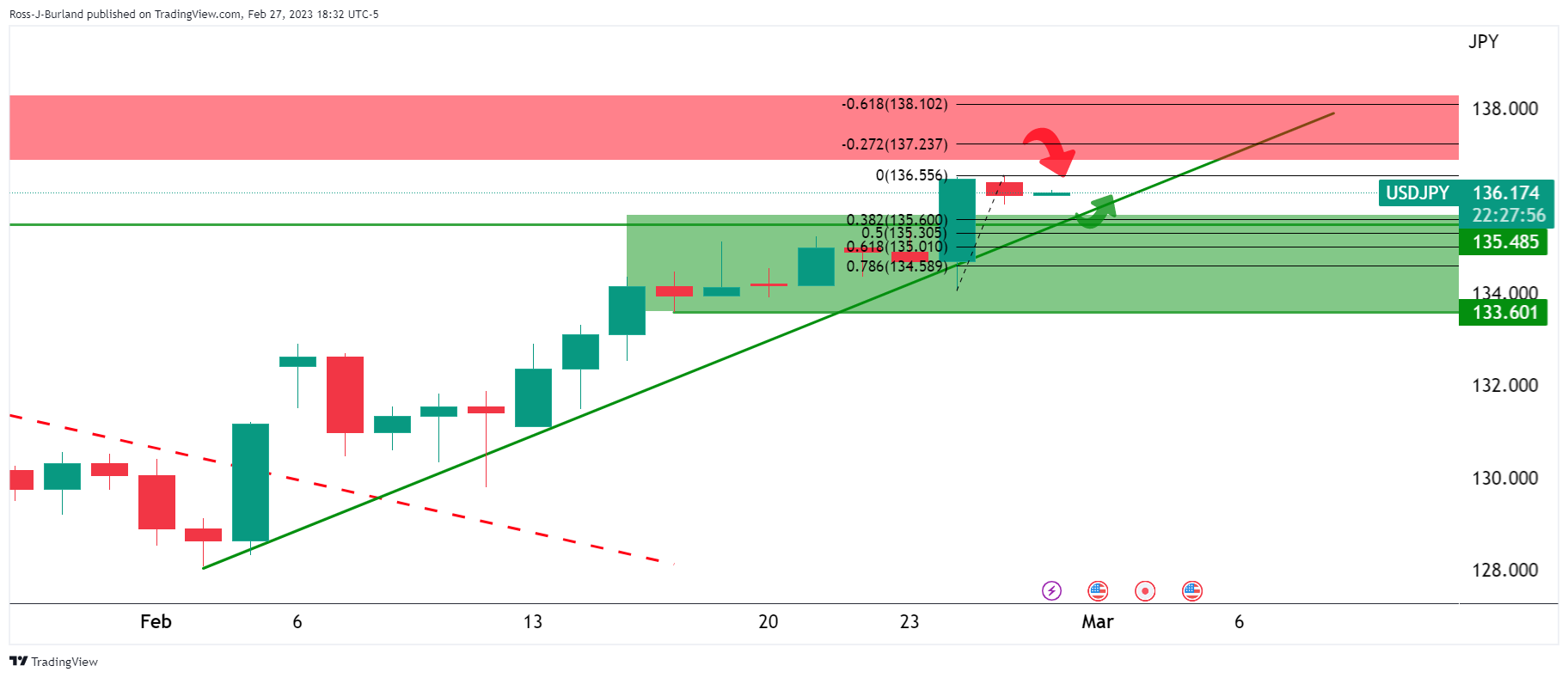
The price can remain in the hands of the bulls but there are risks of a long squeeze for the days ahead. If the bears get below 135.50 and then 134, 132.50 will be eyed:

- Oil price looks exposed to recapture the $76.00 resistance ahead of Caixin Manufacturing PMI data.
- Caixin Manufacturing PMI is expected to jump to 50.2 from the former release of 49.2.
- BofA sees the terminal rate for the Fed above 6% amid resilience in the demand-drive inflation.
West Texas Intermediate (WTI), futures on NYMEX, have extended their recovery above the immediate resistance of $75.80 in the early Asian session. The oil price is exposed to the critical resistance of $76.00 as investors are optimistic about the release of the Caixin Manufacturing PMI data, which is scheduled for Wednesday.
Caixin Manufacturing PMI is expected to jump to 50.2 from the former release of 49.2. It is widely anticipated that the Chinese economy will outperform this year after three years of a strict lockdown to contain the spread of Covid-19. Chinese officials are dedicated to spurting overall growth through monetary and fiscal support as reopening measures require sufficient stimulus to infuse optimism in firms and households.
A report released by the People’s Bank of China (PBoC), this week, claimed a rebound in the Chinese economy in 2023 as epidemic prevention has relaxed and consumption has improved. The report also conveys that the vision of the PBoC is not limited to the expansion of domestic demand but is widened to longer-term economic growth and price stability.
Meanwhile, fears of more rates by the Federal Reserve (Fed) as its current monetary policy doesn’t look sufficient enough to bring down inflation, will keep the oil price on the tenterhooks. Analysts at Bank of America (BofA) expect Fed chair Jerome Powell to announce three more rate hikes this year considering the resilience in the demand-driven inflation. The BofA sees the terminal rate above 6% and recession appears more likely than a soft landing.
On Tuesday, the release of the oil inventories data by the United States American Petroleum Institute (API) will keep the oil price in action. Last week, the US agency reported a huge build-up of oil stockpiles by 9.89 million barrels.
- NZD/USD struggles to defend the week-start bounce off three-month low.
- Bullish candlestick formation, oversold RSI underpin recovery hopes.
- Three-week-old descending resistance line, previous support from November add to the upside filters.
NZD/USD seesaws around 0.6160-65 amid early Tuesday, following a week-start bounce off the lowest level since November.
In doing so, the Kiwi pair jostles with the 200-DMA hurdle after posting a bullish candlestick on the daily chart, namely the Dragonfly Doji.
Not only the upbeat candlestick formation but the oversold RSI (14) also suggests the NZD/USD pair’s upside past the immediate hurdle surrounding 0.6170.
The same highlights a downward-sloping resistance line from early February, around 0.6205 at the latest.
Following that, the 61.8% and 50% Fibonacci retracement levels of the pair’s run-up from late November 2022 to early February 2023, near 0.6245 and 0.6300 respectively, could challenge the NZD/USD buyers.
It’s worth noting that the previous support line from November 17, close to 0.6330 by the press time, acts as the last defense of the Kiwi bears.
Alternatively, a daily closing below the multi-day bottom marked on Monday, around 0.6130, will defy the bullish candlestick and can direct the NZD/USD sellers towards the mid-November swing low surrounding 0.6060.
It should, however, be observed that the Kiwi pair’s weakness past 0.6060 appears tough as multiple supports stand tall to challenge the sellers around the 0.6000 psychological manget.
NZD/USD: Daily chart

Trend: Limited recovery expected
- USD/CHF is likely to display a volatility contraction ahead of Swiss GDP and US Manufacturing PMI data.
- The Swiss Franc asset has struggled in extending recovery above the horizontal resistance placed around 0.9410.
- A slippage from the RSI (14) into the 40.00-60.00 range indicates a loss in the upside momentum.
The USD/CHF pair is building an intermediate cushion around 0.9350 after a steep correction from above 0.9420 in the early Tokyo session. The Swiss franc asset is expected to turn sideways ahead of the release of the Swiss Gross Domestic Product (GDP) (Q4) and United States ISM Manufacturing PMI data.
On an annualized basis, Swiss GDP is expected to report a contraction of 1.2% vs. an expansion of 0.5% released earlier. As per the consensus, the Swiss economy is expanded by 0.3% in Q4, higher than the 0.2% growth delivered in Q3.
The US ISM Manufacturing PMI is expected to improve to 48.0 from the former release of 47.4. A figure below 50.0 is considered a contraction in activities. Therefore, it would be worth calling it a decline in contraction.
A rebound in the risk appetite of the market participants resulted in a revival for S&P500 after diving last week. The US Dollar Index (DXY) is expected to display a volatility contraction around 104.20.
USD/CHF has corrected after struggling to extend recovery above the horizontal resistance placed from January 6 high around 0.9410. Earlier, the Swiss Franc asset delivered a breakout of the resistance plotted from January 31 high at around 0.9290, which resulted in a bullish reversal. The major is expected to display a volatility contraction pattern before printing a fresh upside.
Advancing 20-and 50-period Exponential Moving Averages (EMAs) at 0.9361 and 0.9316 respectively, add to the upside filters.
The Relative Strength Index (RSI) (14) has slipped into the 40.00-60.00 range from the bullish range of 60.00-80.00, which indicates a loss in the upside momentum.
For a fresh upside, the asset needs to deliver a break above February 27 high at 0.9429, which will drive the major toward December 6 high at 0.9456 followed by November 25 high around 0.9500.
In an alternate scenario, a breakdown below February 9 low at 0.9161 will drag the asset toward the round-level support at 0.9100. A slippage below the latter will drag the asset toward the February low at 0.9059.
USD/CHF four-hour chart
-638131361339434439.png)
- EUR/USD fades bounce off seven-week low ahead of second-tier US data.
- Mixed US statistics, month-end positioning allowed Euro bears to take a breather.
- Firmer sentiment, pullback in yields offered additional support to the recovery moves.
- Cautious mood, hawkish Fedspeak challenge recovery moves.
EUR/USD seesaws around 1.0600 during early Tuesday, after bouncing off a seven-week low to post the biggest daily gains in more than three weeks. In doing so, the major currency pair seeks fresh direction to extend the week-start rebound amid mixed catalysts and a light calendar.
On Monday, the US Dollar Index (DXY) snapped a four-day uptrend while reversing from the highest levels in nearly two months on mixed data, as well as a lack of major negatives for the sentiment. In doing so, the greenback’s gauge paid little heed to the ongoing Russia-Ukraine tensions and hawkish Federal Reserve (Fed) concerns, while tracing the Treasury bond yields.
That said, US Durable Goods Orders slumped -4.5% in January versus -4.0% expected and 5.1% prior. However, the Nondefense Capital Goods Orders ex Aircraft grew 0.8% versus 0.0% analysts’ expectations and -0.3% previous readings. On the same line, the US Pending Home Sales rallied 8.0% MoM versus 1.0% expected and 1.1% prior.
At home, data published by the European Commission revealed that the Economic Sentiment Indicator in the Euro area edged lower to 99.7 in February from 99.8 in January, compared to analysts' estimate of 101.
The US data triggered the much-needed pullback in the US Treasury bond yields as the benchmark 10-year coupon dropped three basis points (bps) to 3.92% after a five-week uptrend while the two-year counterpart followed the suit by retreating from a three-month high to 4.78%.
It’s worth noting that US National Security Advisor Jake Sullivan said on CNN’s “State of the Union,” China’s stance on the Russian invasion of Ukraine puts it in an “awkward” position internationally and any weapons support to Russia would come with “real costs.”
Elsewhere, Federal Reserve Governor Philip Jefferson said on Monday that it is important to get back to 2% inflation to allow those sorts of sustained economic gains. Reuters also portrayed hawkish Fed concerns while saying, “Economic data this month reflected still tight jobs markets and inflation remaining sticky, leading Fed funds futures traders to bet on higher rates, which in the US are now seen peaking in September at 5.4%, up from 4.58% now.”
Amid these plays, Wall Street closed on the positive side but failed to post major gains amid month-end moves.
It should be observed that the latest headlines suggesting the easing stance of the US towards China seem to have helped the S&P 500 Futures to track Wall Street benchmarks.
Moving on, US Conference Board’s Consumer Confidence, Chicago Purchasing Managers’ Index and Richmond Fed Manufacturing Index for February, as well as the preliminary US trade numbers for January, will be important for immediate directions.
Technical analysis
A clear rebound from the 200-day Exponential Moving Average (EMA), around 1.0530, followed by a successful break of the two-week-old descending trend line, now immediate support near 1.0585, keeps EUR/USD buyers hopeful.
- The AUD/JPY trades sideways, within a busy area surrounded by all the daily Moving Averages.
- AUD/JPY Price Analysis: Range-bound within the 91.57-89 area.
The AUD/JPY fluctuates as the Asian session begins, registering minuscule gains of 0.07%, exchanging hands at around 91.73. A risk-on impulse bolstered the Australian Dollar(AUD), while the Bank of Japan’s (BoJ) newly appointed Governor Kazuo Ueda’s dovish comments were a headwind for the Japanese Yen (JPY).
With the AUD/JPY bottoming around the 91.30 area in the last couple of days, price action is contained within the confluence of all the daily Exponential Moving Averages (EMAs) around the 91.57-89 area. Furthermore, the AUD/JPY is trading sideways as the Relative Strength Index (RSI) shifts flat, meaning buyers and sellers are at equilibrium.
If the AUD/JPY clears the top of the range, the next resistance would be 92.00. A breach of the latter will expose the February 21 high at 93.00, followed by the December 13 high at 93.35. Once reclaimed, the AUD/JPY’s next stop would be the psychological 94.00 barrier.
As an alternate scenario, sellers would exert downward pressure on the pair if the AUD/JPY clears a one-month-old upslope support trendline. The AUD/JPY first support would be the 91.00 figure. Break below, and the pair would fall toward the February 10 swing low at 90.22 and then the 90.00 psychological level.
AUD/JPY Daily chart

AUD/JPY Key technical levels
“Central banks must remain on guard against the potential dangers of secular stagnation and low inflation as price rises driven by cost-push factors do not last long,” Bank of Japan (BoJ) Deputy Governor Masazumi Wakatabe said on Monday per Reuters.
Key comments
Japan's economy was in deflation for a prolonged period, but sustainable monetary easing has ‘certainly had a positive effect’ on the real economy.
The mild-inflation regime has not come to an end, and we should say that the potential dangers of secular stagnation and Japanification have not yet passed.
While inflation has recently accelerated across the globe, many of the factors pushing up prices are driven by higher costs such as the war in Ukraine.
When an exogenous shock occurs, there is an adjustment from the old to a new price system. After adjustment, the rising inflation rate is likely to return to the steady-state inflation rate.
So the important point is how this rate is affected. Of course, it is possible that cost-push factors will remain, but whether they will push up the steady-state inflation rate is uncertain.
(It was) Well known that cost-push inflation does not last long.
USD/JPY awaits Tokyo open
Given the late Monday’s commentary from a prominent BoJ official, the USD/JPY price should have acted positively, considering the talks in favor of the easy money policy. However, the Yen pair remains inactive at around 136.20 by the press time of early Tuesday in Asia, after retreating from a two-month high the previous day.
“Despite fraying relations with Beijing, US President Joe Biden is expected to forego expansive new restrictions on American investment in China, denying a push by some hawks in his administration and in Congress,” reported Politico on Monday.
The news quotes five anonymous people on Capitol Hill and K Street with knowledge of the White House discussions while stating that US President Biden is scaling back a planned executive order to oversee American investments in China to focus largely on increasing transparency of those deals.
Key quotes
The order may still prohibit U.S. investments in at least one Chinese industry - advanced semiconductors - but will likely not block money from flowing to other parts of China’s high-tech economy.
The order is now expected to largely require U.S. firms to notify federal authorities when doing deals in industries like quantum computing and artificial intelligence, though some other investment prohibitions are being debated.
Though the final order is still in flux, the administration is likely to set up a pilot program under which US firms doing new deals with Chinese artificial intelligence and quantum computing firms would have to disclose details to government authorities.
The debate will now turn to the Senate, where the Banking Committee will hold a hearing Tuesday on sanctions, export controls and “other tools” like outbound investment screening.
AUD/USD grinds higher past 0.6700
The news offers an additional reason for the AUD/USD pair to extend the week-start rebound. However, the cautious mood ahead of Australia Retail Sales for January seems to probe the Aussie pair buyers around 0.6730 at the latest.
- AUD/USD has sensed heat in stretching its recovery above 0.6750 as the risk appetite theme has not strengthened enough.
- A decline in the monthly inflationary pressures will provide relief to the RBA.
- The contraction in the US Manufacturing PMI is likely to trim ahead amid a recovery in the overall demand.
The AUD/USD pair has sensed pressure in stretching its recovery above the immediate resistance of 0.6740 in the early Tokyo session. The risk appetite theme has witnessed a decent interest, however, it is not strong enough to fuel risk-sensitive assets for vertical moves. The Australian Dollar is subjected to display sheer volatility ahead as investors are awaiting the release of Australia’s Gross Domestic Product (GDP) data, which will release on Wednesday.
The street is anticipating a decent growth in the scale of economic activities by 0.7% in the fourth quarter of CY2022, higher than the 0.6% price in Q3. On an annualized basis, the Australian GDP is expected to display the growth of 2.7% vs. the former release of 5.9%. It seems that the restrictive monetary policy offered by the Reserve Bank of Australia (RBA) has barricaded firms from accelerating output.
Apart from the Australian GDP data, monthly Consumer Price Index (CPI) numbers will be keenly watched. The monthly CPI (Jan) is seen lower at 7.9% from the former release of 8.4%. A decline in the monthly inflationary pressures will provide relief to RBA Governor Philip Lowe and other policymakers, which are worried about Australia’s sticky inflation.
S&P500 showed a recovery move on Monday after a bearish week as investors shrugged off the consequences of higher rates by the Federal Reserve (Fed). The recession fears in the United States have eased dramatically amid robust consumer spending due to strong wage gains. The US Dollar Index (DXY) is likely to remain sideways as investors are shifting their focus toward the release of the United States ISM Manufacturing PMI (Feb) data, which is scheduled for Wednesday.
The economic data is expected to improve to 48.0 from the former release of 47.4. A figure below 50.0 is considered a contraction in activities. Therefore, it would be worth calling it a decline in contraction. The New Orders Index that conveys forward demand is expected to rebound to 43.7 from the prior figure of 42.5.
- Gold price struggles with one-week-old previous support after snapping five-day downtrend on week-start.
- Mixed United States data, month-end positioning allow XAU/USD bears to take a breather.
- Hawkish Federal Reserve (Fed) concerns, overall US Dollar strength amid geopolitical fears, higher rate expectations probe Gold buyers.
Gold price (XAU/USD) struggles to defend the week-start rebound around $1,817, flirting with a short-term technical resistance, as the metal traders await more clues amid month-end positioning. That said, the bullion buyers cheered a pullback in the United States Treasury bond yields and the US Dollar to portray an upbeat Monday despite looming geopolitical fears and the hawkish bias of the Federal Reserve (Fed) officials. The reason could be linked to the mixed US data and month-end moves.
Gold price rose on softer United States Treasury bond yields
On Monday, the United States Treasury bond yields paused a multi-week-old upward trajectory amid mixed US data and the market’s wait for stronger clues to confirm the hawkish Federal Reserve (Fed) bias.
That said, US Durable Goods Orders slumped -4.5% in January versus -4.0% expected and 5.1% prior. However, the Nondefense Capital Goods Orders ex Aircraft grew 0.8% versus 0.0% analysts’ expectations and -0.3% previous readings. On the same line, the US Pending Home Sales rallied 8.0% MoM versus 1.0% expected and 1.1% prior.
The data triggered the much-needed pullback in the US Treasury bond yields as the benchmark 10-year coupon dropped three basis points (bps) to 3.92% after a five-week uptrend while the two-year counterpart followed the suit by retreating from a three-month high to 4.78%.
Geopolitical fears, hawkish Federal Reserve concerns remain intact
Mixed United States data and a pullback in the Treasury bond yields seem to fail in conveying the market’s fears surrounding the Ukraine-Russia war, especially after China’s dual show of having ties with Russia and flaunting a 12-point peace place for Ukraine. On Monday, US National Security Advisor Jake Sullivan said on CNN’s “State of the Union,” China’s stance on the Russian invasion of Ukraine puts it in an “awkward” position internationally and any weapons support to Russia would come with “real costs.”
Elsewhere, Federal Reserve Governor Philip Jefferson said on Monday that it is important to get back to 2% inflation to allow those sorts of sustained economic gains.
US Dollar pullback adds strength to XAU/USD rebound
US Dollar traces the retreat in the US Treasury bond yields and a month-end positioning to allow the US Dollar bulls to take a breather. It should be noted that the Wall Street benchmarks closed with mild gains but failed to impress the US Dollar traders.
That said, the US Dollar Index (DXY) snapped a four-day uptrend to retreat from the seven-week high, to 104.65 by the press time. The DXY pullback allowed the Gold price to print 0.35% intraday gains as it pokes the $1,820 hurdle.
Moving on, second-tier United States economics, like the Conference Board’s Consumer Confidence and some activity numbers from Chicago and Richmond Fed, could entertain the Gold traders. However, major attention will be given to the qualitative catalysts.
Gold price technical analysis
Gold price broke a four-day-old descending resistance line, now support around $1,809, to portray the first daily gain in six. The recovery moves currently jostle with a one-week-long support-turned-resistance of around $1,820.
Given the bullish signals from the Moving Average Convergence and Divergence (MACD) indicator and the upbeat but not overbought Relative Strength Index (RSI) line, placed at 14, the XAU/USD is likely to extend the latest rebound past the $1,820 hurdle.
However, a convergence of the 100-Hour Moving Average (HMA) and the aforementioned bearish channel’s upper line, close to $1,831, appears the key for the Gold buyers to cross before retaking control.
Alternatively, the downside break of the immediate resistance-turned-support line near $1,809 could quickly drag Gold price towards the $1,800 threshold.
Following that, the bearish channel’s bottom line, close to $1,790 at the latest, can challenge the XAU/USD bears.
Overall, Gold is likely to pare recent losses but the overall trend remains bearish.
Gold price: Hourly chart
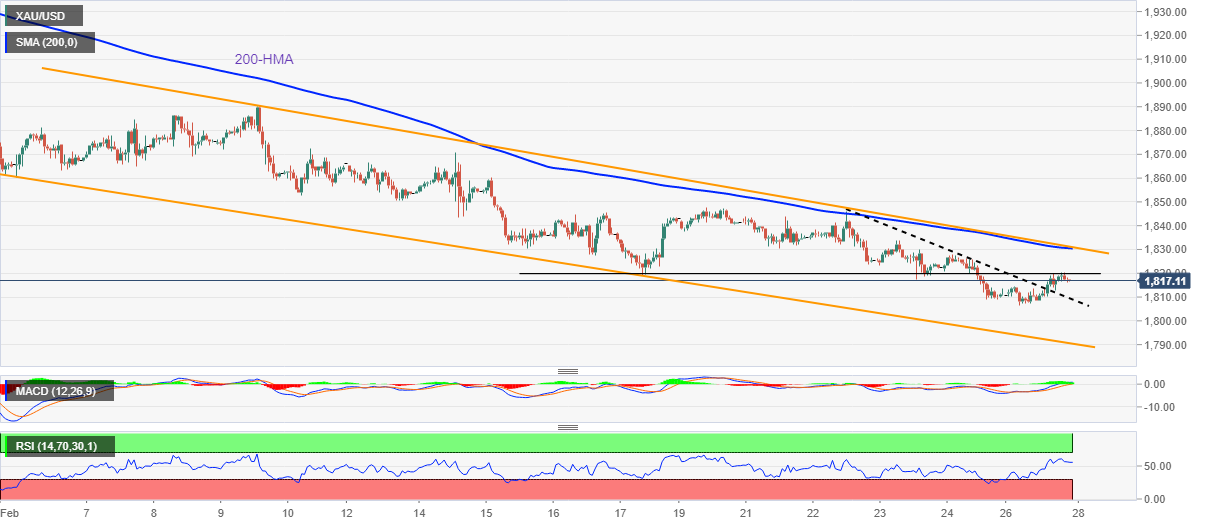
Trend: Limited recovery expected
- USD/CAD is advancing towards 1.3600 as USD Index has found an intermediate cushion around 104.20.
- Lower advance orders for the US durable goods indicate that core CPI could soften ahead.
- The oil price is expected to remain volatile ahead of the release of the oil inventories data by the US API.
The USD/CAD pair is approaching the round-level resistance of 1.3600 in the early Asian session. The Loonie asset is in a sideways auction after a responsive buying move from 1.3540 as the US Dollar Index (DXY) finds an intermediate cushion around 104.20 after a sheer decline. The US Dollar witnessed an intense sell-off on Monday as investors ignored the fears of further rate hikes by the Federal Reserve (Fed) and shifted to the risk-perceived assets.
S&P500 settled Monday’s session with moderate gains as investors digested the fact that more rates by the Fed cannot be ruled out as the battle against stubborn inflation is getting more furious now. An improved risk appetite of the market participants barricaded the USD Index from hitting the 105.00 resistance and dragged it to near 104.20.
The demand for US government bonds increased a little, which resulted in a marginal drop in the yields offered by the 10-year US Treasury bonds to near 3.92%.
The catalyst that impacted the USD Index was the higher-than-anticipated contraction in the United States Durable Goods Orders data. The economic data was contracted by 4.5% while the street was expecting a contraction of 4.0%. Lower advance orders for durable goods indicate that the core Consumer Price Index (CPI) that excludes oil and food prices could soften ahead.
On Tuesday, the Canadian Dollar will dance to the tunes of Canada’s Gross Domestic Product (GDP) data. Analysts at Wells Fargo expect Canada's GDP release to show that the economy remained resilient in the last quarter of 2022, with quarterly GDP (annualized) growth of 1.6% in Q4-2022. Heading into 2023, however, analysts expect that growth trends may begin to downshift. We forecast a mild recession in Canada in the first half of 2023.
Meanwhile, oil prices have shown a recovery move after finding support around $75.00. The oil price is aiming to extend its recovery above the immediate resistance of $75.80. The oil price is expected to remain volatile ahead of the release of the oil inventories data by the US American Petroleum Institute (API) for the week ending February 24.
- EUR/JPY is trading at new year-to-date highs above 144.50.
- EUR/JPY Price Analysis: It’s upward biased; in the near term, it might test 145.00.
The EUR/JPY rallies to fresh 2023 highs around 144.54 and is set to extend its gains, past solid resistance around the November 30 daily high of 144.85. At the time of writing, the EUR/JPY is trading at 144.49, above its opening price by 0.49%.
The daily candlestick chart portrays the EUR/JPY as upward biased. As of typing, the cross is piercing a four-month-old downslope resistance trendline, which, if broken, would keep bulls hopeful of driving prices higher. The Relative Strength Index (RSI) supports a bullish continuation, while the Rate of Change (RoC) witnessed a jump in volatility that favors the bulls.
Given the backdrop, the EUR/JPY’s first resistance would be the 145.00 psychological level. A breach of the latter will expose the December 20 daily high at 145.83, closely followed by the 146.00 figure, followed by the December 15 high at 146.72.
As an alternate scenario, the EUR/JPY's first demand zone would be the February 21 high of 144.16, which, once cleared and the EUR/JPY would easily be dragged to the 144.00 mark. If sellers surpassed that area, the 20-day Exponential Moving Average (EMA) at 142.60 would be in play, but first sellers need to clear 143.00.
EUR/JPY Daily chart

EUR/JPY Key technical levels
- GBP/USD bears on the lookout for a break of head and shoulders neckline support.
- Bulls eye a move to test trendline resistance.
GBP/USD could be on the verge of a move higher but a retest of the prior resistance could also be in order. The bears are seeking a break of a key daily support structure while the bulls are relying on a move to test trendline resistance.
GBP/USD daily chart
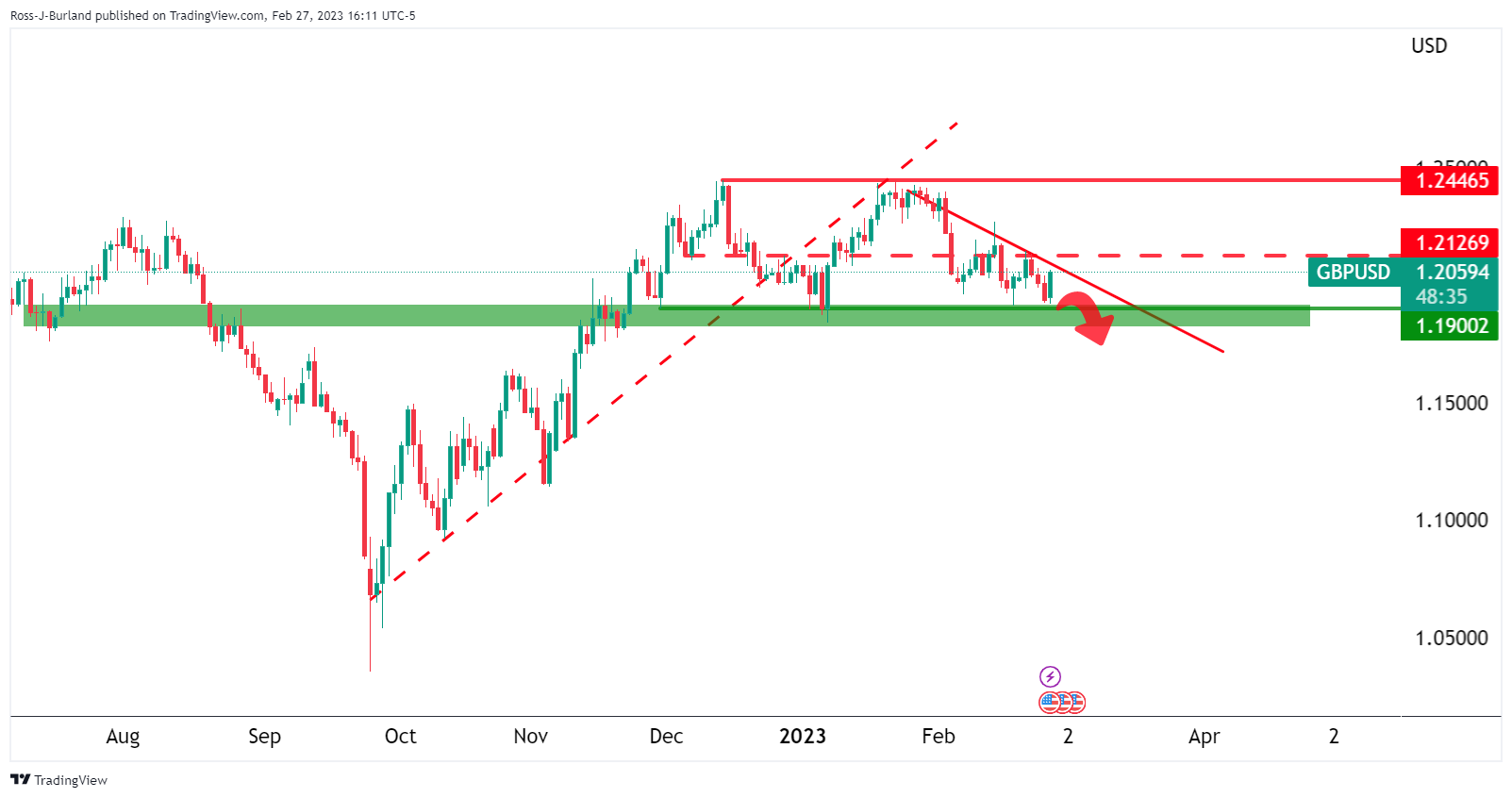
On a break of daily support, 1.1900, the bias will be on the downside with the price below trendline resistance. This would mark a bearish head and shoulders with the price below the neckline.
GBP/USD H1 chart
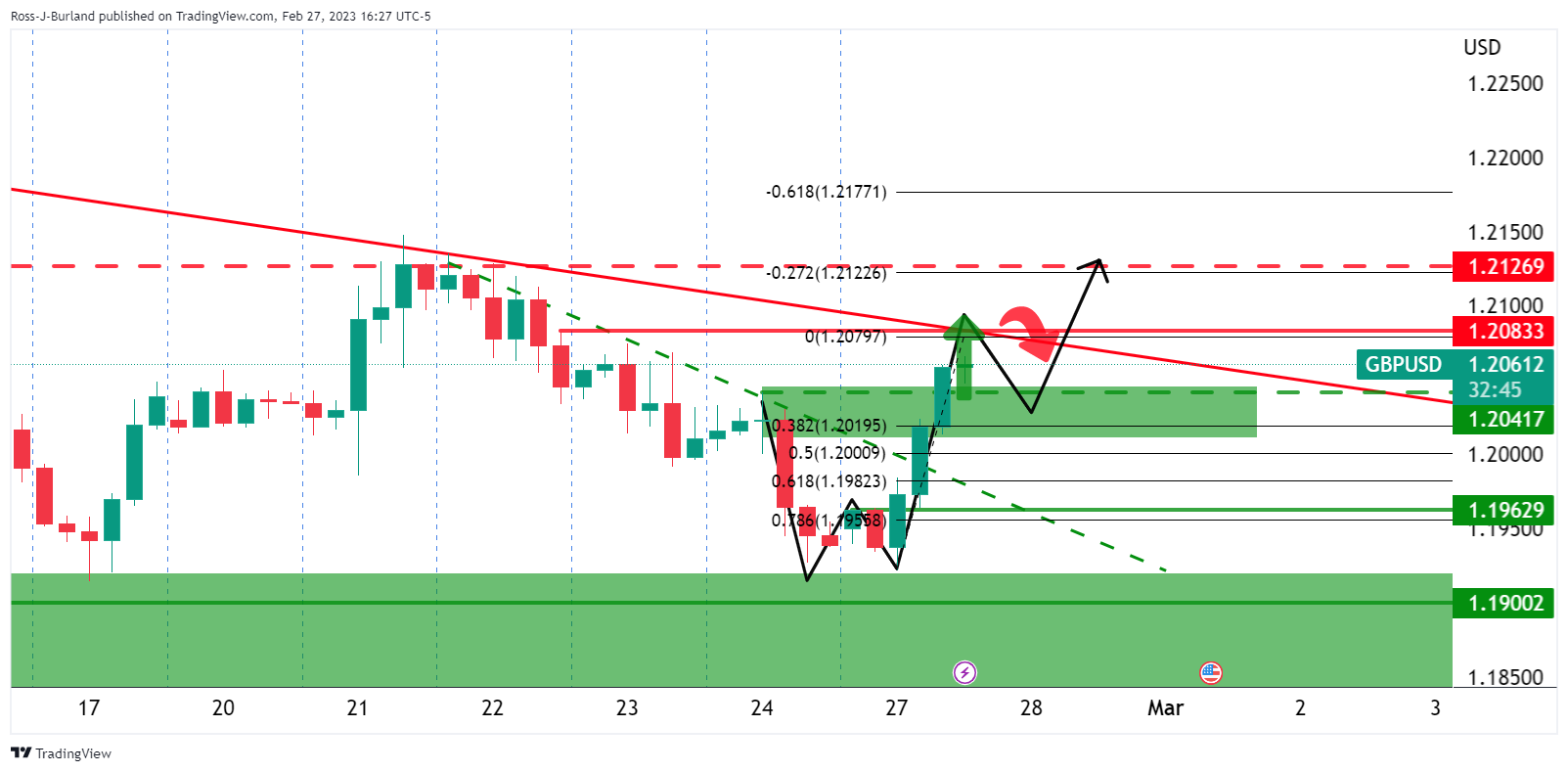
However, in the meantime, there is a bias to the upside with the 1.2080s in reach. This will take the pair up to test the trendline resistance but the W-formation is also compelling. A retest of the prior resistance could see the bulls emerge again and equate to an area of support between 1.2050 and 1.2000. Lower down the Fibonacci scale, the 78.6% aligns with the neckline of the formation near 1.1960.
- NZD/USD bulls come up for air as the US Dollar gives back some ground.
- A triangle is a bearish feature on the hourly chart but that does not invalidate the bullish corrective bias.
NZD/USD is attempting to make a comeback from Friday's sell-off which was a continuation of the bearish cycle from the 0.65s printed at the turn of the month. The pair have traded between a low of 0.6131 and a high of 0.6179 with sights set on a break into the 0.62s for the days ahead.
Analysts at ANZ Bank argued that the price action was mostly noise, but said ''the bounce in equities and risk appetite did see the USD DXY slip back.''
''We may well see more volatility into month end given that US asset markets were one of the poorer performers (implying that rebalancing flows into USD),'' the analysts said. ''But that depends on how today goes.''
''Meanwhile, in the background, a 3-way tug-of-war of NZD views is playing out between those citing rebuild activity, those concerned about the disruption to exports and impact on Crown finances, and those expecting a USD rebound. So, it’s a bit messy,'' the analysts added.
The US Dollar has been out in front for several days based on the script being flipped with regard to the narrative surrounding the Federal Reserve. However, data on Monday put a halt on a slew of inflationary positive data which enabled a correction to occur in risk appetite, which has been so far supportive of the Kiwi to start the week.
The US data on Friday showed US consumer spending increased by the most in nearly two years in January, while inflation accelerated, adding to market fears the Fed could continue raising interest rates. However, today's Commerce Department's Durable Goods report, which covers everything from air fryers to helicopters, showed a whopping 54.6% plunge in commercial aircraft/parts. This led to the US-made merchandise numbers falling by 4.5% in January, steeper than the 4.0% decline analysts expected and a reversal from December's downwardly revised 5.1% increase and the greenback dropped heavily.
More important US data coming up
For the meanwhile, traders will instead be looking to the ISM surveys. Data already released point to a rebound for the ISM mfg index in Feb following five months of consecutive declines that saw the series drop to a post-Covid low of 47.4 in Jan, analysts at TD Securities said.
''Separately, we look for the ISM services index to stabilize around its current level after the notable Dec-Jan zigzag in the series. We might revise our projection as more data is released next week.''
NZD/USD technical analysis

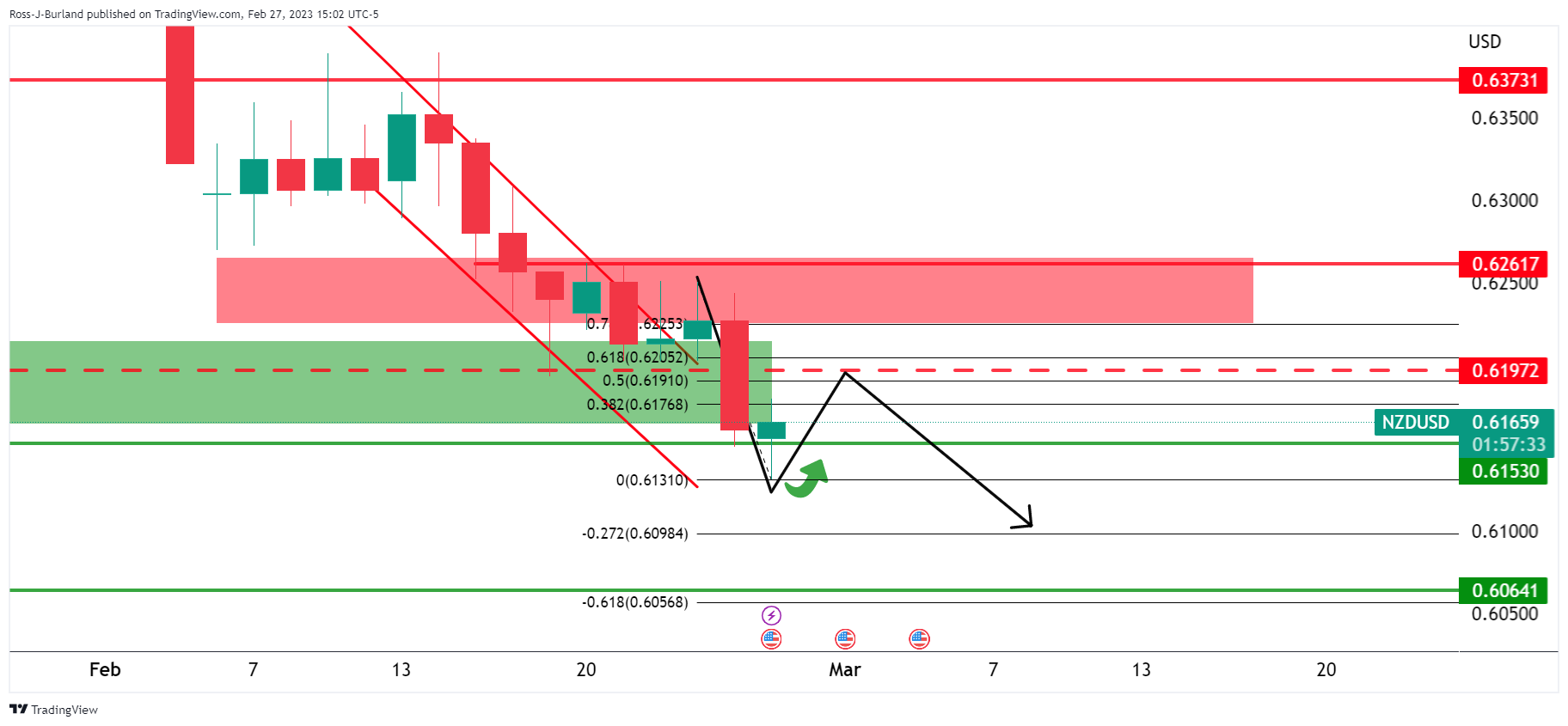
The price is accumulating bids near 0.6150 is what is regarded as a support area. If this were to continue, then there will be prospects of a move towards the prior structure near 0.6200 for the days ahead:
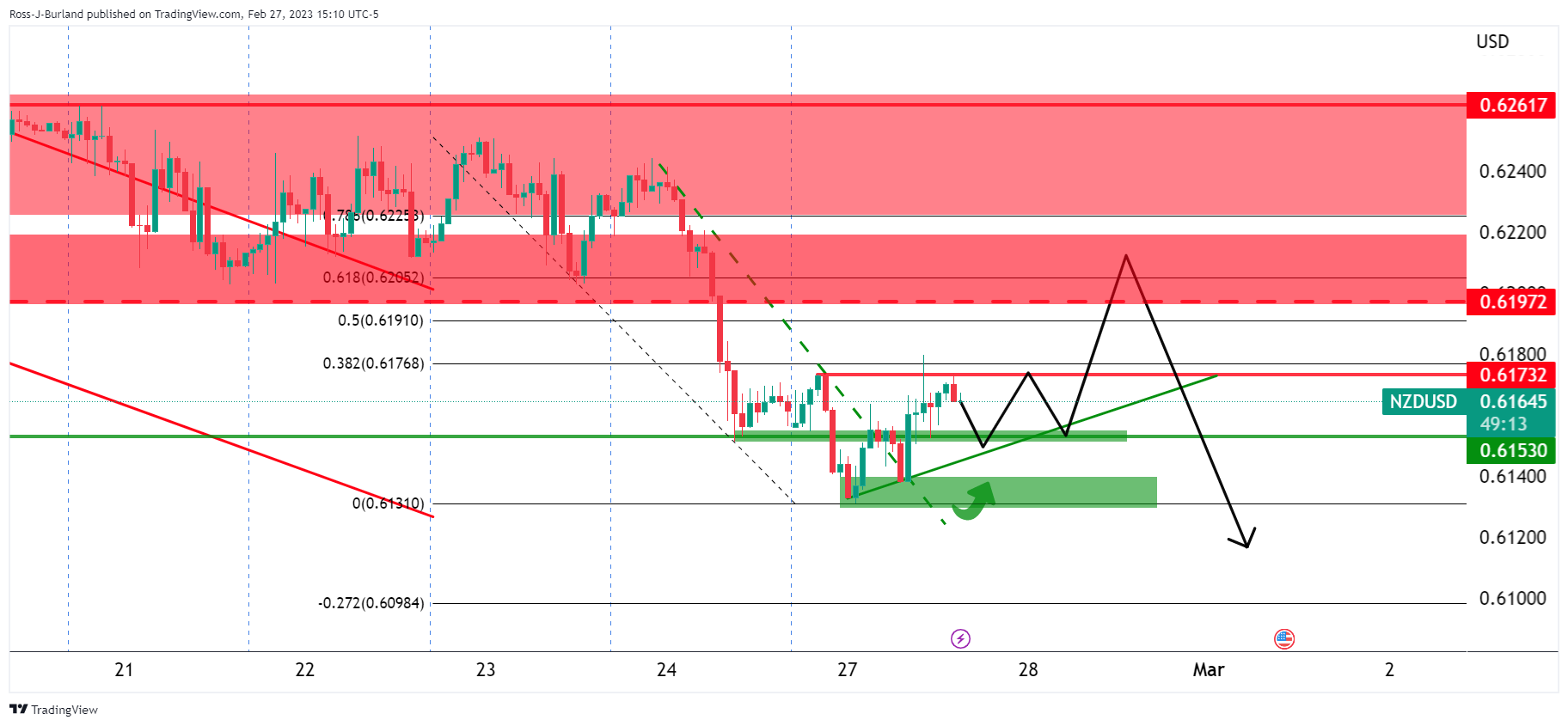
The triangle is a bearish feature on the hourly chart but that does not invalidate the bullish corrective bias until the fact. 0.6150 is key in this regard.
What you need to take care of on Tuesday, February 28:
The US Dollar started the week extending its positive momentum from last week, although demand for the American currency faded ahead of the US opening, following a mixed United States Durable Goods Orders report. US Durable Goods Orders fell by 4.5% MoM in January, worse than anticipated, although the core reading was slightly better than anticipated. Pending Home Sales, on the other hand, rose 8.1% in the same month, beating expectations.
Meanwhile, European Central Bank officials repeated their hawkish rhetoric, reaffirming a 50 bps rate hike in March. Their US Federal Reserve counterparts, also lifted the bets, claiming they will do more if inflation does not come back down.
Overall, market players seemed a bit more relaxed, but inflation and growth concerns continue to affect the market mood.
The EUR/USD pair recovered the 1.0600 threshold, as despite poor US figures, Wall Street ended the day with gains. The positive tone of equities weighed on the Greenback.
The UK and the EU have agreed to amend the Northern Ireland protocol. In a joint press conference with European Commission President Ursula von der Leyen on Monday, British Prime Minister Rishi Sunak announced a new "Windsor framework," a decisive breakthrough to end uncertainty in Northern Ireland. The deal still needs to be approved but helped GBP/USD to remain afloat, with the pair currently trading around 1.2050.
AUD/USD flirted with the 0.6700 level, bouncing to end the day pretty much unchanged around 0.7635. Australian Retail Sales are coming up early Tuesday. The USD/CAD pair is down to 1.3580, while USD/JPY ended the day with modest losses around 136.20
Gold trades below $1,820 a troy ounce after falling to a fresh 2023 low of $1,806.52. Crude oil prices edged lower, with WTI now trading at $75.65 a barrel.
XRP staking to catalyze the next Ripple bull run?
Like this article? Help us with some feedback by answering this survey:
- EUR/USD could be an attractive play for the bulls.
- Asian shorts could set up the day for London traders as a buy-low opportunity.
EUR/USD has come up from the lows in a sharp correction at the start of the week and leaves the focus on a continuation for the days ahead with 1.0700 eyed on a break of 1.0650 and 1.0670.
EUR/USD daily chart
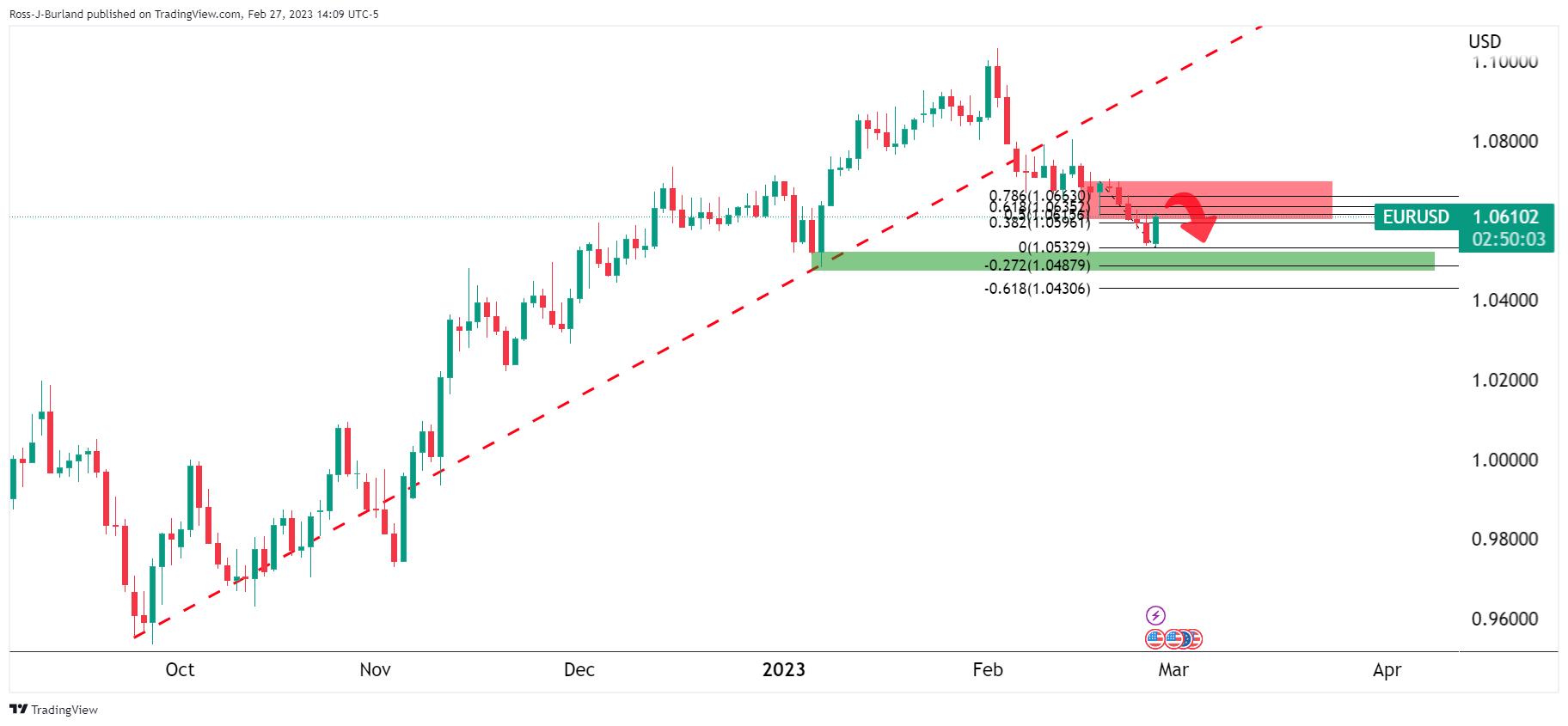
The price has found demand near 1.0550 and while still on the front side of the bearish trend, the bias remains bearish. However, a correction into the latest bearish impulse is already underway:

This might only be premature in the correction and this could offer a buy-low opportunity for bulls in the coming sessions in anticipation of a test of the trendline resistance.
EUR/USD H1 chart
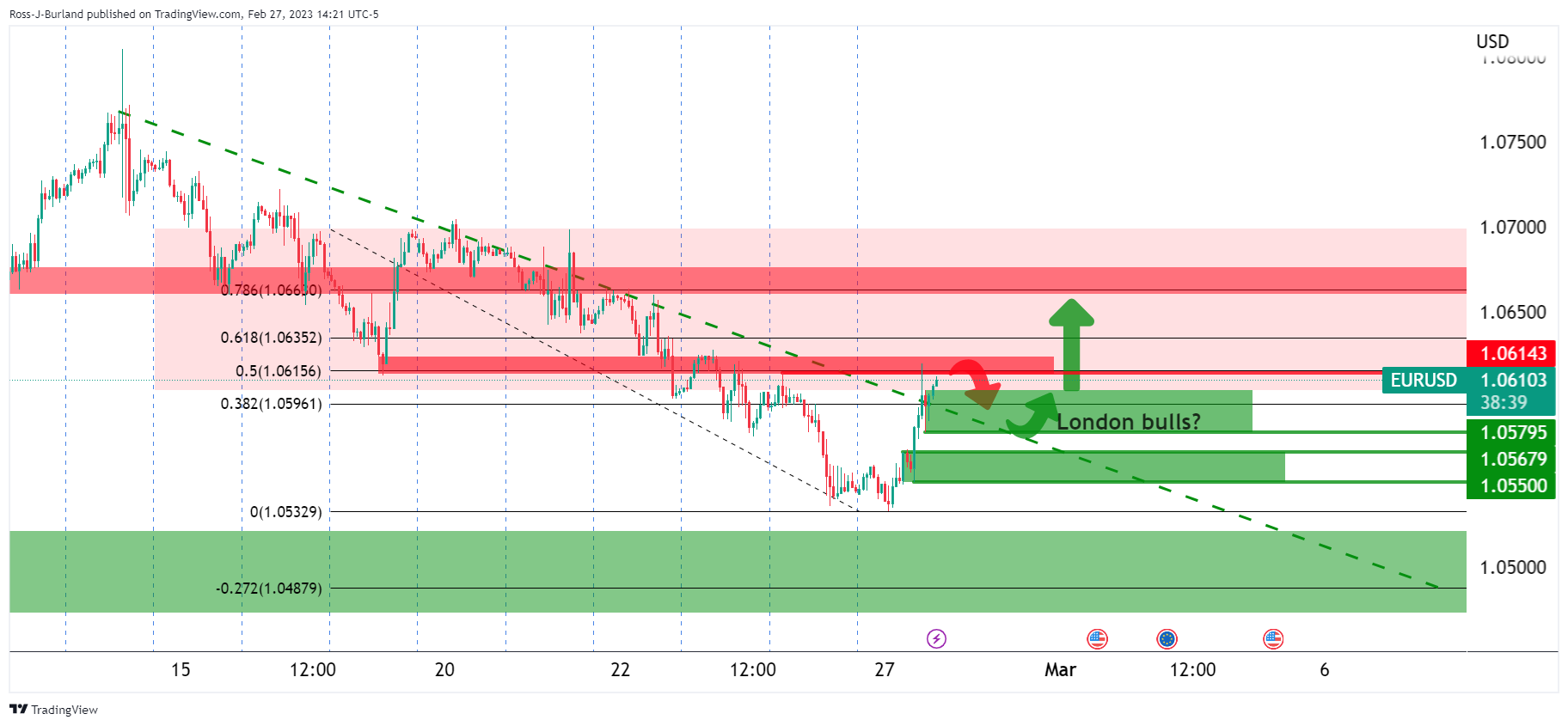
EUR/USD could be an attractive play for the bulls if enough of a discount is awarded from what would now be regarded as counter-trendline support as illustrated above. Asian shorts could set up the day for London traders as a buy-low opportunity.
- Silver price prolongs its losses to four consecutive days after slumping below the 200-DMA.
- Silver Price Analysis: A bearish continuation is likely, even though RSI is oversold; caution is warranted.
Silver price dropped to a fresh YTD low of $20.58 a troy ounce but has trimmed some of its losses. Even though the US Dollar (USD) remains soft and the US bond yields are down, the white metal is losing 0.14%. At the time of writing, the XAG/USD exchanges hands at $20.72.
From a daily chart perspective, the XAG/USD is downward biased. Furthermore, the 20-day Exponential Moving Average (EMA) is about to cross below the 200-day EMA, triggering a death cross and exacerbating a fall toward the next demand area, the November 3 daily low of $18.84. A breach of the latter would open the door for further downside, exposing crucial support zones. The critical support areas exposed would be October’s 14 low of $18.09, followed by September’s 28 at 17.97, ahead of last year’s low at $17.56.
Even though the path of least resistance is downwards, the Relative Strength Index (RSI) at oversold conditions could trigger consolidation before the bearish continuation.
As an alternate scenario, the XAG/USD first resistance would be the psychological $21.00 figure. Once reclaimed, bulls could drive prices towards the February 24 high at $21.39, followed by February 23 daily high at 21.67. Next, the 20/200-day EMAs intersection would be tested, around $21.90s.
XAG/USD Daily chart

XAG/USD Key technical levels
- US Dollar slides during a risk-on start to the US day on the back of US data bucking the trend.
- Gold price double bottom near the $1,800 psychological level is offering a compelling bullish case.
The Gold price is breaking the structure to the upside which could be paving the way for a buy-low opportunity for patient bulls for the sessions ahead. XAU/USD has come up from the Friday session lows of near $1,806 and has broken $1,814 structure, squeezing shorts with prospects of a prolonged squeeze for the week ahead with the January lows at $1,824 eyed.
Gold price bulls back in control
The Gold price pushed higher on Monday as the US Dollar was sold off in a risk-on environment as US data missed expectations, snapping a series of troublesome inflationary data from the US of late. The US Dollar index, DXY,
dropped to a low of 104.546 on the day after hitting a seven-week peak, making gold less expensive for overseas buyers. The DXY recovered some of the losses later in the morning but remains under pressure, sliding from recovery session highs at 104.83 and moving back into test 104.70 bullish commitments.
Federal Reserve expectations driving Gold price
Meanwhile, after hitting its highest since April 2022 this month, the Gold price has dropped by more than 7% after US data pointed to a resilient economy and Federal Reserve expectations flipped back to hawkish again.
''To state the obvious, the recent US data have come around to support our more hawkish view on the Fed, which in turn supports our call for a stronger dollar,'' the analysts at Brown Brothers Harriman said in a note. ''Market sentiment is finally swinging back in the US Dollar’s favor and we remain hopeful that the data continue to encourage this shift.''
For instance, the US data on Friday showed US consumer spending increased by the most in nearly two years in January, while inflation accelerated, adding to market fears the Fed could continue raising interest rates. However, today's Commerce Department's Durable Goods report, which covers everything from air fryers to helicopters, showed a whopping 54.6% plunge in commercial aircraft/parts. This led to the US-made merchandise numbers falling by 4.5% in January, steeper than the 4.0% decline analysts expected and a reversal from December's downwardly revised 5.1% increase and the greenback dropped heavily.
Nevertheless, worries about further interest rate hikes from the US Federal Reserve have kept bullion near a two-month low and WIRP suggests 25 bp hikes in March, May, and June are priced in that takes Fed Funds to 5.25-5.50%, the analysts at BBh warned.
''Right now, odds are running around 30% of a fourth hike in July but this should rise if the data continue to run hot. Strangely enough, an easing cycle is still expected to begin in Q4, albeit at much lower odds,'' the analysts added. ''Eventually, it should be totally priced out into 2024 in the next stage of Fed repricing. There are plenty of Fed speakers this week and we expect them to tilt heavily hawkish.''
-
Fed's Jefferson: Lower inflation without unecessary amount of disruption in job market possible
Speaking of which, Federal Reserve Governor Philip Jefferson said on Monday that it is possible for inflation to decline without an unnecessary amount of disruption in the job market, as reported by Reuters. However, he added that "inflation is too high and that is hard for people across the demographic spectrum."
All in all, this leaves the outlook data dependent and markets will need to wait for the Nonfarm Payrolls report a little longer than this week as it falls on the 2nd Friday of this month.
In the meanwhile, traders will instead be looking to the ISM surveys. Data already released point to a rebound for the ISM mfg index in Feb following five months of consecutive declines that saw the series drop to a post-Covid low of 47.4 in Jan, analysts at TD Securities said. ''Separately, we look for the ISM services index to stabilize around its current level after the notable Dec-Jan zigzag in the series. We might revise our projection as more data is released next week.''
Gold price technical analysis
As per the start of the week's analysis, it was stated that the US Dollar was up high and a correction would be anticipated for the initial balance to start the week:
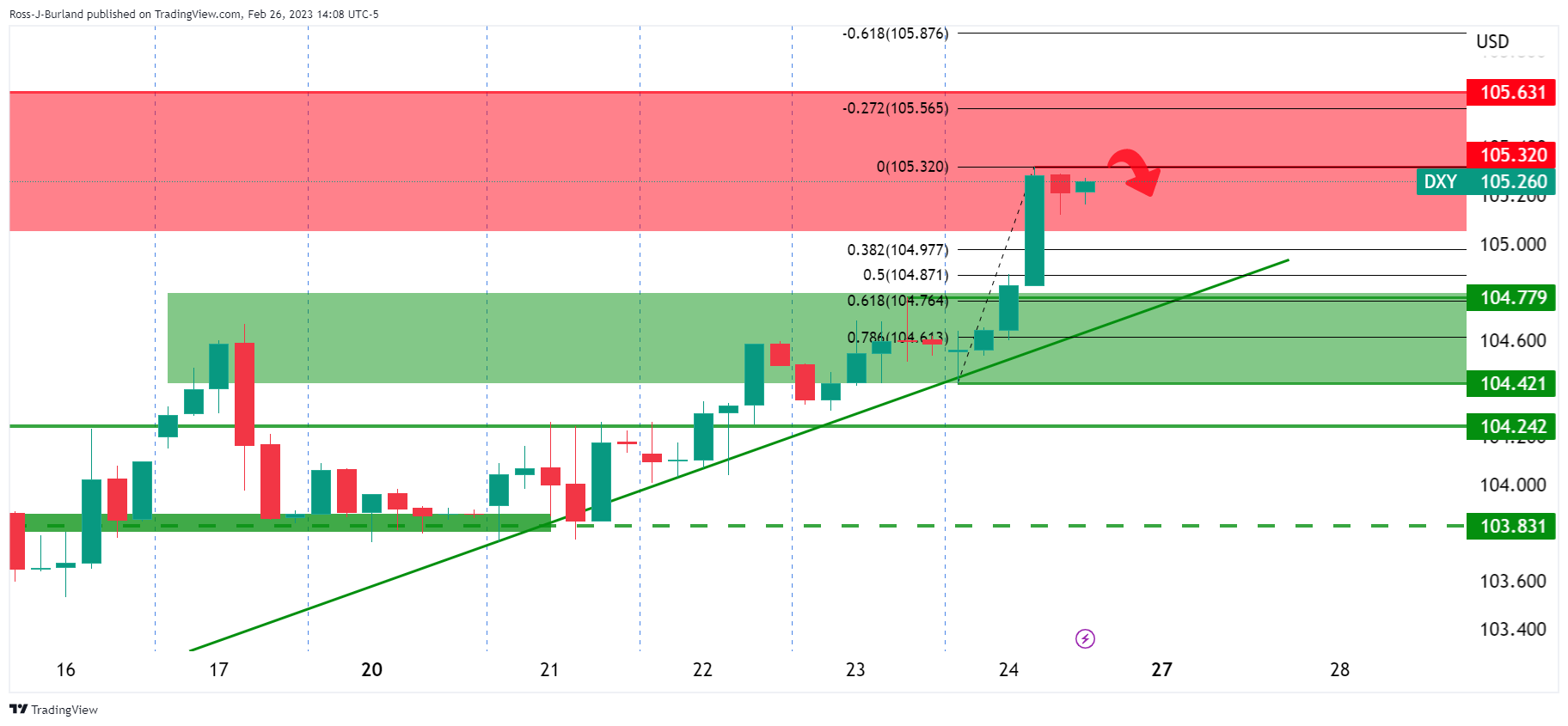
We have since seen that sell-off in DXY:
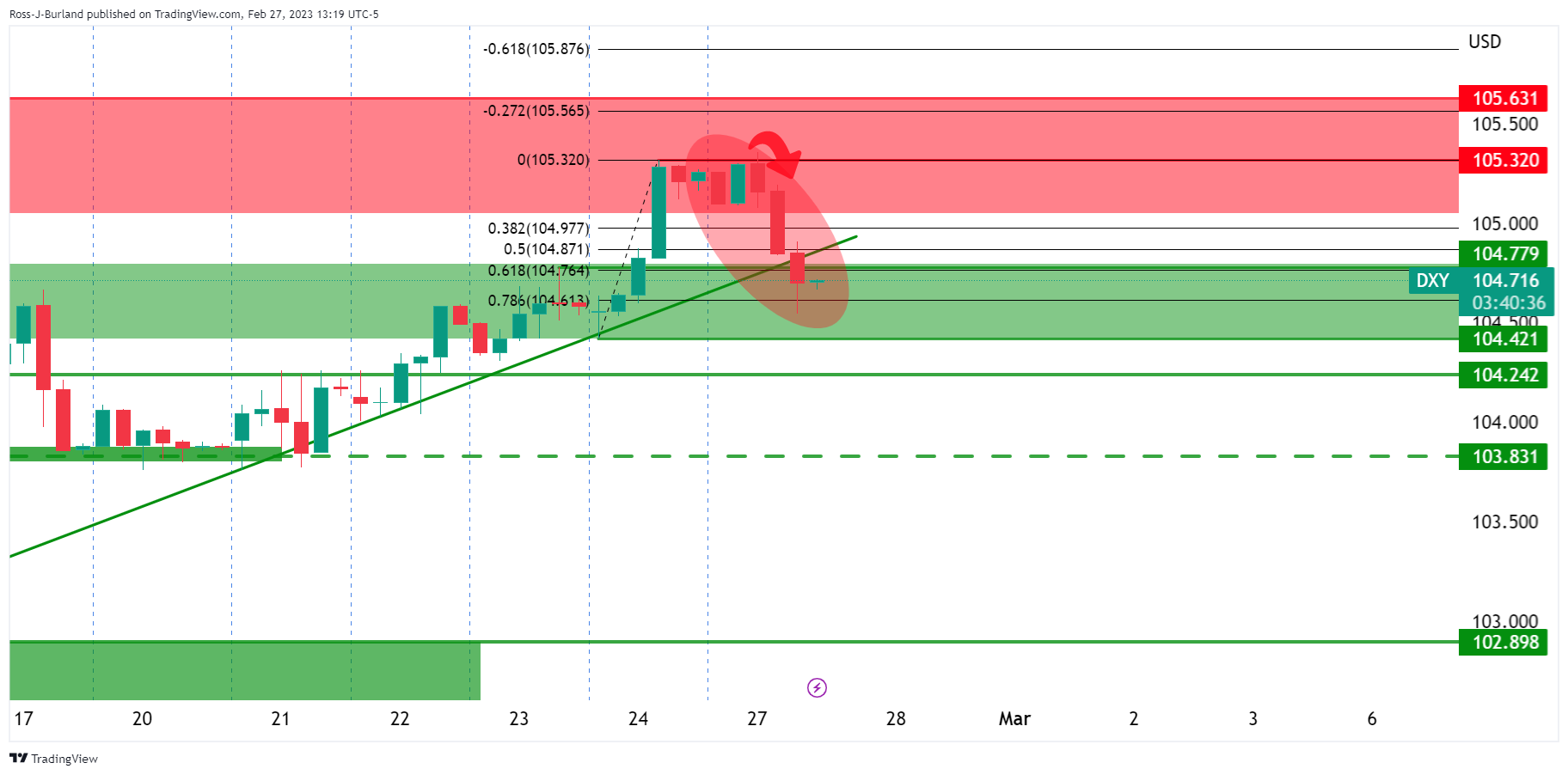
This has left a bullish outlook on the Gold price as follows:
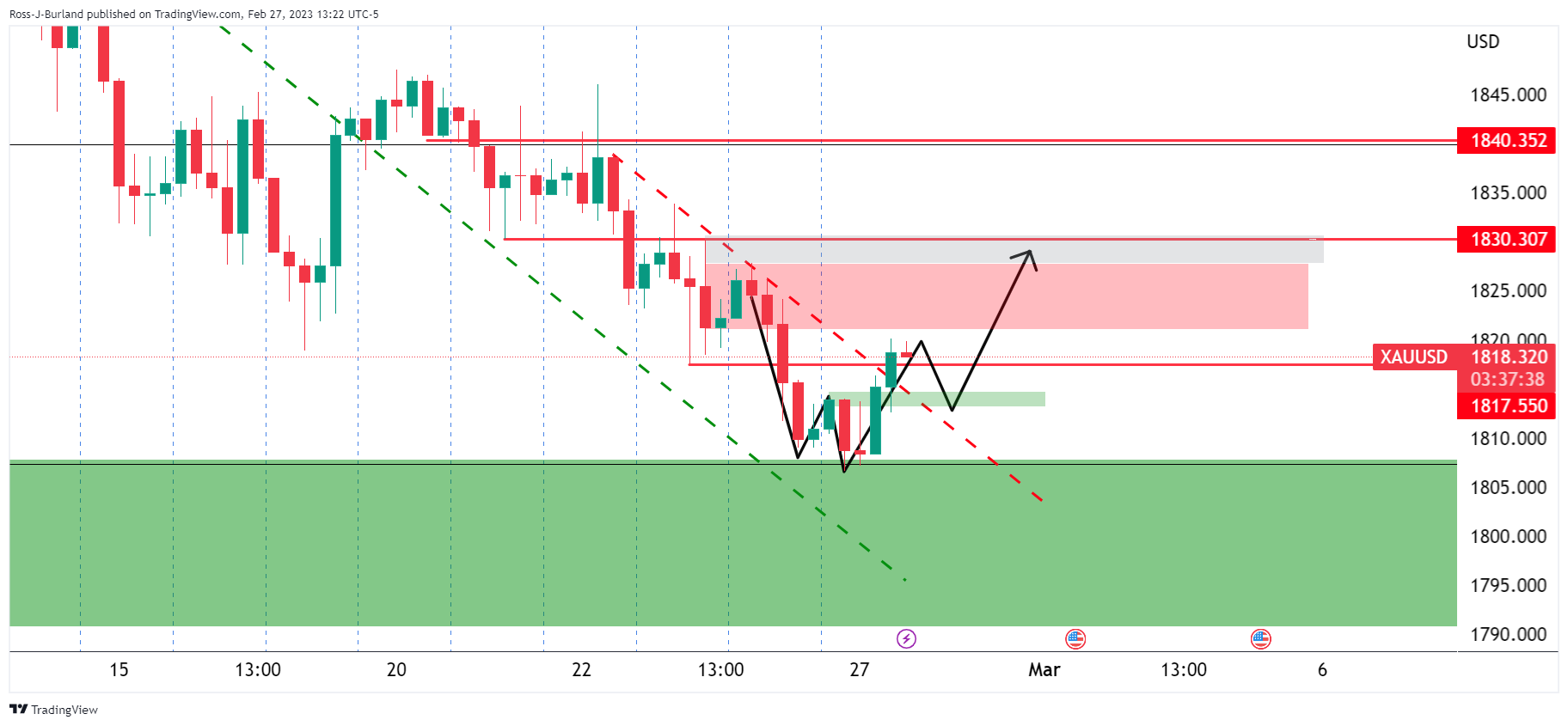
The double bottom near the $1,800 psychological Gold price level is offering a compelling case for a move towards the $1,830s, a touch above the January opening lows. However, a retest of the W-formation's neckline could be on the cards first.
- AUD/USD capped its downfall on risk-on sentiment and mixed US data.
- Durable Good Orders and Pending Home Sales showed mixed readings.
- Fed’s Jefferson commented that tackling inflation to the 2% target would not be easy.
- AUD/USD Price Analysis: To continue its downtrend as it stays below 0.6825.
The AUD/USD trims some of its earlier losses though it remains below the 0.6800 figure after posting a daily high of 0.6743 as the week begins. Dismal economic data in the United States (US) and risk appetite improvement are two reasons that weighed on the US Dollar (USD) and boosted the Australian Dollar (AUD). At the time of writing, the AUD/USD exchanges hands at 0.6739, slightly above its opening price.
Wall Street continues to trade in the green despite a bad Durable Goods Orders report for January in the United States (US). Durable orders plunged -4.5%, vs. a 5.1% gain in December. Excluding Transportation, also known as core orders, rose 0.7% against a no change.
Further data in the US showed an improvement in Pending Home Sales, with the YoY reading sliding less than the -33.9% estimated to -24.1%. On a monthly basis, sales jumped 8.1% vs. expectations of 1%. Pending Home sales have posted two straight reports above zero for the first time since 2020.
The US Dollar Index (DXY), which measures the US Dollar value in relation to six currencies, fell 0.52% to 104.725, reversing gains from last Friday driven by an increase in the US Federal Reserve’s (Fed) preferred inflation indicator, the Core PCE. After data on goods orders, the DXY decreased from approximately 105.100 to current quotations.
In the meantime, speculations that the Fed will tighten monetary conditions still after Governor Phillip Jefferson noted that inflation is too high and reiterated the Fed’s commitment to getting back (inflation) to 2%. He added that “under no illusion,” it will be easy to get inflation back to 2%.
What to watch?
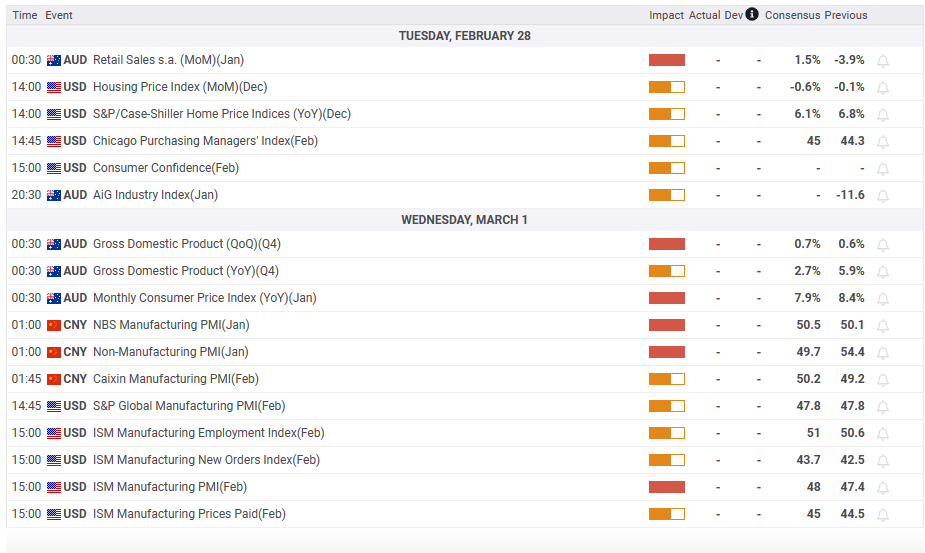
AUD/USD Technical analysis
The AUD/USD downtrend remains in play once the pair collapsed below the 200 and 100-day EMAs, at 0.6857 and 0.6825, respectively. Furthermore, the Relative Strength Index (RSI) accelerated its downtrend but is shy of reaching oversold conditions. This means there is enough room for AUD/USD sellers to drag prices down. Therefore, the AUD/USD first support would be 0.6700, followed by December’s 20 low of 0.6629, ahead of 0.6600.
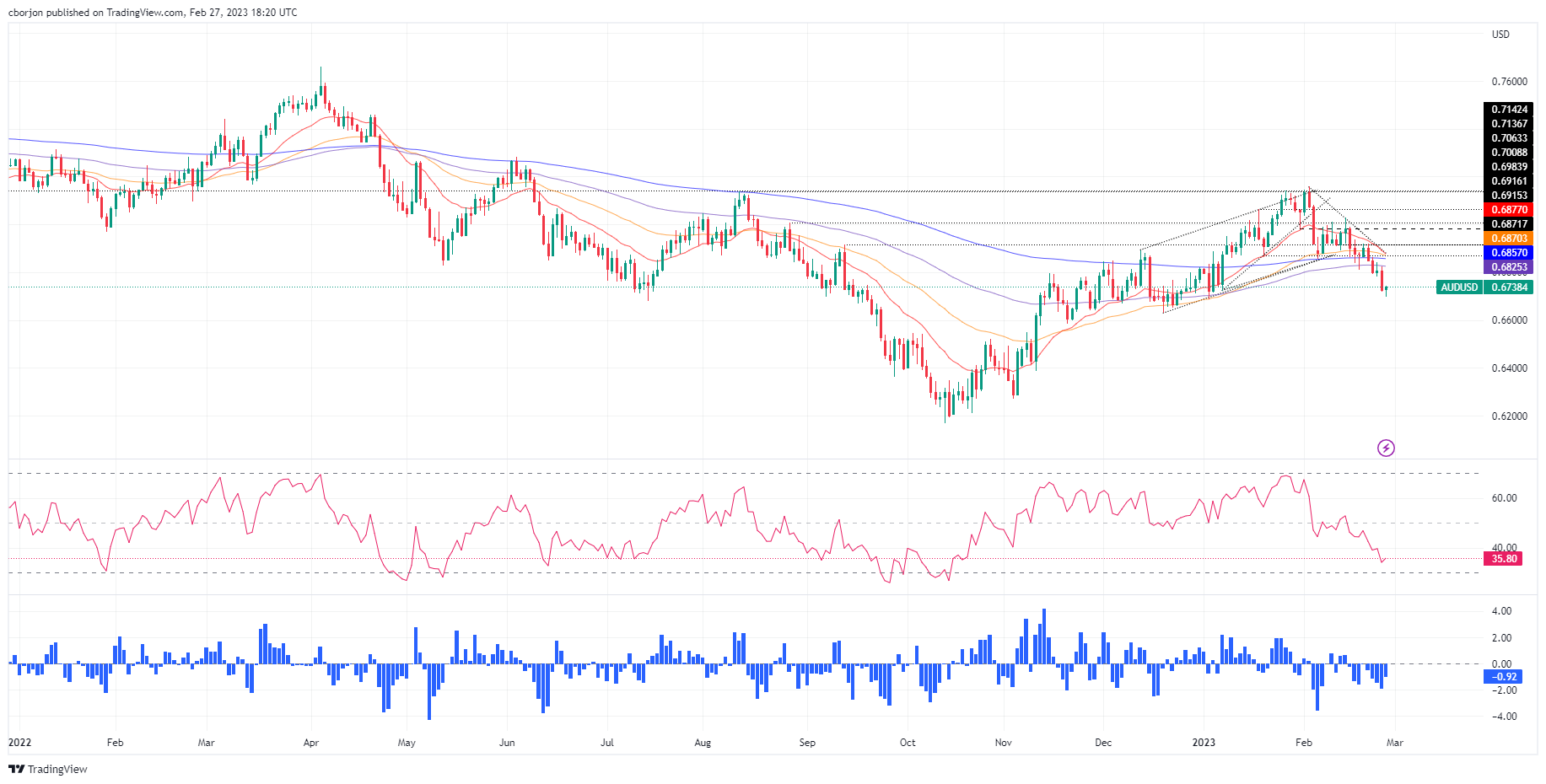
Federal Reserve Governor Philip Jefferson said on Monday that it is possible for inflation to decline without an unnecessary amount of disruption in the job market, as reported by Reuters.
Additional takeaways
"More people do better in the US when there are periods of low inflation and sustained growth."
"Important to get back to 2% inflation to allow those sorts of sustained economic gains."
"Inflation is too high and that is hard for people across the demographic spectrum."
"Lower inflation is a prerequisite for long-term prosperity."
"Right now the labor market is very strong with demand for workers high relative to supply."
"Pandemic has had a substantial impact on labor supply."
"Fed's commitment is to sustain a firmer posture so the economy can adjust, and supply and demand move into better balance."
Market reaction
The US Dollar stays under modest bearish pressure following these comments and the US Dollar Index was last seen losing 0.35% on a daily basis at 104.88.
- The USD/JPY printed a new YTD high and would test 137.00, achieving a daily close above 136.00.
- The 20-DMA crossing above the 50-DMA exacerbated the USD/JPY Friday’s rally above 136.00.
The USD/JPY drops from around YTD highs around 136.55 and hits a daily low of 135.91 before reclaiming the 136.00 figure on Monday. At the time of typing, the USD/JPY falls 0.29%, trading at around 136.20s, underpinned by US bond yields, namely the 10-year benchmark note rate, down three basis points (bps) at 3.918%.
After breaking the year’s previous high at 134.77, the USD/JPY printed another leg-up to the new YTD high at 136.55 before aiming toward the current spot price. From a technical perspective, the USD/JPY is still upward biased, backed by the Relative Strength Index IRSI) in bullish territory and the Rate of Change (RoC), suggesting that in the last three days, buyers have emerged.
Also, the 100-day Exponential Moving Average (EMA) was the last solid resistance level at 134.79, which, once conquered, exacerbated a 160 pip rally to the new YTD high. Traders should be aware that the 20=day EMA at 133.46 crossed above the 50-day EMA at 133.36. Hence, the USD/JPY could accelerate as the 20-day EMA closes the 200-day EMA At 133.86.
As the USD/JPY path of least resistance is upwards, the pair’s next ceiling level would be the 137.00 figure. Break above will expose the December 20 daily high of 137.47 before putting into play the December 15 high at 138.02. As an alternate scenario, the USD/JPY first support would be the 136.00 figure, ahead of today’s low at 135.91.
USD/JPY Daily chart
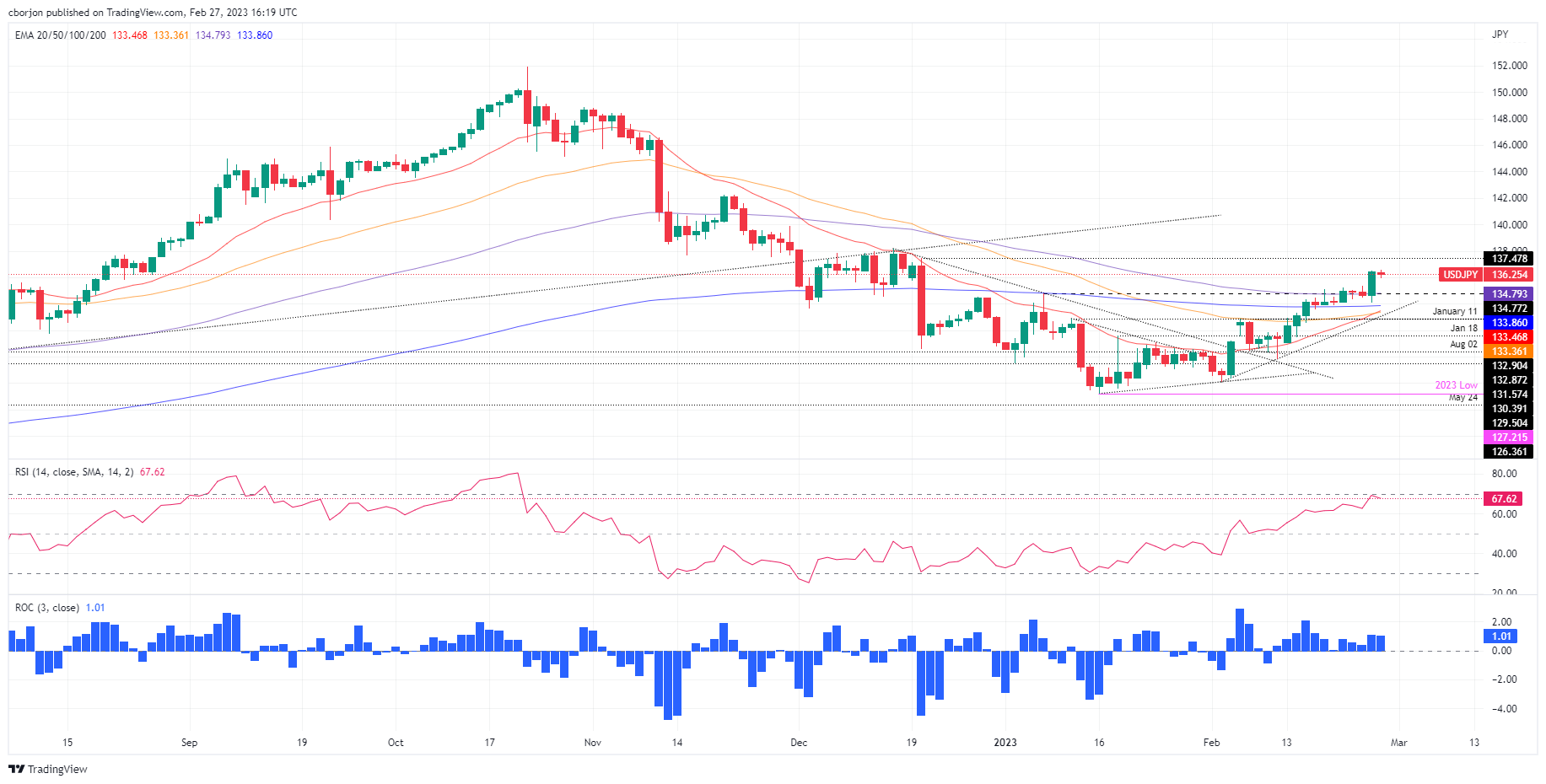
USD/JPY Key technical levels
Data released on Monday showed Durable Goods Orders dropped 4.5% in January, more than the 4% slide expected. Analysts at Wells Fargo point out that despite the headline, the report adds to a string of strong data for the month.
Another headfake from Durables headline, Core Orders rebound
“The 4.5% drop in durable goods orders for January has as much to do with the volatile aircraft component as the 5.1% gain did in December. Indeed, nondefense aircraft orders slid 55% in January after surging 106% the month prior.”
“The pickup in durables adds to a string of strong economic data for January. All major categories beyond transportation and communications equipment saw a pickup in orders last month. Computers saw the largest gain, rising 7% during the month, while machinery equipment experienced a rebound of 1.6% after a larger 2.2% decline in December.”
“As supply chains have eased and new demand has begun to slow, manufacturers have been able to chip away at orders, while some businesses have likely canceled past orders all together. To the extent we see demand continue to falter in coming months, there isn't as much backlog to sustain activity.”
US Dollar edges slightly lower. Nonetheless, economists at Socitbank expect the greenback to remain well-supported on modest dips but it is set to struggle to extend its race higher in the next few weeks.
Month-end flows could extend the USD some support in the short run
“The USD should remain well-supported on modest dips in the short run but with the move to 5.50% in Fed Funds now full priced in at the short-end of the curve, USD gains may become a bit harder to come by (or be sustained) beyond the next few weeks.”
“Month-end flows which could extend the USD some support in the short run, given that US stocks have under-performed European markets by quite a margin over the past month.”
- Pound outperforms across the board on Monday, benefit from Brexit deal.
- UK and European Union reach a new deal to resolve the Northern Ireland trade issue.
- GBP/JPY rises above the 200-day Simple Moving Average.
The GBP/JPY is rising sharply on Monday boosted by a stronger Pound across the board amid the Brexit agreement. The cross rose to 163.98, the highest level since December 20.
Brexit: a new protocol for an old problem
UK Prime Minister Rishi Sunak is announcing a “decisive breakthrough in Brexit talks”. The new deal, according to Sunak implicates changes to the Northern Ireland protocol.
Sunak and European Commission President Ursula von der Leyen are offering a joint press conference, explaining the new deal.
Ahead of the announcement, the Pound was already trading in positive ground across the board. GBP/USD hit 1.2050 while EUR/GBP tested levels under 0.8800.
The GBP/JPY is up by around a hundred pips. The pair peaked at 163.98 and then pulled back modestly as equity prices in Wall Street move off highs. Price is back above the 200-day Simple Moving Average. A consolidation above 164.00 would open the doors for a test of the next resistance area seen at 164.70.
The bias in the short-term point to the upside. A confirmation under 161.70 would change the outlook to neutral/bearish.
Technical levels
What inflation data will become significant? Ulrich Leuchtmann, Head of FX and Commodity Research at Commerzbank, is focused on the development of core inflation.
Trend of rising core inflation rates has been unbroken
“The picture is quite unambiguous: whereas headline rates are falling, the trend of rising core inflation rates has been unbroken. As a result, my message for future inflation data is: pay attention to the development of core rates. That is much more relevant for inflation sentiment.”
“Only once we notice a reversal in core inflation data, the fear of inflation currently affecting the market is going to ease.”
In a joint press conference with European Commission President Ursula von der Leyen on Monday, British Prime Minister Rishi Sunak that they have amended the original Northern Ireland Protocol deal and agreed a new "Windsor framework."
Key takeaways
"We have made a decisive breakthrough."
"Agreement delivers smooth free flowing trade with the UK."
"UK and EU are allies, friends, trading partners."
"Deal is about preserving delicate balance of Belfast Agreement."
"We have found a way to end uncertainty for Northern Ireland."
"Deal delivers green lane, red lane trade routes."
"We have removed any sense of a border in Irish Sea."
"Goods staying in the UK will use a new green lane with a separate red lane for goods moving to the EU."
"Agreement safeguards sovereignty for people of Northern Ireland."
"Stormont can stop EU laws from applying in Northern Ireland."
"Parties will need time to study deal in detail."
Market reaction
GBP/USD edged slightly lower from daily highs with the initial reaction to this announcement and was last seen trading at 1.2030, where it was up 0.75% on a daily basis.
- GBP/USD got bolstered by a soft US Dollar and a risk-on impulse.
- Durable Good Orders collapsed, with US companies feeling the pain of tighter monetary policy.
- The EU and the UK had agreed to a deal in Northern Ireland, which could boost the GBP.
GBP/USD is recovering some ground after hitting a daily low of 1.1921 as speculations for the Brexit deal struck in Northern Ireland grow, which could bolster the Pound Sterling (GBP) in the near term. In addition, worse-than-expected US economic data are a headwind for the greenback. At the time of typing, the GBP/USD is trading at 1.2052, above its opening price by 0.65%.
The US Dollar (USD) is weakening across the board on a dismal Durable Goods Orders report. Durable Good Orders for January plunged below expectations, -4.5%, below the last month’s revised 5.1% figures, the lowest reading since April 2020. The so-called core orders excluding transport rose by 0.7%, above December’s -.0.4% drop.
The US Dollar Index (DXY), a measure of the buck’s value against a basket of rivals, edged down 0.62%, at 104.594, retracing last Friday’s gains sponsored by a jump in the preferred’s gauge for inflation by the US Federal Reserve (FED), the Core PCE. Following goods orders data, the DXY dropped from around 105.100 toward current quotes.
In the meantime, the latest headlines that the United Kingdom (UK) and the Eurozone (EU) agreed to a deal in Northern Ireland sponsored a leg-up in the GBP/USD, as witnessed by the 1-Hour chart. After seesawing around the daily pivot at 1.1970, the GBP/USD jumped around 80 pips, though hit a daily high of 1.2054.
Sources on both sides told the BBC that the UK and EU had reached a post-Brexit trade agreement for Northern Ireland. Later, the EU’s President Ursula von der Leyen and the UK Prime Minister Rishi Sunak are expected to host a press conference at around 15:30 GMT. Details on the agreement will be released later.
GBP/USD technical analysis
From a daily chart perspective, the GBP/USD formed a bullish engulfing candle, which could send the pair rallying toward the 20-day EMA at 1.2088 before testing the 50-day EMA at 1.2097, shy of the 1.2100 mark. A breach of the latter would expose the important 200-day EMA at 12126. As an alternate scenario, the GBP/USD could fall toward the last week’s low at 1.1927 before testing 1.1900.
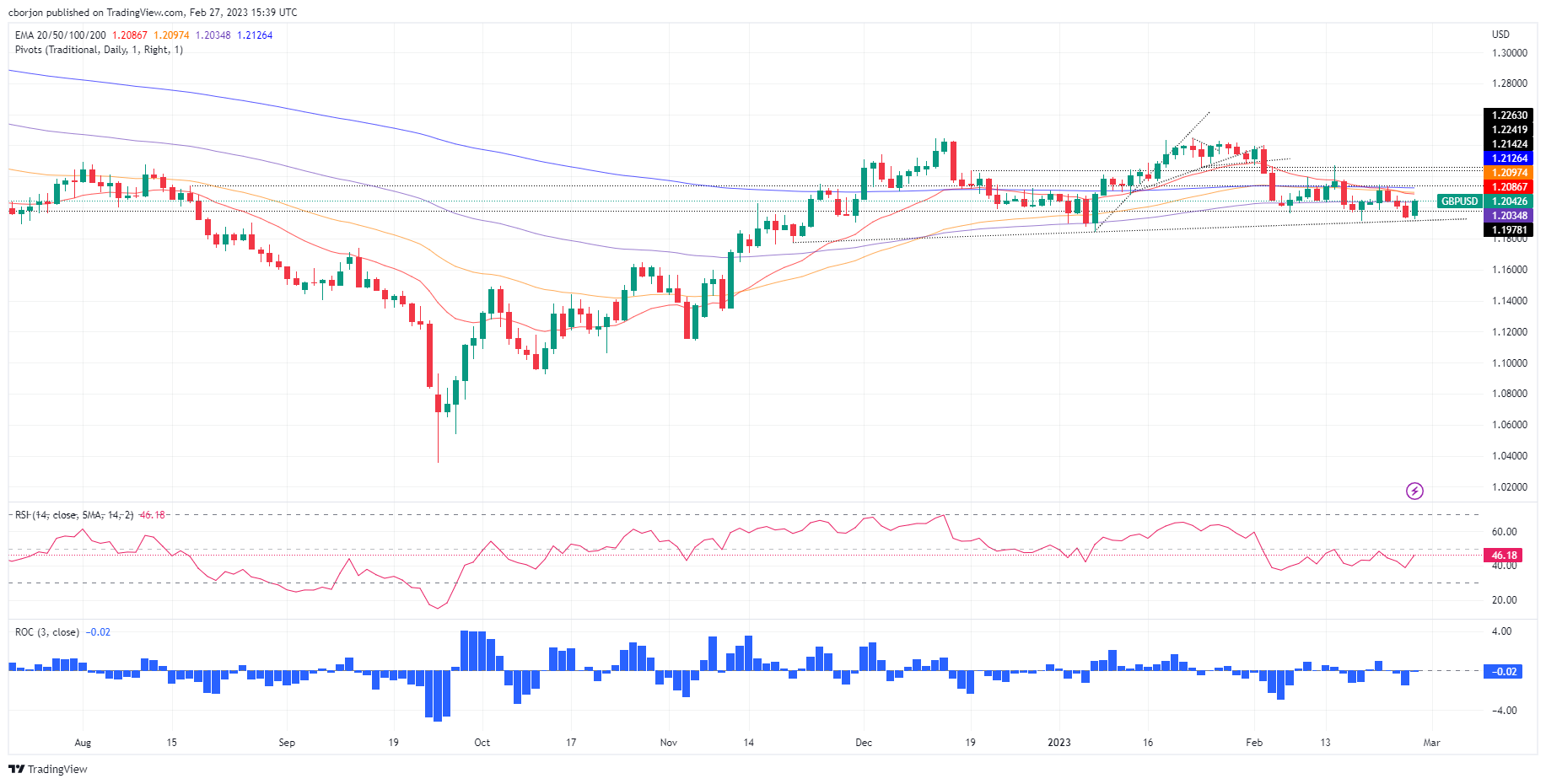
- Euro rises for the first time in five days versus the US Dollar.
- Improvement in risk sentiment weighs on DXY.
- EUR/USD up more than 50 pips for the day.
The EUR/USD is having so far the best day since February 1 on Monday, boosted by a weaker US Dollar across the board on the back of an improvement in risk sentiment and a retreat in Treasury yields. The pair is trading near 1.0615 after hitting earlier at 1.0532, the lowest level in seven weeks.
Not negative US data
Economic data released on Monday in the US showed a larger-than-expected decline in Durable Goods Orders. The headline dropped by 4.5%, against expectations of a 4% slide. Most details of the report were positive. “The drop in January durable goods was due entirely to a reversal in aircraft orders, and core capital goods orders rose by the most in five months. The durables data thus add to a string of strong economic data for January and suggest while manufacturing activity may be set to weaken further, it's not collapsing”, said analysts at Wells Fargo.
A different report showed Pending Home Sales surged 8.1% in January, surprising market participants that expected an increase of around 1%. Compared to a year ago, sales were down 24.1%.
The US dollar weakened after the economic figures while at the same time, equity prices in Wall Street rose further. The S&P 500 is up by 1.13% and the Nasdaq gains 1.42%. Stocks are recovering after the worst week in two months.
US yields are modestly lower for the day. Treasury bonds recovered ground early in the American session. The US 2-year bond yield peaked at 4.85% (highest since November) and is back below 4.80% as of writing. The retreat in US yields is helping EUR/USD move further north as the DXY drops by more than 0.55%.
EUR/USD back above 1.0600
The pair printed a fresh daily high at 1.0610 and is having the best performance in weeks. The euro is breaking a four-day negative streak.
The euro is testing levels above 1.0600 and is starting to look at the next relevant resistance area at 1.0630, as it holds a bullish intraday bias. A slide back under 1.0585, would change the intraday bias to negative again.
Technical levels
Canada will release the fourth-quarter Gross Domestic Product (GDP) data on Tuesday, February 28 at 13:30 GMT as we get closer to the release time, here are forecasts from economists and researchers of six major banks regarding the upcoming growth data.
Canadian growth is expected at 1.5% seasonally adjusted at an annualized rate (SAAR) in Q4.
TDS
“We look for Q4 GDP to print slightly above BoC projections at 1.7% with another large drag from housing as business investment/government spending remain the key drivers for domestic demand. We also forecast a slight increase (+0.1%) for Dec despite the drag from extreme weather and look for new flash estimates to show another strong performance next month.”
RBC Economics
“GDP report will likely show output up a modest 1.5% (annualized) in the final quarter of 2022. And early data is pointing to a likely sizable bounce-back in January GDP. A surge in employment in January pushed hours worked up 0.8% from December and advance estimates for manufacturing and wholesale trade jumped by 3.9% and 3.0%, respectively. Nevertheless, the lagged impact of record interest rate hikes will continue to elevate household debt payments over the first half of 2023. As a result, though early economic data in 2023 has been better than feared, the most likely base case remains at least a mild recession starting in the first half of the year.”
NBF
“Monthly reports published to date suggest consumption may have had a positive impact on growth, driven by a healthy increase in the services sector. Non-residential investment, on the other hand, could have weighed on the headline growth figure, as a small increase in the structures category was likely more than offset by a drop in machinery/equipment. Residential investment, meanwhile, should have subtracted to growth for a third quarter in a row. Trade and inventories are likely to have cancelled each other out, the former contributing strongly to growth and the latter acting as a drag. All told, GDP may have progressed 1.1% in annualized terms.”
CIBC
“Growth in the Canadian economy continued to cool during the final quarter of 2022 (1.3%), likely clocking in at a pace below the economy’s long-run potential and therefore helping ease inflationary pressures. Continued weakness in commodity prices likely brought a further drop in the overall price deflator and a second successive quarterly decline in GDP in nominal terms. The monthly GDP print for December is expected to show little change in economic activity for that month, although the advance estimate for January should point to at least modest growth for the first month of 2023 if the surge in employment is a reliable guide.”
Citibank
“Canada’s real GDP by expenditure should end 2022 by rising 2.1% (QoQ SAAR) in Q4, with possible upside risks. This would be a stronger forecast than Statistics Canada’s preliminary estimate of 1.6% (annualized) and the Bank of Canada’s latest forecast of 1.3% in the January MPR. Stronger GDP growth in Q4 than in the BoC’s latest forecasts, particularly with a pick-up in domestic demand, would be a signal that activity at the end of 2022 and into 2023 is stronger than the BoC previously anticipated. This could lead to a more explicit signal that further rate hikes remain on the table.”
Wells Fargo
“We expect Canada's GDP release to show that the economy remained resilient in the last quarter of 2022, with quarterly GDP (annualized) growth of 1.6% in Q4-2022. Heading into 2023, however, we expect that growth trends may begin to downshift. We forecast a mild recession in Canada in the first half of 2023.”
- Pending Home Sales in the US rose sharply in January.
- US Dollar Index stays in negative territory below 105.00.
Pending Home Sales in the US rose by 8.1% on a monthly basis in January, the data published by the National Association of Realtors showed on Monday. This reading followed December's increase of 1.1% (revised from 2.5%) and came in much better than the market expectation for an increase of 1%.
On a yearly basis, Pending Home Sales declined by 24.1%, compared to analysts' estimate for a decline of 37.5%.
Market reaction
The US Dollar stays on the back foot after this data and the US Dollar Index was last seen losing 0.5% on the day at 104.75.
Senior Economist at UOB Group Alvin Liew assesses the latest Industrial Production figures in Singapore.
Key Takeaways
“Singapore’s industrial production (IP) started the year on a weaker footing with a -1.1% m/m SA, -2.7% y/y decline in Jan, from a revised +2.9% m/m, -2.6% y/y in Dec (2022). For the y/y print, it was well worse than Bloomberg’s median forecast of +0.8% y/y but quite close to our forecast of -2.9% y/y. This was the fourth consecutive month of y/y decline and the worst streak since 2015.”
“The Jan IP was weighed lower by sharper declines in chemicals, precision engineering and general manufacturing, while electronics resumed its decline by -2.9% y/y (after a brief 4.2% rise in Dec). The fall in IP was partly cushioned by biomedical manufacturing which rebounded strongly in Jan by 23.2% y/y thanks mainly to a surprise 37.5% spike in pharmaceutical output and to a less extent, a 3.8% y/y rise in medical technology. And while transport engineering output rose, it slowed further to just 4.7%."
“IP Outlook – Notwithstanding the volatility brought by the biomedical manufacturing component, the latest Jan IP print continues to affirm our downbeat manufacturing outlook, and we maintain our forecast for Singapore 2023 manufacturing to contract by 5.4% due to the faltering outlook for electronics and weaker external demand. In comparison, in-person services (excluding trade-related services) could fare better in 2023 due to various upside growth factors such as the continued recovery in leisure and business air travel and inbound tourism, and the impact of China’s reopening is likely to be positive for these sectors. With the weaker 2023 manufacturing outlook and barring external events (such as escalating war in Europe and a deadlier variant of COVID-19), we keep our modest 2023 GDP growth forecast of 0.7% (closer to the lower end of the official forecast range of 0.5-2.5%).”
Economists at Wells Fargo believe the US Dollar can stabilize through Q1-2023. Longer term, the greenback is set to depreciate.
US growth resilience and hawkish Fed policy should come to an end by H1-2023
“The USD should experience a prolonged period of depreciation, as relative growth and monetary policy fundamentals should become less supportive of the greenback over time.”
“US growth resilience and hawkish Fed policy should come to an end by the first half of this year and, with it, an end to USD resilience. Initially, we expect USD depreciation will be gradual later this year as the US falls into recession during the second half of 2023, but the Federal Reserve hesitates from lowering interest rates prematurely.”
“We expect the USD's depreciation to gather pace in 2024 once the Fed starts cutting interest rates aggressively.”
- EUR/USD rebounds from fresh monthly lows near 1.0530.
- The next target of note emerges at the weekly high beyond 1.0800.
EUR/USD manages to regain some traction and leaves behind multi-week lows in the 1.0535/30 band at the beginning of the week.
There is a temporary up barrier at the 55-day SMA at 1.0715 ahead of the weekly peak at 1.0804 (February 14). A convincing move above the latter could mitigate the selling pressure in the near term.
Looking at the longer run, the constructive view remains unchanged while above the 200-day SMA, today at 1.0328.
EUR/USD daily chart
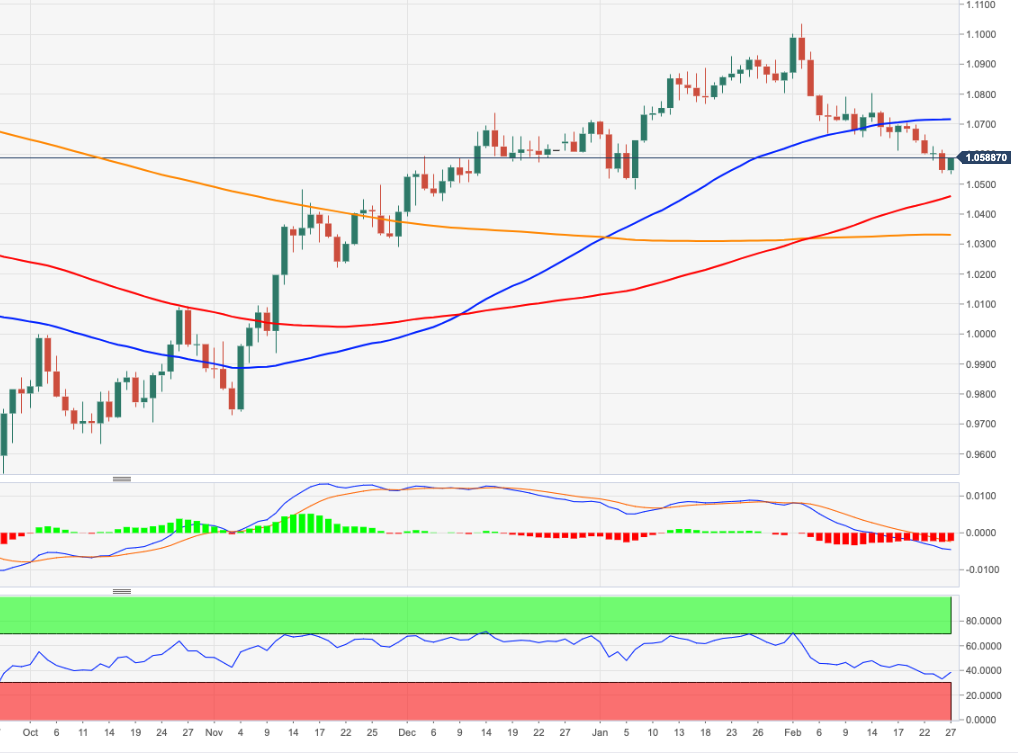
This month, the Dollar has nearly gained 3% against the Euro. But relative rate trends are expected to favour the shared currency again in the coming weeks, Kit Juckes, Chief Global FX Strategist at Société Générale, reports.
When will a lack of credit growth become a problem for Europe?
“The front end is priced for the ECB to hike by 50 bps more than the Fed in the next six months, and while that’s an increase of only 35 bps from what was priced in at the end of January, we expect to see relative rate trends start to favour the Euro again in the coming weeks.”
“If there’s a cloud on the horizon, it comes in the form of slowing European money supply data. M3 growth slowed to 3.5% YoY and overall credit growth is running at 3.1% YoY, down from 6.2% this time last year. There’s a big overhang of excess credit floating around, but in real terms, we’re now firmly in negative territory and if we stay there, darker clouds will creep over the 2024 growth outlook. Watch that space.”
The US Dollar Index (DXY) climbed back above the 105.00 level at the end of last week. Economists at MUFG Bank see room for the USD rebound to run further in the near-term.
Fresh upward momentum for the US Dollar
“We still believe that the USD’s recent rebound has room to run further in the near-term.”
“After breaking above the 105.00 mark, the DXY is set to retest the year-to-date high at 105.63 and then the 200-Day Moving Average at just below 106.50.”
- USD/CAD retreats further from its highest level since January amid broad-based USD weakness.
- The risk-on impulse prompts profit-taking around the safe-haven buck and weighs on the major.
- Weaker Oil prices could undermine the Loonie and lend support amid hawkish Fed expectations.
The USD/CAD pair comes under heavy selling pressure on the first day of a new week and retreats further from its highest level since January 6 touched on Friday. The pair maintains its offered tone, around the 1.3565-1.3560 region through the early North American session and reacts little to the mixed US macro data.
The US Census Bureau reported that headline Durable Goods Orders fell by 4.5% in January, down sharply from the previous month's downwardly revised reading that showed a strong 5.1% growth. The disappointment, however, is offset by orders excluding transportation items, which rose 0.7% during the reported month as compared to a modest 0.1% uptick anticipated and fails to provide any impetus.
That said, a recovery in the global risk sentiment - as depicted by a generally positive tone around the equity markets - continues to weigh on the safe-haven Greenback. This, in turn, is seen as a key factor exerting pressure on the USD/CAD pair, though a combination of factors should help limit deeper losses and warrants some caution before positioning for any further decline.
Crude Oil prices meet with a fresh supply amid worries that rapidly rising borrowing costs will dampen economic growth and dent fuel demand. This could undermine the commodity-linked Loonie. Apart from this, expectations that the Federal Reserve will stick to its hawkish stance in the wake of stubbornly high inflation support prospects for the emergence of some USD dip-buying.
Even from a technical perspective, the USD/CAD pair last week confirmed a breakout through the 100-day Simple Moving Average (SMA), which favours bullish traders. Furthermore, speculations that the Bank of Canada (BoC) will pause the policy-tightening cycle make it prudent to wait for strong follow-through selling to confirm that spot prices have topped out in the near term.
Technical levels to watch
- DXY loses some upside impetus and retreats to the sub-105.00 area.
- Bulls continue to target the 2023 high around 105.60 in the short term.
DXY comes under pressure following fresh tops near 105.40 on Monday.
The ongoing price action favours the continuation of the uptrend in spite of the ongoing corrective move. Further bouts of strength should then clear the February high at 105.35 (February 27) to allow for a probable challenge of the 2023 top at 105.63 (January 6).
In the longer run, while below the 200-day SMA at 106.48, the outlook for the index remains negative.
DXY daily chart
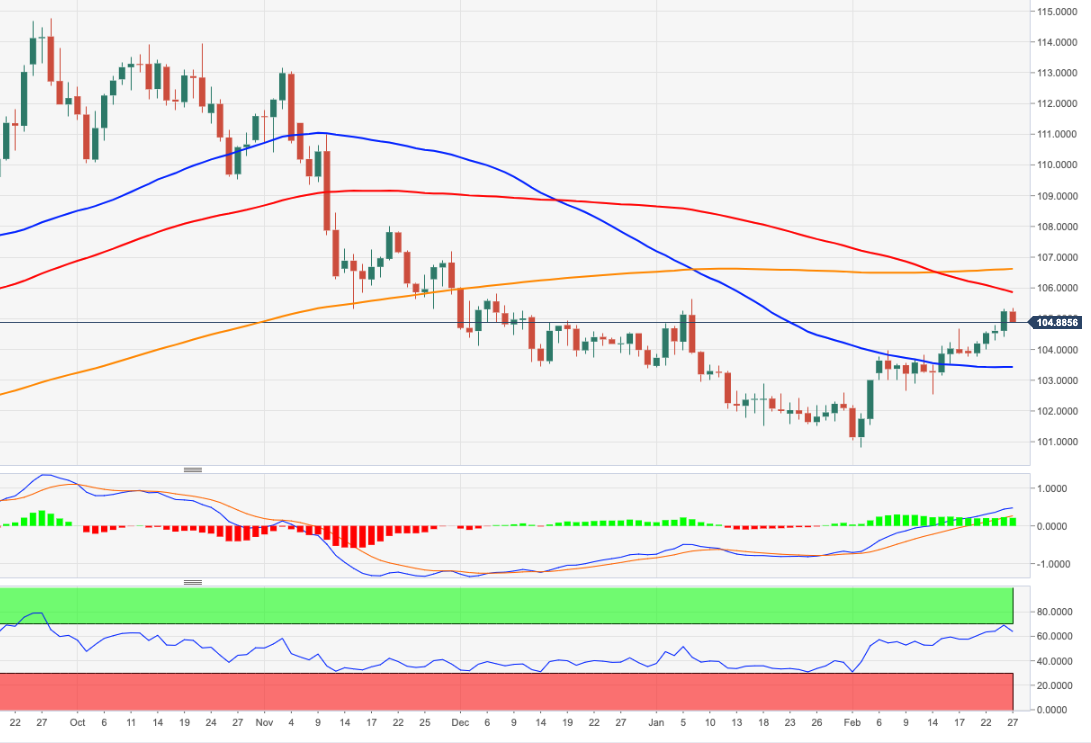
UOB Group’s Senior Economist Julia Goh and Economist Loke Siew Ting comment on the latest results from inflation figures in Malaysia.
Key Takeaways
“Headline inflation decelerated for the fifth straight month to 3.7% y/y in Jan (from 3.8% in Dec 2022) amid the implementation of the Festive Season Maximum Price Scheme for the 2023 Chinese New Year starting from 15 to 29 Jan. It marked the lowest reading since Jun 2022. The outturn matched our estimate and Bloomberg consensus. Key areas that led the price gains were – restaurants & hotels (6.8%), food & non-alcoholic beverages (6.7%), and transport (4.0%).”
“We expect inflation to average 2.8% in 2023 (MOF est: 2.8%-3.3%, 2022: +3.4%). Our inflation forecast has yet to impute any potential changes in domestic policy related to price-administered items particularly fuels, utilities and staple food product (i.e. chicken, eggs and cooking oil). In addition to that, volatile global commodity and non-commodity prices, spillover effects from China’s reopening, and currency movement are also wildcards for our inflation outlook.”
“Given a moderation in global commodity prices and softer domestic growth momentum amid lingering macro headwinds, we expect Bank Negara Malaysia (BNM) to extend its interest rate hike pause at the next monetary policy meeting on 8-9 Mar. An expected expansionary budget that is scheduled to be retabled by the government this afternoon (24 Feb) is also key to shape the policy rate outlook. Meanwhile, the current global and domestic economic developments continue to support our view that BNM will resume its policy rate hike by 25bps in May and maintain rates at 3.00% for the rest of the year.”
- EUR/JPY navigates within a narrow range below the 144.00 mark.
- A move above the 2023 peak should spark extra upside.
EUR/JPY alternates gains with losses in the sub-144.00 region at the beginning of the week.
While the cross looks somewhat side-lined for the time being, a convincing breakout of the 2023 high at 144.16 (February 21) could spark extra strength to, initially, the December 2022 peak at 146.72 (December 15).
In the meantime, while above the 200-day SMA, today at 141.45, the outlook for the cross is expected to remain positive.
EUR/JPY daily chart
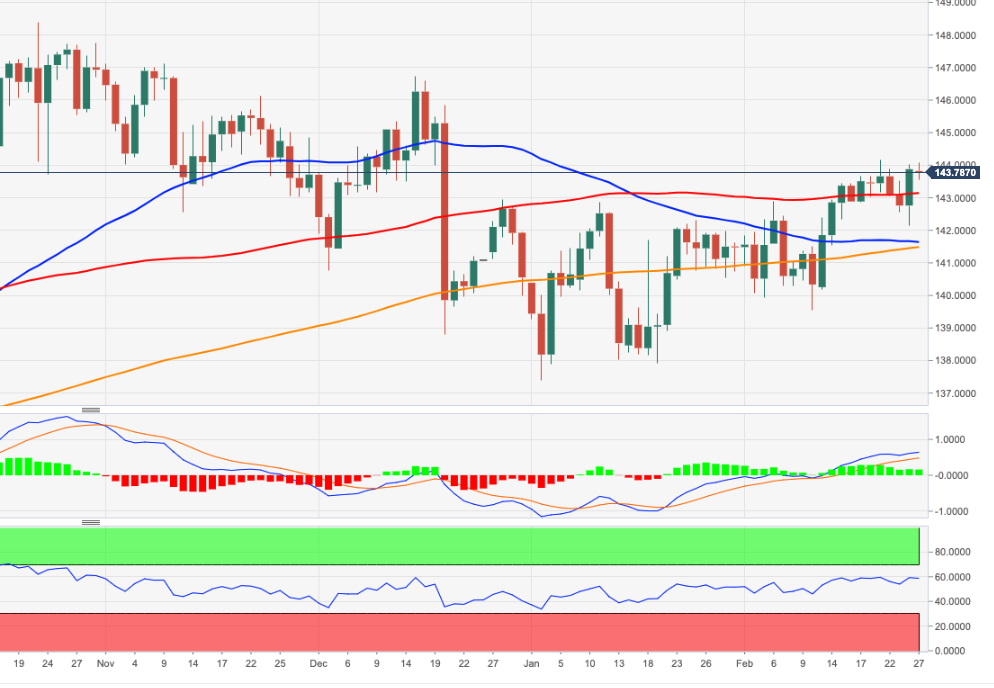
- Durable Goods Orders in the US declined sharply in January.
- US Dollar Index stays in negative territory near 105.00.
Durable Goods Orders in the US decreased by 4.5%, or $13 billion, in January to $272.3 billion, the US Census Bureau announced on Monday. This reading followed December's increase of 4% and came in slightly weaker than the market expectation for a decrease of 4%.
"Excluding transportation, new orders increased 0.7%," the publication read. "Excluding defense, new orders decreased 5.1%. Transportation equipment, also down two of the last three months, drove the decrease, $14.2 billion or 13.3%, to $92.8 billion."
Market reaction
With the initial reaction, the US Dollar Index edged lower and was last seen losing 0.25% on the day at 105.00.
In the view of Market Strategist at UOB Group Quek Ser Leang, there is still sciope for further upside in USD/IDR in the short term.
Key Quotes
24-hour view: “Last week, we held the view that USD/IDR ‘is likely to edge higher to 15,245 but a sustained rise above this level is unlikely’. Our view did not materialize as USD/IDR rose to 15,228 before closing at 15,220 on Friday (+0.13%). USD/IDR traded on a strong footing after opening today and has broken above the major resistance at 15,245.”
“The rapid increase in momentum suggests further USD/IDR strength this week. However, it remains to be seen if the next major resistance at 15,490 is within reach this week. The upside risk is intact as long as USD/IDR stays above 15,140 (minor support is at 15,200).”
- NZD/USD continues losing ground on Monday and drops to its lowest level since November.
- A modest recovery in the risk sentiment undermines the USD and lends support to the pair.
- Hawkish Fed expectations, elevated US bond yields support prospects for additional losses.
The NZD/USD pair extends Friday's breakdown momentum below the 200-day Simple Moving Average(SMA) and drops to over three-month low on the first day of a new week. The pair maintains its offered tone heading into the North American session and is currently placed just below mid-0.6100s, down nearly 0.50% for the day.
The US Dollar remains pinned near a seven-week high amid hawkish Fed expectations and turns out to be a key factor that continues to exert downward pressure on the NZD/USD pair. In fact, the markets seem convinced that the US central bank will stick to its hawkish stance in the wake of stubbornly high inflation. The bets were reaffirmed by the stronger US PCE Price Index data on Friday, which indicated that inflation isn't coming down quite as fast as hoped.
Furthermore, the incoming robust US macro data points to an economy that remains resilient despite rising borrowing costs. This should allow the Fed to continue lifting interest rates, which remains supportive of elevated US Treasury bond yields and continues to lend support to the buck. That said, a modest recovery in the equity markets undermines the Greenback's relative safe-haven status and helps limit losses for the risk-sensitive Kiwi, at least for now.
The fundamental backdrop, however, remains tilted in favour of bearish traders and suggests that the path of least resistance for the NZD/USD pair is to the downside. Moreover, Friday's sustained break and close below a technically significant 200-day SMA adds credence to the negative outlook. Traders now look to the US economic docket, featuring the release of Durable Goods Orders and Pending Home Sales data, to grab short-term opportunities around the major.
Technical levels to watch
EUR/USD edges higher after reaching minor new cycle low. Short-term trading patterns are tilting bullish but a fall to the mid-1.04s is on the cards.
EZ yields rise
“Core Eurozone 2Y yields are trading above 3% for the first time since 2008. Firm yields may provide some underpinning for the EUR in the medium term (and limit near-term losses against the USD).”
“The six-hour chart shows the EUR carving out a bullish outside range session after its early dip to 1.0533. This may see spot regain 1.06-plus in the short run but we still rather think that broader trends point to EUR/USD losses extending to the mid-1.04 area before a more sustainable base can develop.”
“Resistance is 1.0575/1.0625.”
Short-term GBP trading patterns are leaning bullish. Cable may push higher in the short run, analysts at Scotiabank report.
Near-term trends driven by broader USD tone and expectations into March BoE decision
“Sterling may be responding to signals that the UK is very close to tying up a post-Brexit trading arrangement with the EU. A deal would be a longer-term positive for the Pound but may not alter near-term dynamics to any significant extent beyond giving the GBP a modest, psychological boost.”
“Near-term trends will be driven by the broader USD tone as well as market expectations running into the Mar 23rd BoE decision (and, to some extent, the March 15th budget announcement).”
“Positive, short-term price signals around important, longer-term support levels warrant attention and sets the GBP up for more short-term gains to 1.2050.”
“Key – bull trigger resistance – lies at 1.2150.”
USD/JPY surged to its highest level in two months above 136.00 on Friday. There is scope for further upside in the near-term, economists at MUFG Bank report.
Upside risks for USD/JPY
“The recent move higher in US rates has helped to lift USD/JPY back above the 135.00 level and it has continued to move closer to its’ 200-Day Moving Average that comes in at around 137.10.”
“We still expect the BoJ to abandon Yield Curve Control in Q2 while maintaining negative rates this year, although there is a higher risk it could take longer to make further adjustments to YCC. It leaves the Yen vulnerable to weakness in the near-term while yields outside of Japan are rising again.”
US Durable Goods Orders overview
Monday's US economic docket highlights the release of Durable Goods Orders data for January. The US Census Bureau will publish the monthly report at 13:30 GMT and is expected to show that headline orders declined by 4% during the reported month, down sharply from the 5.6% rise reported in December. Orders excluding transportation items, which tend to have a broader impact, are anticipated to register a modest 0.1% growth in January as compared to the 0.2% fall recorded in the previous month.
How could it affect EUR/USD?
Ahead of the data, the modest recovery in the risk sentiment weighs on the safe-haven US Dollar and assists the EUR/USD pair to bounce off over a seven-week low touched earlier this Monday. Any disappointment from the US macro data could prompt additional USD profit-taking, though hawkish Fed expectations should help limit deeper losses.
A stronger report, on the other hand, will reaffirm bets for further policy tightening by the Fed, which, in turn, should lift the US Treasury bond yields and the Greenback. Apart from this, looming recession risk, along with geopolitical tensions, favour the USD bulls and suggest that the path of least resistance for the EUR/USD pair is to the downside.
Eren Sengezer, Editor at FXStreet, offers a brief technical outlook and outlines important technical levels to trade the major: “EUR/USD stays within the lower half of the descending regression channel coming from early February. Although the Relative Strength Index (RSI) indicator on the four-hour chart suggests that the pair is about to turn oversold, the lower limit of that channel at 1.0530 could be tested before sellers target 1.0500 (psychological level) and a fresh 2023-low at 1.0480.”
“In case the pair rises above 1.0570 (mid-point of the descending channel) and stabilizes there, it could extend its correction toward 1.0600 (20-period Simple Moving Average, psychological level, static level) and 1.0640 (50-period SMA),” Eren adds further.
Key Notes
• EUR/USD Forecast: Euro on track to challenge 2023 lows
• EUR/USD finds some respite near 1.0530, looks at data
• EUR/USD seen at 1.05 by mid-year, recovery to 1.10 expected by year-end – BofA
About US durable goods orders
The Durable Goods Orders, released by the US Census Bureau, measures the cost of orders received by manufacturers for durable goods, which means goods planned to last for three years or more, such as motor vehicles and appliances. As those durable products often involve large investments they are sensitive to the US economic situation. The final figure shows the state of US production activity. Generally speaking, a high reading is bullish for the USD.
EUR/USD continues its retracement from 1.10. The pair is expected to remain under downside pressure. Nonetheless, a rebound around 1.0450 is on the cards, economists at Société Générale report.
Mont-end could elicit further selling
“Mont-end could elicit further selling today/tomorrow.”
“The problem confronting the ECB, like that facing the Fed, is that it may have to prolong the tightening cycle and by doing so cause a harder economic landing. This could bring down equities and credit markets. European securities have outperformed the US since the start of the year and a reconvergence would test the premise for a stronger EUR/USD.”
“The pair has basically dropped five big figures from a high of 1.1033 over the past month on 60 bps of additional implied Fed tightening. If markets were to, say, reprice Fed funds to 6%, it would be unwise to rule out further selling. We should, however, see a rebound first, if not before, then around 1.0450.”
GBP/USD has fallen back below the 1.2000 level. A looming Brexit deal could lift the Pound, but only temporarily, economists at MUFG Bank report.
Temporary boost from Northern Ireland Brexit deal?
“The recent modest improvement in sentiment towards the UK could be further improved in the near-term by reports that the UK is close to agreeing a deal with the EU over a post-Brexit settlement for Northern Ireland.”
“While the announcement of a deal could temporarily support the Pound, it is unlikely to have a significant and lasting impact on GBP performance. The recent broad US Dollar rebound and deterioration in global investor risk sentiment are more important in driving Cable lower in the near-term.”
USD/CAD hovers around the 1.36 level. Economists at Scotiabank expect the pair to continue its grind higher.
Little scope for CAD gains
“Our week ahead model suggests little scope for CAD gains and a potential 1.3460/1.3770 range for funds. All else equal though, the base for the USD is likely to be somewhat higher in the 1.3550/00 range.”
“Weaker stocks, reflecting rising short-term rates, remain a major headwind for the CAD, given its still strong, positive correlation with US equities.”
“Short, medium and longer-term DMI oscillators are aligned bullishly for the USD which typically means a strong, underlying uptrend is underway with limited potential for counter-trend corrections.”
“The 1.3550/60 zone now is key support from a technical point of view.”
“Gains have extended to near the 1.37 area (late 2022 highs) which may provide some stronger resistance to the USD advance. But the strength of the underlying trend suggests some risk at least of an overshoot to the 1.3820/30 zone.”
While economists at HSBC expect NZD/USD to rise later in the year, the near-term upside is likely to be limited.
Excessive debt issuance in NZ could weigh on the NZD over the near term
“We think the RBNZ meeting was slightly more hawkish than markets expected. However, the near-term upside for NZD/USD is likely to be limited, as risk appetite, which remains the dominant driver for the currency pair, may not improve until renewed signs of disinflation emerge domestically and internationally.”
“Any sign of excessive debt issuance in New Zealand could also weigh on the NZD over the near term. However, we expect NZD/USD to rise over the longer term when some of the uncertainties about the Federal Reserve, the US economy’s landing, and China’s recovery subside.”
- EUR/GBP meets with a fresh supply on Monday and snaps a three-day winning streak.
- Bets for additional BoE rate hikes underpin the British Pound and act as a headwind.
- The fundamental backdrop favours bears and supports prospects for additional losses.
The EUR/GBP cross comes under fresh selling pressure on Monday and stalls a three-day-old recovery move from the monthly low touched last week. The cross remains depressed through the first half of the European session and is currently placed near the daily low, just above the 0.8800 mark.
Reviving bets for additional rate hikes by the Bank of England (BoE) turn out to be a key factor behind the British Pound's relative outperformance and drag the EUR/GBP cross lower. The UK PMIs released last week indicated that business activity rose more than expected in February and raised hopes that Britain may be able to avoid a steep economic downturn. This could persuade the BoE to continue tightening its monetary policy to tame inflation.
In contrast, the markets already seem to have fully priced in additional jumbo interest rate hikes by the European Central Bank (ECB) in the coming months. This is reinforced by a rather muted reaction to the recent hawkish commentary by several ECB policymakers and further contributes to the offered tone surrounding the EUR/GBP cross. This, in turn, favours bears and suggests that the path of least hurdle for spot prices is to the downside.
There isn't any major market-moving economic data due for release on Monday, either from the Eurozone or the UK. Hence, any intraday move-up might still be seen as a selling opportunity and runs the risk of fizzling out rather quickly. Meanwhile, the focus remains glued to the BoE Governor Andrew Bailey's speech on Thursday and the flash Eurozone consumer inflation figures on Friday, which should provide a fresh impetus to the EUR/GBP cross.
Technical levels to watch
Economists at Bank of America Global Research target EUR/USD at 1.05 by the first half of 2023 and 1.10 by year-end.
Inflation is likely to imply near-term stability and upside for USD
“Inflation is likely to imply near-term stability and upside for USD, given low unemployment and inertia for the core. Still, we look for that upside to be more limited, with our 1.05 focal point for the first half of this year for EUR/USD.”
“We hold our general FX views for G10, and see USD overvaluation as guiding our longer-term outlook, including our forecast of 1.10 for end-of-year EUR/USD."
- Economic Sentiment Indicator in the Eurozone declined modestly in February.
- EUR/USD continues to fluctuate in a tight range at around 1.0550.
The data published by the European Commission revealed on Monday that the Economic Sentiment Indicator in the Euro area edged lower to 99.7 in February from 99.8 in January, compared to analysts' estimate of 101, and remained unchanged at 97.8 in the EU.
Further details of the publication showed that the Industrial Confidence in the Euro area declined to 0.5 from 1.2, the Services Sentiment advanced to 9.5 from 1.4 and the Consumer Confidence Index came in at -19, matching the flash estimate.
Market reaction
EUR/USD showed no immediate reaction to these figures and was last seen trading virtually unchanged on the day at around 1.0550.
- Gold price stays in bearish mode, approaching $1,800 psychological support.
- US Dollar stays dominant across the board as US macroeconomic data keeps beating expectations.
- ISM Manufacturing and Services PMI releases headline a mid-tier economic data week.
Gold price has opened the week quietly, treading waters above the round $1,800 figure, which is providing immediate support. The bright metal lost value to the US Dollar on all five trading days last week, seeing its biggest sell-off on Friday after the US Personal Consumption Expenditures (PCE) inflation release, the Fed’s preferred indicator, clearly beating expectations.
This week, a bunch of mid-tier United States macroeconomic releases could help shape how much more room Gold price can have to the downside ahead of the crucial March 22 Federal Reserve (Fed) meeting. The US central bank probably will take all the data into account before delivering its next monetary policy plan – the now famously known as dot plot – although next two weeks with Nonfarm Payrolls and Consumer Price Index should be more impactful.
Gold news: Consumer Confidence more relevant than Durable Goods Orders
The US Census Bureau will release the Durable Goods Orders data for January at 13:30 GMT. Since the beginning of February, upbeat macroeconomic data releases from the United States have been supporting the US Dollar, and a similar market reaction could be expected this time. Nevertheless, this data by itself is unlikely to impact the Federal Reserve's policy outlook in a significant way.
On Tuesday, the Conference Board's Consumer Confidence Survey for February (scheduled for 15 GMT) will be scrutinized for more direction. Rather than the headline Consumer Confidence Index, the one-year consumer inflation expectations could trigger a reaction. In January, this component of the survey climbed to 6.8% from 6.6% in December. In case there is a pullback in this figure, the US Dollar could lose interest and help Gold price stage a short-term recovery and vice versa.
United States Manufacturing and Services PMIs on the way
The ISM will publish the Manufacturing PMI and the Services PMI on Wednesday and Friday, respectively, both at 15 GMT.
If the ISM Services PMI report reaffirms that rising wage costs are feeding into accelerating price pressures in the sector, the US Dollar is likely to hold its ground against Gold. Hence, the Prices Paid Index component will be watched closely by market participants.
It's worth noting, however, that the CME Group FedWatch Tool shows that markets are fully pricing in at least two more 25 basis points Federal Reserve rate hikes in March and May. Additionally, the probability of the Fed holding the policy rate unchanged in June stands at 25%.
The market positioning suggests that the US Dollar doesn't have a lot of room on the upside, at least until the February jobs report and inflation data confirm or refute one more 25-bps hike in June.
In the meantime, investors will be watching the US Treasury bond yields. 4% aligns as key resistance for the 10-year US T-bond yield and there could be a technical correction if that level stays intact. In that scenario, Gold price could turn north due to the inverse correlation with the US Treasury yields.
Gold price developing more bearish patterns
Dhwani Mehta, Senior Analyst at FXStreet, analyzes Gold price current bearish trend:
Gold price is maintaining its downtrend while within a falling wedge formation since peaking at $1,960 on February 2.”
“XAU/USD is likely to test the falling trendline support at $1,794 after it breached several crucial demand area last week. At that level, the bullish 100-Daily Moving Average (DMA) coincides. Ahead of that level, the $1,800 level will likely offer stiff resistance to Gold sellers.
Gold price in 2023: Up-and-down action
Financial markets have been a two-tale story for the early part of 2023, in which Gold price has reflected in its price action like no other asset. XAU/USD rode an uptrend during all of January with the market optimism about inflation slowing down and constant Federal Reserve dovish talk, only to see a drastic turnaround back to the old dynamics in February after a hot US Nonfarm Payrolls (NFP) report. The US economy adding more than 500K jobs in the month of January shifted the market expectations for the Fed easing its monetary policy, and the US Dollar has come back to the market King throne.
-638130901216550005.png)
Gold price daily chart
Gold price opened the year at $1,823.76 and reached a year-to-date high of $1,960 on February 2, right in between the first Federal Reserve meeting of the year and the surprising release of the US jobs report for January. Since then, the ongoing downtrend has been relentless, reaching levels below the yearly open, around $1,800.
- AUD/USD drops to a fresh low since January, though shows some resilience below the 0.6700 mark.
- A positive risk tone prompts some USD profit-taking and lends support to the risk-sensitive Aussie.
- Bets for more rate hikes by the Fed, elevated US bond yields limit the USD slide and cap the major.
The AUD/USD pair kicks off the new week on a weaker note and drops to a fresh low since January 6, though manages to recovery a few pips from sub-0.6700 levels. The pair is currently placed around the 0.6715-0.6720 region, down over 0.10% for the day, and remains at the mercy of the US Dollar price dynamics.
A goodish recovery in the US equity futures prompts some profit-taking around the safe-haven Greenback and seems to benefit the risk-sensitive Aussie. That said, the prospects for further policy tightening by the Federal Reserve keep the US Treasury bond yields elevated, which, in turn, helps limit losses for the USD and continues to weigh on the AUD/USD pair.
The markets now seem convinced that the US central bank will stick to its hawkish stance for longer and the bets were reaffirmed by the stronger US PCE Price Index data released on Friday. Furthermore, the recent upbeat US macro data point to an economy that remains resilient despite rising borrowing costs and should allow the Fed to continue hiking rates.
Investors, meanwhile, remain worried about economic headwinds stemming from a hawkish stance adopted by major central banks. Apart from this, geopolitical tensions should keep a lid on any optimistic move in the markets, at least for now, and favour the USD bulls. This, in turn, suggests that the path of least resistance for the AUD/USD pair is to the downside.
Market participants now look forward to the US economic docket, featuring the release of Durable Goods Orders and Pending Home Sales data. This, along with the US bond yields, will influence the USD price dynamics and provide some impetus to the AUD/USD pair. Traders will further take cues from the broader risk sentiment to grab short-term opportunities around the major.
Technical levels to watch
The Dollar remains broadly bid. It is hard to argue with Dollar strength near term, in the opinion of economists at ING.
Dollar to hold gains
“The Fed's current median expectation sees Fed Funds at 5.00-5.25% by the end of 2023 and 4.00-4.25% by end-24. Both of these projections could be revised higher. This prospect could well dissuade investors from re-entering Dollar short positions over the next few weeks.”
“The US 2-10 year yield curve is now inverted the most since the Paul Volcker tightening of the mid-1980s – creating a headwind to risk assets. It is hard to see global equity markets pushing much further ahead until there are clearer signs that the Fed – and other central banks – can relent in their tightening cycles.
“DXY broke above 105.00 on Friday and the multi-week bias looks towards resistance at the 106.20/106.50 area – some 1.00/1.20% above current levels. Through March we will better assess whether these prove the best dollar levels of the year.”
Further upside could prompt USD/MYR to revisit the 4.5000 region in the short term, suggests Market Strategist at UOB Group Quek Ser Leang.
Key Quotes
“Last Monday (20 Feb, spot at 4.4300), we highlighted that ‘the overbought advance has room to extend to 4.4550’. We added, ‘the next major resistance level at 4.5000 is unlikely to be tested this week. Our expectations did not materialize and USD/MYR traded between 4.4150 and 4.4420 before closing little changed at 4.4330 on Friday (+0.07%).”
“USD/MYR soared upon opening today and upward momentum is building rapidly. This week, there is room for USD to test the major resistance at 4.5000. Support is at 4.4310, a break of 4.4200 would indicate that the upside risk has faded.”
- EUR/USD bounces off lows near the 1.0530 level.
- The dollar appears somewhat offered despite higher yields.
- EMU Final Consumer Confidence came at -19 in February.
Following an initial drop to the 1.0530 region, or 8-week lows, EUR/USD manages to regain some buying interest and advances to the 1.0560 area at the beginning of the week.
EUR/USD focuses on USD, data
EUR/USD so far advances modestly and leaves behind five consecutive sessions with losses on the back of some tepid selling pressure around the greenback on Monday.
Indeed, investors appear to be cashing up some gains in light of the recent strong upside momentum in the dollar, forcing the USD Index (DXY) to give away some ground and return to the vicinity of the 105.00 support.
In the domestic calendar, in the meantime, final figures saw the Consumer Confidence in the broader Euroland tracked by the European Commission unchanged at -19 for the current month, while the Economic Sentiment worsened to 99.7 also in February (from 99.9).
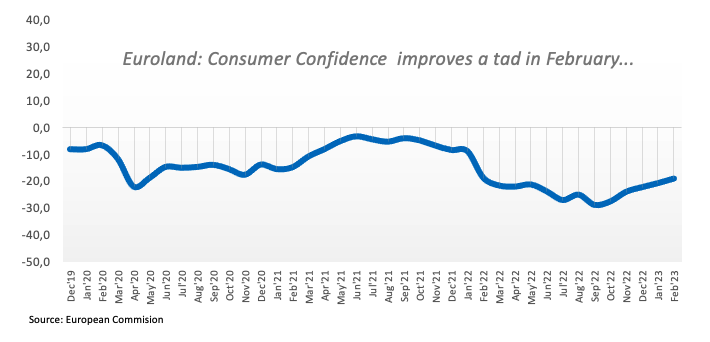
In the US, Durable Goods Orders and Pending Home Sales will be in the limelight seconded by the speech by FOMC P.Jefferson (permanent voter, centrist).
What to look for around EUR
Price action around EUR/USD remains depressed so far, although the pair seems to have met some motivation after bottoming out in the 1.0535/30 band earlier on Monday.
In the meantime, price action around the European currency should continue to closely follow dollar dynamics, as well as the potential next moves from the ECB after the bank has already anticipated another 50 bps rate raise at the March event.
Back to the euro area, recession concerns now appear to have dwindled, which at the same time remain an important driver sustaining the ongoing recovery in the single currency as well as the hawkish narrative from the ECB.
Key events in the euro area this week: EMU Consumer Confidence, Economic Sentiment (Monday) – France Flash Inflation Rate (Tuesday) – Germany/EMU Final Manufacturing PMI, Germany Unemployment Change, Flash Inflation Rate (Wednesday) – EMU Flash Inflation Rate, Unemployment Rate, ECB Accounts (Thursday) – Germany Balance of Trade, Final Services PMI, EMU Final Services PMI (Friday).
Eminent issues on the back boiler: Continuation of the ECB hiking cycle amidst dwindling bets for a recession in the region and still elevated inflation. Impact of the Russia-Ukraine war on the growth prospects and inflation outlook in the region. Risks of inflation becoming entrenched.
EUR/USD levels to watch
So far, the pair is gaining 0.06% at 1.0551 and a breakout of 1.0714 (55-day SMA) would target 1.0804 (weekly high February 14) en route to 1.1032 (2023 high February 2). On the flip side, the next support aligns at 1.0532 (monthly low February 27) seconded by 1.0481 (2023 low January 6) and finally 1.0328 (200-day SMA).
How difficult or easy is the projection of EUR/USD exchange rates? Ulrich Leuchtmann, Head of FX and Commodity Research at Commerzbank, believes that the analysis of EUR/USD is quite easy at present.
EUR/USD rising to 1.10 again is the most sensible forecast
“If the market bets on disinflation that is good for the Euro, if the focus is on the risk of inflation (as is the case right now) that is positive for the Dollar.”
“I am only trying to say that whenever the risk of inflation increases that is good for the Dollar, and this is neither affected by economic framework conditions nor small differences in the risks of inflation on either side of the Atlantic.”
“I cannot promise firmly that EUR/USD will rise to 1.10 again. Only that based on the information currently available this forecast is the most sensible one. That is how you should look at our projections.”
Market Strategist at UOB Group Quek Ser Leang noted further upside in USD/THB is expected to meet a solid hurdle around 35.57.
Key Quotes
“We highlighted last Monday (20 Feb, spot at 34.35) that USD/THB is likely to consolidate between 33.90 and 34.65. Our view was incorrect as USD/THB continues to rally (high of 35.00 last Friday).”
“Further USD/THB strength appears likely this week in view of the overbought conditions, USD/THB may find the major resistance at 35.57 difficult to break. On the downside, any pullback is likely to stay above the major support level at 34.60. On a shorter-term note, 34.85 is already quite a strong support level.”
- USD/JPY eases from a fresh YTD peak touched on Monday amid a modest USD downtick.
- The Fed-BoJ policy divergence acts as a tailwind for the pair and helps limit the downside.
- Investors now look forward to the US macro data to grab short-term trading opportunities.
The USD/JPY pair corrects from a fresh YTD top touched earlier this Monday and remains on the defensive through the first half of the European session. Spot prices, however, manage to hold above the 136.00 mark and seem poised to prolong the recent upward trajectory witnessed since the beginning of this month.
A softer tone surrounding the US Treasury bond yields trigger a modest US Dollar pullback from a seven-week high, which, in turn, is seen exerting some downward pressure on the USD/JPY pair. That said, a combination of factors acts as a tailwind for the major and helps limit the downside, warranting some caution before positioning for any meaningful depreciating move.
The Japanese Yen (JPY) is weighed down by dovish remarks from the incoming Bank of Japan (BoJ) Governor Kazuo Ueda, stressing the need to maintain the ultra-loose policy to support the fragile economy. Ueda further added that it is possible to push up prices and wages with monetary easing. This, along with a modest recovery in the US equity futures, undermines the safe-haven JPY.
Apart from this, expectations that the Federal Reserve will stick to its hawkish stance should act as a tailwind for the US bond yields and lend some support to the Greenback. Meanwhile, the divergent Fed-BoJ policy outlook supports prospects for the emergence of some dip-buying at lower levels and suggests that the path of least resistance for spot prices is to the upside.
Market participants now look forward to the US economic docket, featuring the release of Durable Goods Orders and Pending Home Sales data later during the early North American session. This, along with the US bond yields, will influence the USD price dynamics. Traders will further take cues from the broader risk sentiment to grab short-term opportunities around the USD/JPY pair.
Technical levels to watch
Sterling seems to be taking little notice of potentially improved trading and political relations between the UK and the EU. Economists at ING analyze the outlook of the GBP against the EUR and USD.
ECB looks like it has much further to hike than the BoE
“An improvement in UK-EU relations probably does little for Sterling in that it will not improve the broader trading environment between the UK and the EU. Instead, the macro-monetary settings of the two will continue to dominate. The ECB looks like it has much further to hike than the Bank of England and suggests that EUR/GBP continues to find support under 0.88.”
“GBP/USD will be vulnerable to continued Dollar strength and risks a move to 1.1850 this week.”
Economists at TD Securities discuss the outlook of the EUR/USD, USD/CAD and USD/JPY pairs.
Key support for S&P 500 aligns at 3950
“We have been biased to a tactical move lower in EUR/USD for some time. We continue to view 1.05 as the first major reassessment point for this bias, though we note that the 200-DMA will be rather crucial support. For USD/CAD, this point is 1.37 though we think this may could push higher if stocks fail to hold key supports (we think the key level here will be 3950 in the S&P 500).”
USD/JPY risks lean higher for now; 137 will be next key resistance (200-DMA) and is roughly where relative 1y1y OIS differential pit the pair. Failure to hold this resistance will likely need a break of 1.05 in EUR/USD and a push higher in terminal rate expectations (note that both broad USD variation and US/JP 1y1y OIS are solid drivers for USD/JPY).”
- GBP/USD continues to find some support and attracts some buyers near the 200-day SMA.
- A modest USD pullback from a multi-week high is seen as a key factor acting as a tailwind.
- Hawkish Fed expectations should help limit the USD losses and cap the upside for the pair.
The GBP/USD pair defends a technically significant 200-day Simple Moving Average (SMA) on Monday and attracts some buyers in the vicinity of the monthly low. Spot prices stick to intraday gains, around the 1.1965-1.1975 region through the early part of the European session and for now, seem to have snapped a three-day losing streak.
A modest US Dollar pullback from a seven-week high turns out to be a key factor providing a lift to the GBP/USD pair. The USD downtick, meanwhile, could be attributed to some profit-taking amid a softer tone surrounding the US Treasury bond yields and a recovery in the US equity futures. Any meaningful slide for the Greenback, however, seems elusive, warranting some caution before positioning for a further appreciating move for the major.
The prospects for further policy tightening by the Fed should act as a tailwind for the US bond yields and lend support to the USD. In fact, the markets seem convinced that the US central bank will stick to its hawkish stance for longer in the wake of stubbornly high inflation. The bets were reaffirmed by the stronger US PCE Price Index data released on Friday, which indicated that inflation isn't coming down quite as fast as hoped.
Moreover, the recent upbeat US macro data point to an economy that remains resilient despite rising borrowing costs and should allow the Fed to continue raising interest rates. Investors, meanwhile, remain worried about economic headwinds stemming from rapidly rising borrowing costs. This, along with geopolitical tensions, should limit losses for the safe-haven buck and keep a lid on the GBP/USD pair, at least for the time being.
In the absence of any relevant data from the UK, traders look to the US economic docket - featuring the release of Durable Goods Orders and Pending Home Sales data. This, along with the US bond yields and the broader risk sentiment, will influence the USD and provide some impetus to the GBP/USD pair. The aforementioned fundamental backdrop, meanwhile, suggests that the pair's intraday move-up could be seen as a selling opportunity.
Technical levels to watch
EUR/USD lost more than 100 pips last week. Dollar strength is set to keep the pair heavy, economists at ING report.
Like the Fed, the ECB remains very much in hawkish mode
“Investors fully subscribe to the ECB's message of a 50 bps hike on 16 March and then price a further 80 bps of tightening into year-end. This should be the key difference between the Fed and the ECB cycles. We think the Fed could be in a position to cut by year-end, while the ECB looks likely to keep rates at their peak throughout the majority of 2024.”
“For EUR/USD, we think the strong Dollar view will dominate. Expect 1.0500 to be tested, with a chance that it briefly trades down to the 1.0460.”
According to Economist Lee Sue Ann and Markets Strategist Quek Ser Leang at UOB Group, the continuation of the upside bias could encourage USD/CNH to retest the 7.0000 region ahead of 7.0200 in the next weeks.
Key Quotes
24-hour view: “Last Friday, we indicated that ‘as long as 6.8900 is not breached, USD could rise to 6.9300 before the risk of a more sustained pullback increases’. While USD did not break 6.8900 (low has been 6.9118), the anticipated USD strength exceeded our expectations by a wide margin as USD rocketed to a high of 6.9820. Further USD strength is not ruled out but deeply overbought conditions suggest the major resistance at 7.0000 is unlikely to come into view today. Support is at 6.9650, followed by 6.9550.”
Next 1-3 weeks: “We have expected USD to move higher since the start of the month. In our most recent narrative from last Friday (24 Feb, spot at 6.9160), we indicated that USD ‘has to break above 6.9300 within the next 1-2 days or the risk of an end to the USD strength will increase quickly’. Our view was not wrong even though we did not quite expect the manner in which USD blew past 6.9300 and surged to a high of 6.9820. The boost in upward momentum is likely to lead to further USD strength. The resistance levels to watch are at 7.0000 and 7.0200. The upside risk is intact as long as USD stays above 6.9220 (‘strong support’ level previously at 6.8700).”
Considering advanced prints from CME Group, open interest in natural gas futures markets shrank by around 1.8K contracts on Friday, keeping the choppiness well in place for the time being. In the same line, volume dropped for the second consecutive session, now by around 104.7K contracts.
Natural Gas: Next on the upside comes $3.20
Prices of the natural gas extended the rebound on Friday. However, the move was against the backdrop of shrinking open interest and volume, suggesting that the ongoing bounce could be short-lived. So far, further upside should meet the next hurdle at a Fibo retracement of the December-February drop near the $3.20 mark peer MMBtu.
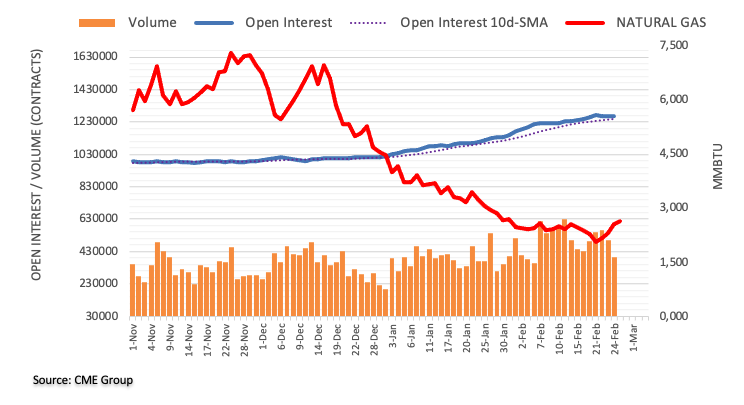
Further strength in USD/JPY seems likely in the near term, comment Economist Lee Sue Ann and Markets Strategist Quek Ser Leang at UOB Group.
Key Quotes
24-hour view: “While we highlighted last Friday that the bias for USD ‘is to the downside”, we indicated that ‘it remains to be seen if USD can break the strong support at 134.00’. USD came very close to taking out 134.00 as it dropped to a low of 134.05. The decline was, however, short-lived as USD lifted off and rocketed to a high of 136.51 in NY trade. The rapid rise appears to be overdone and USD is unlikely to advance much further. Today, USD is more likely to trade in a range, expected to be between 135.50 and 136.65.”
Next 1-3 weeks: “We have held a positive USD view for more than a week now. As USD struggles to reach our objective of 135.50, we highlighted last Friday (24 Feb, spot at 134.45) that the USD ‘strength appears to be coming to an end, but confirmation will come with a break of 134.00’. We did not anticipate the subsequent volatile price actions as USD dropped sharply but briefly to 134.05 before soaring to take out 135.50 and another strong resistance level at 136.20 (high has been 136.51). The strong boost in upward momentum is likely to lead to further USD strength. The next resistance level to watch is at 137.90. On the downside, the ‘strong support’ level has moved higher to 135.00 from 134.00.”
CME Group’s flash data for crude oil futures markets noted traders scaled back their open interest positions for the second session in a row on Friday, this time by around 14.2K contracts. Volume followed suit and dropped by around 114.6K contracts after two consecutive daily builds.
WTI could revisit the sub-$74.00 mark
Prices of the WTI added to Thursday’s gains on Friday, although the uptick was amidst diminishing open interest and volume, leaving the door open to a potential correction in the very near term. That said, the commodity should meet initial contention in the area of last week’s lows in the sub-$74.00 mark per barrel.
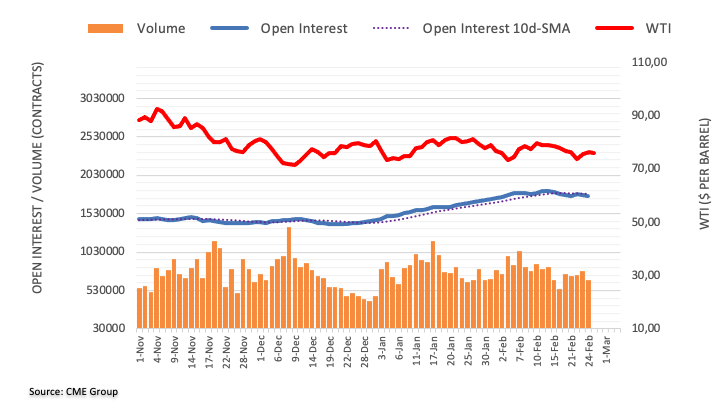
Kazuo Ueda’s comments today are causing only little movement on the Yen market for a change. This is going to be the case until he takes the office, in the view of Ulrich Leuchtmann, Head of FX and Commodity Research at Commerzbank.
Markets finally to interpret Ueda’s comments in a balanced way
“Those who had hoped that Ueda would initiate a trend reversal in one fell swoop probably have to abandon this hope. However, expectations of this nature had always been unrealistic in my view.”
“The market is now finally going to interpret Ueda’s comments in the way in which they are likely to be intended: balanced. He is not likely to be interested in upsetting Yen exchange rates before he even assumes his new role. He will have plenty of opportunity to do that once he has assumed his office…”
- Silver continues losing ground for the fourth straight day and refreshes the YTD low on Monday.
- Oversold oscillators on the daily chart help the XAG/USD to find support near the 61.8% Fibo.
- The setup still favours bearish traders and supports prospects for a further depreciating move.
Silver remains under some selling pressure for the fourth successive day and drops to a fresh YTD low during the first half of trading on Monday. The white metal currently trades just above the mid-$20.00s and seems vulnerable to prolonging the recent downfall witnessed since the beginning of this month.
Friday's convincing break and acceptance below a technically significant 200-day Simple Moving Average (SMA) adds credence to the negative outlook. That said, oscillators on the daily chart are flashing extremely oversold conditions, making it prudent to wait for some consolidation or a modest rebound before positioning for further losses.
Any attempted recovery, however, is more likely to meet with a fresh supply near the $21.00 mark. This, in turn, should cap the XAG/USD near the $21.30-$21.35 region, marking the 50% Fibonacci retracement level of the rally from October 2022. The latter should act as a pivotal point, which if cleared could prompt some near-term short-covering.
Bearish traders, meanwhile, take a breather near the 61.8% Fibo. level, below which the XAG/USD could accelerate the fall towards challenging the $20.00 psychological mark. The white metal could eventually drop to the $19.75-$19.70 intermediate support en route to the $19.15 horizontal zone and the $19.00 round-figure mark.
Silver daily chart
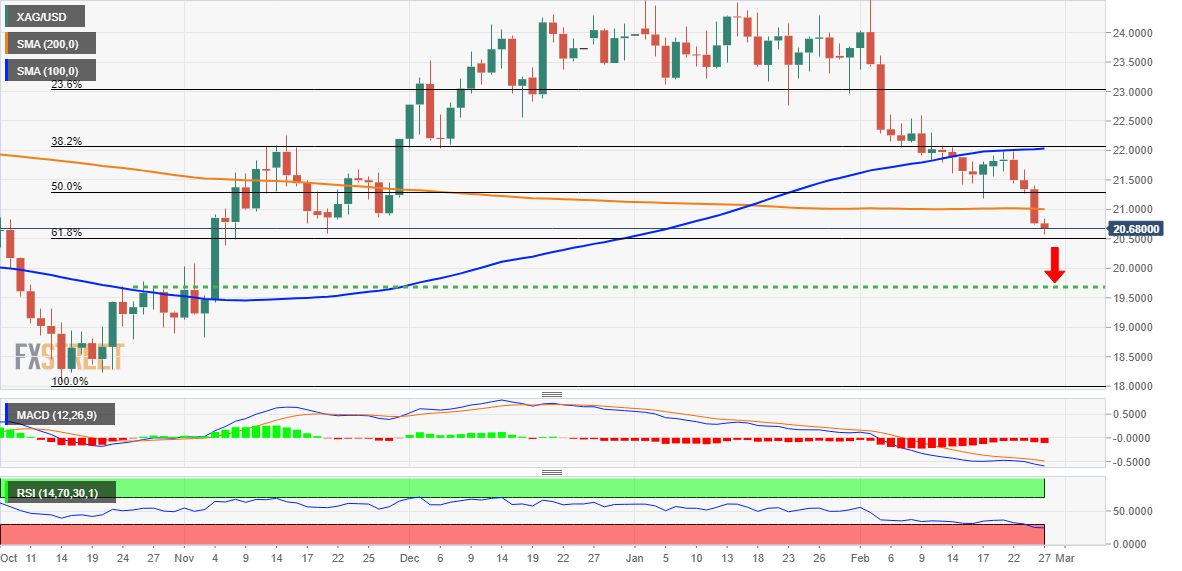
Key levels to watch
AUD/USD could extend the decline to the 0.6680 region in the short-term horizon, note Economist Lee Sue Ann and Markets Strategist Quek Ser Leang at UOB Group.
Key Quotes
24-hour view: “We highlighted last Friday that ‘despite the lackluster downward momentum, we continue to see room for AUD to test 0.6775 before a more sustained rebound is likely”. While our view for AUD to weaken was correct, instead of testing 0.6775, AUD plummeted to a low of 0.6719 before closing on a weak note at 0.6726 (-1.20%). Further AUD weakness is not ruled out but in view of the deeply oversold conditions, any decline today is unlikely to threaten the major support at 0.6680. On the upside, a breach of 0.6785 (minor resistance is at 0.6760) would indicate that the weakness in AUD has stabilized.”
Next 1-3 weeks: “Our most recent narrative was from last Thursday (23 Feb, spot at 0.6810), where we indicated that AUD ‘is likely to weaken further to 0.6775, possibly 0.6730’. Our view turned out to be correct as AUD plummeted to a low of 0.6719 on Friday. The outlook in AUD remains weak and the next levels to watch are at 0.6680 and 0.6630. All in all, only a breach of 0.6820 (‘strong resistance’ level previously at 0.6890) would indicate that the AUD weakness that started more than a week ago has come to an end.”
Economists at Commerzbank see upside potential in EUR/CHF, but only moderately.
CHF is likely to be less in demand as a safe haven
“With the ECB likely to raise its key rate more strongly by the middle of the year, we see depreciation pressure on the Swiss Franc against the EUR in the coming months.”
“Moreover, due to easing concerns about an energy crisis and recession in Europe, the CHF is likely to be less in demand as a safe haven.”
“The depreciation potential of the Franc is likely to remain limited in view of the SNB and possible interventions against an excessively weak franc though, especially if the inflation picture should cloud over again contrary to our forecasts.”
Source: Commerzbank Research
Open interest in gold futures markets rose by more than 1K contracts on Friday, resuming the uptrend after the previous daily drop according to preliminary readings from CME Group. On the other hand, volume shrank by nearly 9.5K contracts.
Gold: Next on the downside comes $1800
Friday’s daily retracement in gold prices was amidst increasing open interest, which is supportive of further decline in the very near term and with the immediate target at the key contention area around $1800 per ounce troy.
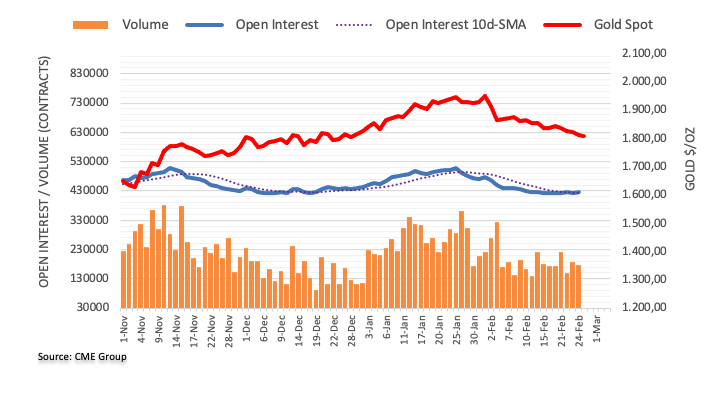
In the opinion of Economist Lee Sue Ann and Markets Strategist Quek Ser Leang at UOB Group, GBP/USD is expected to accelerate losses on a break below the 1.1870 level.
Key Quotes
24-hour view: “We highlighted last Friday that GBP ‘is likely to edge lower’ but we held the view that ‘the support at 1.1950 is unlikely to come under threat’. The anticipated decline exceeded our expectations as GBP cracked 1.1950 and dropped to 1.1928. Despite the decline, downward momentum has not increased much. That said, GBP is likely to weaken further even though a sustained decline below 1.1915 is unlikely (next support is at 1.1870). Resistance is at 1.1975, followed by 1.2000.”
Next 1-3 weeks: “Last Friday (24 Feb, spot at 1.2020), we highlighted that ‘downward momentum is showing signs of building but GBP has to break the major support at 1.1950 before a sustained decline is likely’. We did not quite expect the rapid increase in downward momentum as GBP cracked 1.1950 in NY trade and dropped to 1.1928. While the price actions suggest the risk for GBP is on the downside, it has to crack another major support at 1.1870 before it can continue to decline. The downside risk is intact as long as 1.2050 (‘strong resistance’ level was at 1.2105 last Friday) is not breached.”
- The index picks up pace past the 105.00 mark on Monday.
- US 2-year yields reach new multi-year peaks past 4.80%.
- Durable Goods Orders, housing data next of note in the docket.
The USD Index (DXY), which gauges the greenback vs. a bundle of its main competitors, advances marginally and maintains the multi-session rally well in place for the time being.
USD Index looks at key data
The index rises for the fifth consecutive session and looks to extend the recent breakout of the key barrier at 105.00 the figure at the beginning of the week, always underpinned by the firmer tone in US yields and persevering speculation of a potential tighter-for-longer stance by the Fed.
The above appears also propped up by recent solid results from US fundamentals, which in turn accentuate the resilience in the US economy.
So far, and according to FedWatch Tool by CME Group, the probability of a 25 bps rate hike at the March 22 meeting is at just over 70%, from nearly 82% a week ago.
In the US data space, all the attention will be on the release of Durable Goods Orders seconded by Pending Home Sales and the speech by FOMC P.Jefferson (permanent voter, centrist).
What to look for around USD
The dollar remains bid north of the 105.00 barrier amidst the generalized lack of traction in the risk complex at the beginning of the week.
The probable pivot/impasse in the Fed’s normalization process narrative is expected to remain in the centre of the debate along with the hawkish message from Fed speakers, all after US inflation figures for the month of January showed consumer prices are still elevated, the labour market remains tight and the economy maintains its resilience.
The loss of traction in wage inflation – as per the latest US jobs report - however, seems to lend some support to the view that the Fed’s tightening cycle have started to impact on the still robust US labour markets somewhat.
Key events in the US this week: Durable Goods Orders, Pending Home Sales (Monday) – Advanced Goods Trade Balance, FHFA House Price Index, CB Consumer Confidence (Tuesday) – MBA Mortgage Approvals, Final Manufacturing PMI, ISM Manufacturing, Construction Spending (Wednesday) – Initial Jobless Claims (Thursday) – Final Services PMI, ISM Non-Manufacturing (Friday).
Eminent issues on the back boiler: Rising conviction of a soft landing of the US economy. Persistent narrative for a Fed’s tighter-for-longer stance. Terminal rates near 5.5%? Fed’s pivot. Geopolitical effervescence vs. Russia and China. US-China trade conflict.
USD Index relevant levels
Now, the index is gaining 0.02% at 105.28 and faces the next hurdle at 105.35 (monthly high February 27) seconded by 105.63 (2023 high January 6) and then 106.48 (200-day SMA). On the other hand, the breach of 103.43 (55-day SMA) would open the door to 102.58 (weekly low February 14) and finally 100.82 (2023 low February 2).
- USD/CAD attracts some dip-buying on Monday and draws support from a combination of factors.
- Sliding Oil prices undermines the Loonie and acts as a tailwind for the pair amid a stronger USD.
- The fundamental backdrop favours bullish traders and supports prospects for a further move up.
The USD/CAD pair attracts some buying following an intraday dip to sub-1.3600 levels on Monday and hits a fresh daily high during the early European session. The pair is currently placed around the 1.3625 region, though remains below its highest level since January 6 touched on Friday.
Crude Oil prices meet with a fresh supply on the first day of a new week, which is seen undermining the commodity-linked Loonie and lending support to the USD/CAD pair. Worries that rapidly rising borrowing costs will dampen economic growth and dent fuel demand overshadow the prospect of lower exports from Russia. This, in turn, fails to assist Oil prices to build on a two-day-old recovery move from a nearly three-week low touched last Thursday.
Apart from this, bets that the Bank of Canada (BoC) will pause the policy-tightening cycle, bolstered by softer Canadian consumer inflation figures released last week, weighs on the domestic currency. In contrast, the Federal Reserve is expected to stick to its hawkish stance in the wake of stubbornly high inflation. This, along with a softer risk tone, keeps the safe-haven US Dollar pinned near a multi-week high and acts as a tailwind for the USD/CAD pair.
The prospects for further policy tightening by the Fed were reaffirmed by the stronger US PCE data on Friday, which indicated that inflation isn't coming down quite as fast as hoped. Adding to this, the incoming positive US macro data points to an economy that remains resilient despite rising borrowing costs and fueled hawkish Fed expectations. This remains supportive of elevated US Treasury bond yields and continues to boost the Greenback.
The aforementioned fundamental backdrop seems tilted firmly in favour of bulls and suggests that the path of least resistance for the USD/CAD pair is to the upside. Further, the technical picture also indicates a bullish continuation pattern may has formed after Friday's strong up day, which also helped to confirm the major trendline break of the previous two sessions. This continuation pattern could see prices rise up to the 1.3800 level conditional on confirmation from a break above Friday's high at 1.3665.
Market participants now look to the US economic docket, featuring the release of Durable Goods Orders and Pending Home Sales data. This, along with Oil price dynamics, should provide a fresh impetus to the USD/CAD pair and allow traders to grab short-term opportunities.
Technical levels to watch
Here is what you need to know on Monday, February 27:
The US Dollar stays resilient against its major rivals early Monday after having registered impressive gains following the stronger-than-expected PCE inflation data on Friday. Consumer and business sentiment survey from the Eurozone will be watched closely by market participants. Later in the day, the US economic docket will feature Durable Goods Orders and Pending Home Sales data for January.
The US Bureau of Economic Analysis reported on Friday that the Core Personal Consumption Expenditures (PCE) Price Index, the Fed's preferred gauge of inflation, edged higher to 4.7% in January from 4.6% in February on the back of a 0.6% monthly increase. The US Dollar Index (DXY) rallied during the American trading hours and climbed above 105.00 for the first time since early January. Following a two-day slide, the benchmark 10-year US Treasury bond yield regained its traction and advanced toward 4%. Early Monday, the DXY stays relatively quiet slightly below 105.50 and the 10-year US T-bond yield moves sideways at around 3.95%. Meanwhile, US stock index futures trade flat in the European morning following the selloff witnessed in Wall Street's main indexes ahead of the weekend.
EUR/USD lost more than 100 pips last week and continued to edge lower early Monday. The pair was last seen trading at its lowest level since January 6 at 1.0535. Ahead of the weekend, EU member stated approved new sanctions against Russia that include new trade bans and export restrictions. European Commission will publish Economic Sentiment Indicator, Business Climate and Consumer Sentiment Indicator readings for February later in the session.
GBP/USD broke below on Friday and fell sharply heading into the weekend. The pair stays under modest bearish pressure and trades in negative territory below 1.1950 in the European morning. The Times reported on Sunday that British Prime Minister Rishi Sunak may have obtained 'significant concessions' in a looming Brexit deal. British Deputy Prime minister Dominic Raab told BBC’s Laura Kuenssberg on Sunday that the government had made 'great progress' negotiating with the EU. These developments, however, don't seem to be helping Pound Sterling find demand for the time being.
USD/JPY surged to its highest level in two months above 136.00 on Friday. The pair fluctuates in a relatively tight channel at around 136.50 on Monday. Bank of Japan (BoJ) Governor designate Kazuo Ueda said earlier in the day that it will be appropriate to continue monetary easing and noted that it will be possible to achieve 2% inflation by doing that.
Gold price registered losses every day last week and closed at its lowest level since late December. XAU/USD stays under modest bearish pressure but manages to hold above $1,800.
Bitcoin lost more than 3% on Friday and stayed quiet on Saturday before staging a technical correction on Sunday. BTC/USD was last seen moving sideways at around $23,400. Ethereum rose nearly 3% on Sunday and reclaimed $1,600. Early Monday, ETH/USD holds steady slightly below $1,650.
Gold price is sitting at the lowest level in two months. XAU/USD is primed to test $1,794 amid a Bear Cross, FXStreet’s Dhwani Mehta reports.
Daily closing above resistance at $1,821 needed to attempt a meaningful recovery
“Gold price is maintaining its downtrend while within a falling wedge formation since peaking at $1,960 on February 2.”
“XAU/USD is likely to test the falling trendline support at $1,794 after it breached several crucial demand area last week. At that level, the bullish 100-Daily Moving Average (DMA) coincides. Ahead of that level, the $1,800 level will likely offer stiff resistance to Gold sellers.”
“On the flip side, Gold price needs to yield a daily closing above the falling trendline resistance at $1,821 to attempt a meaningful recovery. In doing so, the bright metal will see an upside break from the falling wedge.”
- NZD/USD drops to the lowest levels in three months, grinds near intraday low of late.
- Downbeat NZ Retail Sales, comments from RBNZ’s Conway keep bears hopeful.
- US Dollar cheers strong inflation clues, hawkish Fed talks amid upbeat yields.
- US Durable Goods Orders, risk catalysts eyed for fresh impulse.
NZD/USD bears keep the reins at the lowest levels since November 2022, down half a percent near 0.6130 during early Monday, as downbeat New Zealand (NZ) catalysts contrast with the US Dollar demand.
That said, NZ Retail Sales marked -0.6% QoQ figure for the fourth quarter (Q4) earlier in the day, versus 1.5% expected and 0.4% prior.
On the other hand, Reserve Bank of New Zealand (RBNZ) Chief Economist Paul Conway said, “As interest rates rise, I expect consumption to slow.”
Meanwhile, strong US inflation-linked data joined the Fed policymakers’ support for higher rates to propel the Fed fund futures to above 5.30%, versus 5.10% expected by the US central bank in December. The same joins the latest bout of sanctions on Russia from the West to escalate the market’s fears of more geopolitical tension, which in turn underpins the US Dollar’s haven demand.
US Dollar Index (DXY) renews its intraday high around 105.32 following the initial pullback from a seven-week high, while tracing upbeat US Treasury bond yields. It’s worth noting, US 10-year Treasury yields reverse the early-day losses to around 3.95%. Further, the two-year counterparts jump back towards the highest levels since November 2022, marked the previous day, as bond bears poke the 4.83% level by the press time. Further, the S&P 500 Futures lick its wounds with mild gains after the Wall Street benchmark posted the biggest weekly slump of 2023.
Moving ahead, the US Durable Goods Orders for January, expected -4.0% versus 5.6% prior, will be important to watch for clear directions ahead of Wednesday’s official activity data from China.
Technical analysis
A daily closing below the 200-DMA, around 0.6170 by the press time, directs NZD/USD bears towards July 2022 low near 0.6060.
Bank of Japan (BoJ) Governor designate Kazuo Ueda continues to speak on the monetary policy and inflation outlook during his appearance on Monday.
Key quotes
BoJ’s overshooting commitment is aimed at exerting powerful announcement effects on policy but need to be mindful of risk of inflation overshooting too much.
Not considering altering 2% inflation target now.
Will refrain from committing to maintaining BoJ’s price target at 2% during my expected five-year term as BoJ governor.
Must scrutinize whether BoJ’s steps taken so far can prevent deterioration of market function.
Won't comment on what further steps are available, and when they can be taken, in case BoJ’s steps taken so far are not enough to ease market strains.
At present positive signs are emerging on trend inflation, there's no immediate need to change pledge to meet 2% inflation target as quickly as possible.
Related reads
- Dollar soars above 136.00 JPY, 2023 peak – US January PCE up sharply
- GBP/JPY Price Analysis: Further downside below 163.00 appears more likely
Economist Lee Sue Ann and Markets Strategist Quek Ser Leang at UOB Group hinted at the likelihood that EUR/USD could revisit the 1.0485 level in the next few weeks.
Key Quotes
24-hour view: “Our view last Friday was that ‘the bias for EUR is still on the downside even though it remains to be seen if it can maintain a foothold below the major support at 1.0570’. EUR cracked 1.0570 easily and dropped to 1.0534 before settling at 1.0546 (-0.46%). While downward momentum is showing tentative signs of slowing, EUR could dip to 1.0520 before stabilizing. The major support at 1.0485 is unlikely to come into view today. On the upside, a breach of 1.0600 (minor resistance is at 1.0580) would indicate that the weakness in EUR has stabilized.”
Next 1-3 weeks: “We have expected EUR to weaken for more than a week now. In our latest narrative from last Friday, we indicated EUR ‘is likely to weaken further’. We added, ‘a break of the major support at 1.0570 could trigger a rapid drop, as the next significant support is some distance away at 1.0485’. EUR took out 1.0570 in Ldn trade even though the subsequent decline was not as sharp as expected. However, as long as EUR stays below 1.0625 (‘strong resistance’ level was at 1.0670 last Friday), it is likely to continue to weaken toward 1.0485.”
FX option expiries for Feb 27 NY cut at 10:00 Eastern Time, via DTCC, can be found below.
- EUR/USD: EUR amounts
- 1.0460 757m
- 1.0500 1.5b
- 1.0550 1b
- 1.0600 625m
- 1.0700 1.2b
- USD/JPY: USD amounts
- 133.00 1.1b
- 137.00 1.0b
- AUD/USD: AUD amounts
- 0.6680 1.1b
- 0.6800 1.1b
- 0.6950 539m
- USD/CAD: USD amounts
- 1.3595 1b
- GBP/JPY takes offers to extend pullback from one-week-old horizontal resistance.
- Looming bear cross on MACD, RSI retreat add strength to downside bias.
- 50-SMA restricts immediate downside, bulls need validation from monthly high.
GBP/JPY prints mild losses around 162.75-80 as it pares the previous day’s gains around the intraday low heading into Monday’s London open.
In doing so, the cross-currency pair justifies the early-day Doji candlestick formation, as well as the U-turn from a one-week-old horizontal resistance line.
Adding strength to the downside bias is the RSI (14) retreat from the +50.0 area, often considered an overbought zone, as well as the looming bear cross on the MACD.
That said, the GBP/JPY bears are well-set to visit the 50-SMA support near 162.00.
Following that, a two-week-old ascending support line precedes an upward-sloping trend line from February 03 to challenge the GBP/JPY bears around 161.45 and 161.20 in that order.
It should be noted that the pair’s weakness past 161.20 will have the 161.00 round figure as the last defense, a break of which could make it vulnerable to challenge the mid-month swing low surrounding 160.00.
On the contrary, recovery moves remain elusive below the immediate resistance line, around 163.25 by the press time. Following that, the monthly high of 163.76 may act as an extra filter towards the north.
If the GBP/JPY bulls keep the reins past 163.76, the early December 2022 low near 164.00 will be in the spotlight ahead of directing the quote towards the last September’s peak of 167.22.
GBP/JPY: Four-hour chart
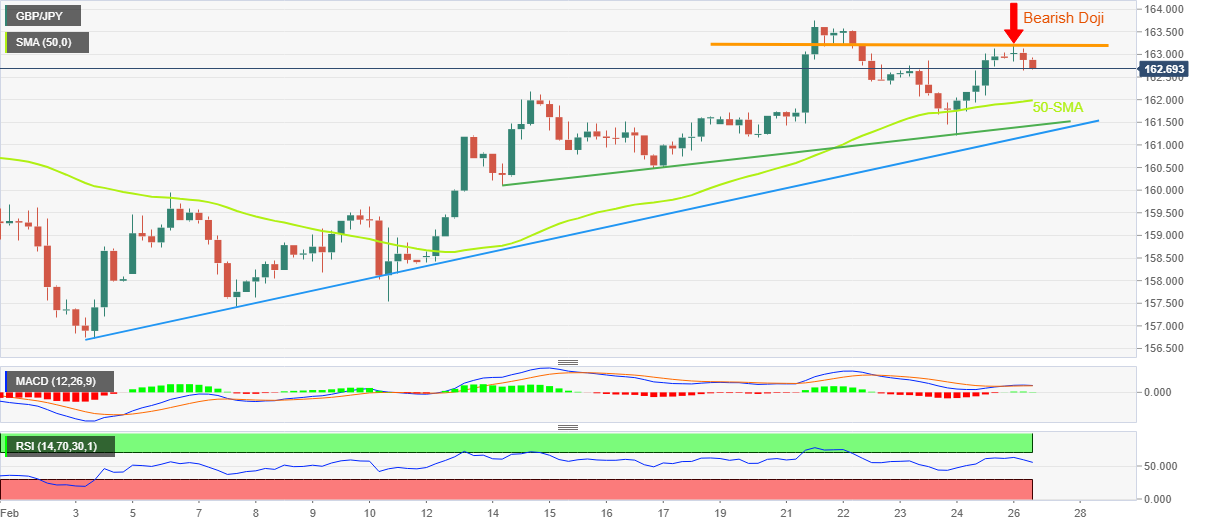
Trend: Further downside expected
- AUD/USD has refreshed its seven-week low at 0.6700 amid geopolitical tensions and rising hawkish Fed bets.
- The USD Index has refreshed its day’s high above 104.90 and is expected to recapture the 105.00 resistance.
- A higher-than-projected Australia GDP will accelerate troubles for the RBA.
The AUD/USD pair has refreshed its seven-week low near the round-level support of 0.6700. More downside in the Aussie asset looks favored as investors are channelizing their funds into the US Dollar Index (DXY). Investors are favoring investment in the USD Index to dodge volatility inspired by a revival in consumer spending in the United States and escalating geopolitical tensions.
The USD Index has refreshed its day’s high above 104.90 and is expected to recapture the 105.00 resistance. Western nations are still concerned about the rumors of China’s support to Russia in providing arms and ammunition against Ukraine.
United States National Security Advisor Jake Sullivan said on CNN’s “State of the Union,” China’s stance on the Russian invasion of Ukraine puts it in an “awkward” position internationally and any weapons support to Russia would come with “real costs.”
Risk-perceived assets like S&P500 futures are facing heat of the geopolitical tensions. The 500-stocks futures basket has surrendered the majority of gains earned in morning, portraying further strengthening of the risk-aversion theme. Meanwhile, the return generated on 10-year US Treasury yields is hovering around 3.94%.
Higher-than-projected US consumer spending in January has highlighted the fact that the battle between the Federal Reserve (Fed) and the sticky inflation is getting brawled further. Fed chair Jerome Powell has been left with no other option than to tap hawkish measures to bring down the stubborn inflation.
On the Australia front, recession fears are escalating as inflation is not showing signs of deceleration, which is bolstering the case of further policy tightening by the Reserve Bank of Australia (RBA). This week, Australia’s Gross Domestic Product (GDP) (Q4) numbers will be keenly watched. The quarter GDP is seen higher at 0.9% vs. the former release of 0.6%. This might create more troubles for RBA Governor Philip Lowe as higher activities will favor further hikes.
- EUR/USD remains depressed near the seven-week low as bears poke intraday bottom.
- Upbeat US Treasury bond yields, hawkish Fed bets contrast with hopes of higher ECB rates to challenge Euro pair sellers.
- US data, UN Human Rights Council session eyed for intraday directions.
EUR/USD bears poke the 1.0540-30 support confluence surrounding the seven-week low amid the lackluster markets heading into Monday’s European session. In doing so, the major currency pair struggles to justify hawkish European Central Bank (ECB) concerns ahead of the key US data and geopolitical events.
That said, the US Dollar Index (DXY) grinds near an intraday high of around 105.30 following the initial pullback from a seven-week high. The US Dollar’s recent run-up could be linked to the strong US Treasury bond yields, as well as hawkish Fed talks and fears of more geopolitical tension surrounding Ukraine.
It’s worth noting that upbeat US inflation-linked data from the US joined the Fed policymakers’ support for higher rates to propel the Fed fund futures to above 5.30%, versus 5.10% expected by the US central bank in December. The same joins the latest bout of sanctions on Russia from the West to escalate the market’s fears of a more geopolitical burden on the bloc, which in turn increases the odds of a recession in the Old continent even if the policymakers have been against the same of late.
It’s worth observing that ECB President Christine Lagarde advocated the need for higher rates during the weekend while speaking to the Helsingin Sanomat. On the same line, ECB policymaker and Bundesbank Chief Joachim Nagel said on Friday, he “can't rule significant further rate hikes after March.”
Amid these plays, the US 10-year Treasury yields reverse the early-day losses to around 3.95%. Further, the two-year counterparts jump back towards the highest levels since November 2022, marked the previous day, as bond bears poke the 4.83% level by the press time. Further, the S&P 500 Futures lick its wounds with mild gains after the Wall Street benchmark posted the biggest weekly slump of 2023.
Moving ahead, the start of the U.N. Human Rights Council session in Geneva becomes crucial for the EUR/USD pair watchers ahead of the US Durable Goods Orders for January, expected -4.0% versus 5.6% prior. Considering the downbeat expectations from the US data, the pair sellers may witness further hardships in breaking the 1.0540-30 key support.
Technical analysis
An 11-week-old ascending support line joins the 200-bar Exponential Moving Average (EMA) to highlight the 1.0540-30 as the key support for the EUR/USD bears to watch during the quote’s further downside. That said, oversold RSI conditions add strength to the stated support zone.
Bank of Japan (BoJ) Governor designate Kazuo Ueda is shedding more light on the monetary policy during his appearance on Monday.
Key quotes
Possible to push up prices, wages with monetary easing.
Trend inflation must heighten sharply for boj to shift to monetary tightening.
It's not as if I have no ideas on how to tweak policy in future, but what exactly the BoJ will do will change depending on future economic developments.
Interest rates remain low under current monetary easing, helping corporate investment.
Monetary policy alone cannot raise prices immediately .
Inflation is not determined by monetary policy alone.
If external shock is big and prolonged, big monetary easing may not necessarily lead to price rises.
BoJ-govt joint statement's mention of need for govt to sustain market trust in long-term finances is important.
BoJ has purchased JGBs as part of efforts to achieve 2% inflation target.
- BoJ Ueda sees the current monetary policy as appropriate to achieve the 2% inflation target confidently.
- USD/JPY has delivered a breakout of the Inverted H&S pattern that conveys a bullish reversal.
- An oscillating in the bullish range of 60.00-80.00 by the RSI (14) indicates more upside ahead.
The USD/JPY pair is struggling to extend recovery above the immediate resistance of 136.40 in the early European session. The asset has turned sideways as investors are awaiting the release of the United States Durable Goods Orders data for fresh cues. The US Dollar Index (DXY) has faced barricades around 104.90 but is expected to continue its upside to near the 105.00 resistance as investors’ risk appetite has faded dramatically.
Meanwhile, dovish commentary from Bank of Japan (BoJ) Governor Nominee Kazuo Ueda is impacting the Japanese Yen. BoJ Ueda sees the current monetary policy as appropriate to achieve the 2% inflation target confidently.
USD/JPY has delivered a breakout of the Inverted Head and Shoulder chart pattern on a four-hour scale that conveys a bullish reversal after a prolonged consolidation. The impulse of the asset has turned bullish after a confident break above the horizontal resistance plotted from December 28 high at 134.50.
The US Dollar bulls are getting strength from the 50-period Exponential Moving Average (EMA) at 134.60.
An oscillating in the bullish range of 60.00-80.00 by the Relative Strength Index (RSI) (14) indicates a continuation of the upside.
Should the asset break above the intraday high at 136.56, US Dollar bulls will drive the asset toward December 12 high at 137.48 followed by the horizontal resistance placed from December 15 high at 138.18.
Alternatively, a confident break below February 16 low at 133.60 will negate the Inverted H&S formation and will drag the asset toward February 6 high around 133.00 and February 10 high at 131.65.
USD/JPY four-hour chart
-638130726810696649.png)
- USD/MXN retreats from intraday high, fails to extend the previous week’s rebound from the lowest levels since April 2018.
- US Dollar struggles for clear directions after posting the heaviest run-up since September 2022 amid hawkish Fed concerns.
- Mixed risk catalysts, sluggish bond markets keep Mexican Peso illiquid ahead of US Durable Goods Orders.
USD/MXN aptly portrays the market’s inaction during early Monday as the Mexican Peso (MXN) pair seesaws around $18.40, after bouncing off the lowest levels in nearly five years.
In doing so, the USD/MXN pair seesaws around the intraday high as the US Dollar seeks the next catalyst to extend the previous week’s run-up. It should be noted that the upbeat US data, mainly surrounding inflation, joined hawkish Fed talks and upbeat Treasury bond yields to underpin the US Dollar’s biggest weekly run-up since September 2022 the last week. That said, the US Dollar Index (DXY) renews its intraday high around 105.30 following the initial pullback from a seven-week high. In doing so, the greenback’s gauge versus the six major currencies remains firmer for the fifth consecutive day.
Mixed concerns surrounding Russia and mildly offered Oil price seems to challenge the USD/MXN traders amid a light calendar ahead of the US Durable Goods Orders for January, expected -4.0% versus 5.6% prior.
Adding strength to the market’s inaction are the dicey US Treasury bond yields. While tracing the same, the US 10-year Treasury yields reverse the early-day losses to around 3.95%. Further, the two-year counterparts jump back towards the highest levels since November 2022, marked the previous day, as bond bears poke the 4.83% level by the press time.
Against this backdrop, t the S&P 500 Futures lick its wounds with mild gains after the Wall Street benchmark posted the biggest weekly slump of 2023.
At home, hawkish concerns after Banxico’s latest 0.50% rate hike keep the USD/MXN bears hopeful.
Moving on, US PMIs for February and second-tier data from Mexico will entertain USD/MXN traders amid an anticipated corrective bounce.
Technical analysis
Thursday’s Doji near multi-month low joins oversold RSI (14) to suggest corrective bounce in the USD/MXN prices. However, buyers remain off the table unless witnessing sustained trading beyond January’s low surrounding $18.56.
- Asian stocks are displaying a cautious mood as the Fed is preparing to push interest rates above 5%.
- The PBoC has promised an expansionary monetary policy to spurt the growth rate.
- Oil prices are expected to rebound amid deepening supply worries.
Markets in the Asian domain are demonstrating precaution as enlarging consumer spending in the United States has propelled the risk of more rates by the Federal Reserve (Fed). S&P500 futures have managed to add some gains after a weak Friday, however, the downside seems warranted. The strong labor market in the US economy despite the lay-off saga by big techies has propelled the chances of a 5% terminal rate achievement by the Fed sooner.
At the press time, Japan’s Nikkei225 eased 0.19%, SZSE Component dropped 0.48%, Hang Seng surrendered 0.49%, and Nifty50 tumbled 0.63%.
Investors are confused about the US labor market as at one place, payrolls are skyrocketing and at another big tech boys are laying-off employees. Whatever the case, consumer spending looks no stopping around and is fueling the expectations of further policy contraction.
Chinese stocks have failed to find strength despite a dovish People’s Bank of China (PBoC) report. The central bank has promised to accelerate overall consumption as the economy needs monetary stimulus after the rollback of pandemic controls. The report conveys “This year's monetary policy should be precise and strong, and not only focus on supporting the expansion of domestic demand, but also take into account longer-term economic growth and price stability.”
Meanwhile, Japanese equities are facing immense heat as the successor of Bank of Japan (BoJ) Governor Haruhiko Kuroda is considering the current expansionary policy as appropriate to keep inflation at heights. BoJ Governor Nominee Kazuo Ueda is of the view that the current rise in inflation is backed by international forces, therefore achievement of pre-pandemic levels is highly required to keep inflation elevated.
On the oil front, the oil price has corrected to near $76.00 after a sharp upside move. However, the upside looks favored as supply worries have deepened after Russia opt for significant supply cuts to retaliate against sanctions imposed by Western allies.
- GBP/USD fades bounce off a seven-week-old ascending support line.
- Oversold RSI (14) challenges sellers but bearish MACD signals, sustained trading below 200-SMA keeps buyers off the table.
- UK PM Rishi Sunak, European Commission President Ursula von der Leyen’s Brexit deal news is key.
GBP/USD portrays the pre-event anxiety as it wobbles around mid-1.1900s ahead of the key Brexit announcements scheduled for release during early Monday.
Also read: GBP/USD struggles to justify Brexit hopes around 1.1950 amid hawkish Fed concerns
In doing so, the Cable pair fades the previous day’s bounce off an upward-sloping support line from early January amid the oversold RSI conditions. However, the quote’s sustained trading below the 200-SMA and the bearish MACD signals keep the GBP/USD bears hopeful of breaking the 1.1930 immediate support.
Following that, the monthly low of 1.1915 and the 1.1840 can act as extra filters towards the south before directing the GBP/USD price to September 2022 high near 1.1740.
It’s worth noting that tops marked in the last October, around 1.1645 and 1.1500, could lure the Cable bears past 1.1740.
On the flip side, a one-week-old descending resistance line, close to the 1.2000 psychological magnet, restricts immediate recovery moves of the GBP/USD pair.
Even if the quote rises past 1.2000, a downward-sloping resistance line from early February, near 1.2135 at the latest, should challenge the GBP/USD buyers.
Also important to note is that the Cable pair bulls remain off the table unless witnessing the pair’s sustained trading beyond the 200-SMA, close to 1.2190 by the press time.
GBP/USD: Four-hour chart
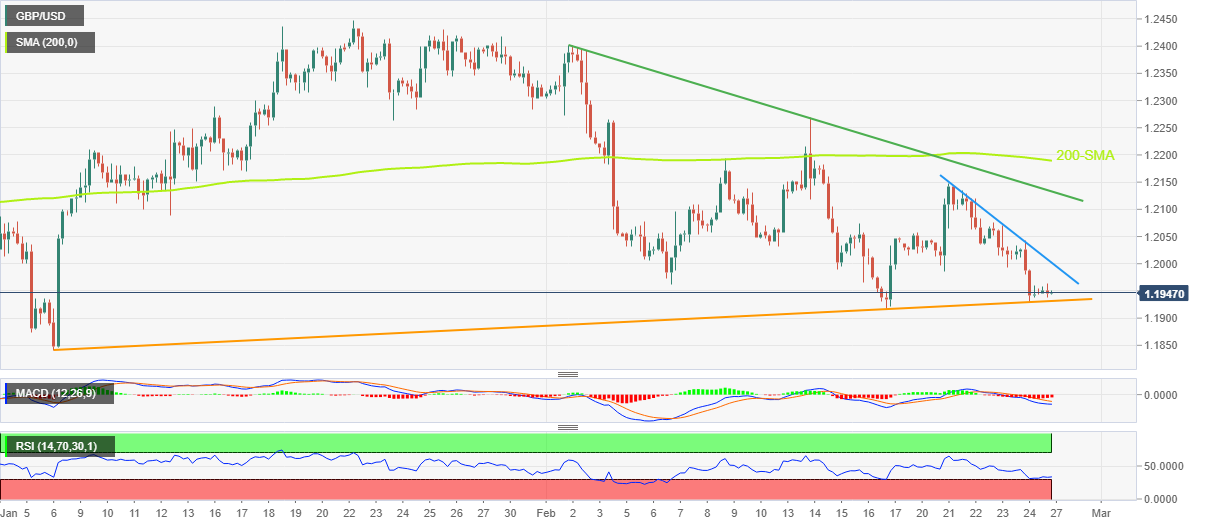
Trend: Further downside expected
- USD/INR struggles for clear directions after five-week uptrend, grinds higher of late.
- Hawkish Fed concerns, upbeat US Treasury bond yields underpin US Dollar strength.
- RBI’s hawkish mood contrasts with fears of easy growth figures to weigh on Indian Rupee.
- US data, risk catalysts eyed for clear directions past India Q3 GDP.
USD/INR seesaws around 82.90 as bulls take a breather following a five-week winning streak during early Monday. In doing so, the Indian Rupee (INR) pair portrays the traders’ anxiety ahead of the key third quarter (Q3) Indian Gross Domestic Product (GDP) for the Fiscal Year 2023 (FY2023).
Despite the pre-data anxiety, the hopes of softer FY2023 Q3 GDP figures, 4.6% versus 6.3% prior, join the hawkish Federal Reserve (Fed) concerns to keep USD/INR buyers hopeful. That said, the Reserve Bank of India’s (RBI) readiness to tame inflation, even at the cost of higher rates, seems to challenge the Indian Rupee bears.
Even so, the strong US inflation clues join geopolitical fears surrounding China and Russia, as well as hawkish Fed concerns, to keep the USD/INR buyers hopeful. That said, the US Dollar Index (DXY) makes rounds to its intraday high of around 105.30 following the initial pullback from a seven-week high. In doing so, the greenback’s gauge versus the six major currencies remains firmer for the fifth consecutive day.
It’s worth observing that market bets for the Fed fund futures hint at the 5.30% interest rate for late 2023, versus the US central bank’s forecast of a near 5.10% peak rate.
Against this backdrop, the US 10-year Treasury yields reverse the early-day losses of around 3.95%. Further, the two-year counterparts jump back towards the highest levels since November 2022, marked the previous day, as bond bears poke the 4.83% level by the press time. Further, the S&P 500 Futures lick its wounds with mild gains after the Wall Street benchmark posted the biggest weekly slump of 2023.
Looking forward, a light calendar on Monday and the pre-data anxiety may restrict USD/INR moves.
Technical analysis
A three-week-old rising wedge chart formation suggests a short-term upward grind of the USD/INR prices between 83.25 and 82.65.
- NZD/USD has printed a fresh three-month low at 0.6150 amid the risk-off market mood.
- Federal Reserve looks set to push interest rates above 5% to contain sticky inflation.
- Reserve Bank of New Zealand Conway sees the terminal rate at 5.50% as higher interest rates are still required to cool the economy.
- NZD/USD has delivered a breakdown of the Inverted Flag pattern and is now prone to more downside.
NZD/USD has refreshed its three-month low below 0.6148 in the Asian session. The kiwi asset has been dumped by the market participants amid weak New Zealand Retail Sales data and rising stakes for the continuation of policy tightening by the Federal Reserve (Fed).
The US Dollar Index (DXY) has revived firmly after a subdued opening and has reached to near 104.90 as the risk-off impulse is strengthening further. S&P500 futures have shown some recovery on Monday morning after reporting significant losses last week, portraying a caution in the overall risk-aversion theme. The odds of more rates announcement by the Federal Reserve to contain persistent inflation has soared the recession fears, which has had a devastating impact on the US equities.
More support for further policy restriction by the Federal Reserve has weakened the demand for US government bonds. A drop in the bonds demand has pushed the 10-year US Treasury yields above 3.94%.
The New Zealand Dollar has failed to find strength despite the dovish People’s Bank of China’s (PBoC) report. The report claims a rebound in the Chinese economy in 2023 as epidemic prevention has relaxed and consumption has improved. The vision of the PBoC is not limited to the expansion of domestic demand but is widened to longer-term economic growth and price stability.
It is worth noting that New Zealand is one of the leading trading partners of China and an expansionary monetary policy from the PBoC will strengthen the New Zealand Dollar.
US interest rates to scale above 5% sooner
January’s consumer spending data of the United States have cleared that a consideration of a policy tightening pause by the Federal Reserve would be premature. After a declining trend, the US Personal Consumption Expenditure (PCE) price index data has revived by 0.6% on a monthly basis. The rationale behind the households’ spending revival should be the higher wages offered by talent acquisition agencies in times when the US labor market is extremely tight.
Cleveland Federal Reserve Bank President Loretta Mester cited “Will need to go above 5% funds rate, stay there for a while.” He further added, “Data shows inflation not yet on trend to get back sustainably to 2% target.”
Considering the resilience in the United States economy, economists at Nordea see the Federal Reserve’s benchmark approaching 6%.
Weak NZ Retail Sales to provide some relief to RBNZ
The Reserve Bank of New Zealand (RBNZ) is struggling to bring down price pressures led by higher prices of fuel and food items. The annual inflation rate in the New Zealand economy has not peaked yet and NZ Prime Minister Chris Hipkins has announced a mega-cyclone relief package, which is subjected to add to the escalating price index.
Reserve Bank of New Zealand Governor Adrian Orr must have found some relief as the Retail Sales data has contracted firmly. The Retail Sales data for the fourth quarter of CY2022 has contracted by 0.6% while the street was expecting an expansion of 1.5%. It looks like a drop in the confidence of households due to escalating Consumer Price Index (CPI).
Meanwhile, Reserve Bank of New Zealand Chief Economist Paul Conway delivered guidance for the Official Cash Rate (PCR) peak. Reserve Bank of New Zealand policymaker sees the terminal rate at 5.50% by mid-2023. He further added, “Higher interest rates are still required to cool the economy.”
NZD/USD technical outlook
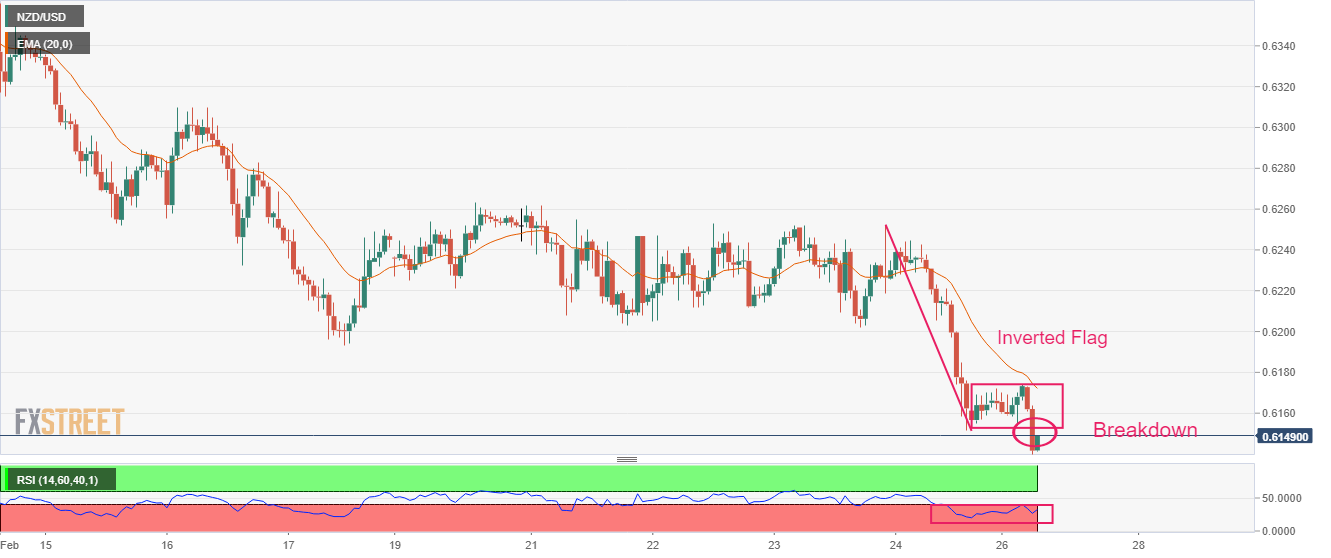
NZD/USD has delivered a breakdown of the Inverted Flag chart pattern formed on an hourly scale. A breakdown of the inventory distribution part of the Inverted Flag chart pattern indicates that the transfer of inventory from the institutional investors to the retail participants is over.
The 20-period Exponential Moving Average (EMA) at 0.6173 is barricading the New Zealand Dollar.
Meanwhile, Relative Strength Index (RSI) (14) is oscillating in the bearish range of 20.00-40.00, indicating a continuation of downside momentum.
Bank of Japan (BoJ) Governor designate Kazuo Ueda is speaking on Monday, endorsing the central bank’s ultra-loose monetary policy.
Key quotes
“CPI growth will slow below 2% in fiscal 2023.”
“It takes time for CPI to meet the 2% target sustainably and stably.”
“BoJ’s monetary easing causing various side-effects.“
“Appropriate to continue monetary easing from now on as well.”
“BoJ faces difficult situation no matter who becomes governor.”
“Definition of price stability is zero inflation.”
“The more inflation deviates from zero, the larger the cost becomes.”
Market reaction
USD/JPY has come under renewed selling pressure on Ueda’s comments, now losing 0.14% on the day to trade at 136.25.
Reserve Bank of New Zealand (RBNZ) Chief Economist Paul Conway said on Friday, “the OCR is expected to peak around mid-2023 at 5.50%”.
Additional quotes
“Spending by households is higher than expected.”
“As interest rates rise, I expect consumption to slow.”
“We are seeing signs that demand is beginning to soften.”
“Higher interest rates are still required to cool the economy.”
“Not aware of any changes proposed for lvr lending limits.”
- Gold price takes offers to renew intraday low, fades late Friday’s corrective bounce off two-month low.
- Lack of major data/events challenges market moves but hawkish central banks, recession woes keep XAU/USD bears hopeful.
- US Durable Goods Orders, ISM PMIs will be crucial for near-term directions.
Gold price (XAU/USD) takes offers to refresh a two-month low to around $1,808 during early Monday. In doing so, the bright metal seems to justify the latest pick-up in the US Dollar, after a week-start retreat, amid the hawkish concerns surrounding the US Federal Reserve (Fed) and the geopolitical fears.
That said, the US Dollar Index (DXY) renews its intraday high around 105.30 following the initial pullback from a seven-week high. In doing so, the greenback’s gauge versus the six major currencies remains firmer for the fifth consecutive day.
The DXY’s rebound from the intraday low could be traced to the firmer US Treasury bond yields as the US 10-year Treasury yields reverse the early-day losses of around 3.95%. Further, the two-year counterparts jump back towards the highest levels since November 2022, marked the previous day, as bond bears poke the 4.83% level by the press time.
Fears of Aussie recession and slower consumption in New Zealand, as well as fears of a soft landing in the US, seem to have underpinned the XAU/USD’s recent weakness. Adding strength to the precious metal’s downturn could be the hawkish Fed concerns, especially after the last week’s strong inflation clues and upbeat comments from the policymakers. It should be noted that the latest chatters surrounding more Western sanctions on Russia and the Beijing-Moscow ties seem to also favor the Gold bears.
It’s worth noting, however, that the S&P 500 Futures lick its wounds with mild gains after the Wall Street benchmark posted the biggest weekly slump of 2023.
Looking forward, the Gold price remains on the bear’s radar amid a firmer US dollar and geopolitical concerns. However, an absence of top-tier data might allow the XAU/USD to pare some losses. That said, the week’s US ISM Manufacturing PMI, Services PMI, Durable Goods Orders and China’s official PMIs will be crucial for the traders to watch for clear directions.
Gold price technical analysis
Although the oversold RSI (14) challenges Gold sellers around $1,810, the metal’s sustained trading within the three-week-old descending trend channel and bearish MACD signals keep the XAU/USD bears hopeful.
That said, a convergence of the 100-DMA and the stated channel’s lower line, close to $1,793, appears short-term key support to watch for the Gold bears.
Following that, the 200-DMA level surrounding $1,775 could act as the last defense of the Gold buyers.
Alternatively, XAU/USD recovery remains elusive unless the bullion stays inside the aforementioned channel, currently between $1,793 and $1,832.
Even if the Gold price remains firmer past $1,832, the February 09 swing high of around $1,890 and the $1,900 threshold could challenge the buyer afterward.
Overall, the Gold price remains on the bear’s radar but the downside room appears limited.
Gold price: Daily chart
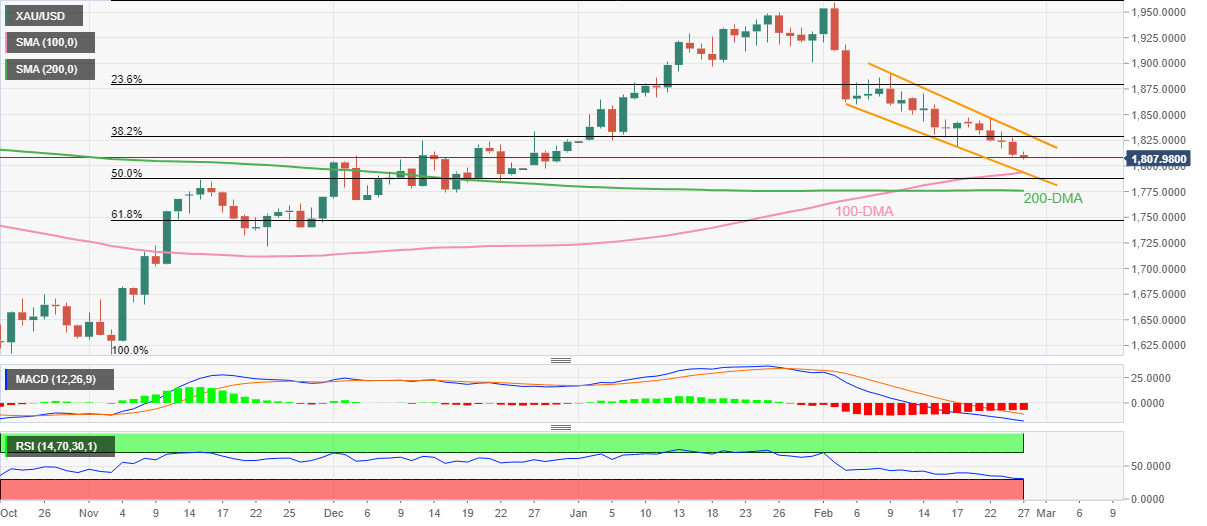
Trend: Limited downside expected
- EUR/USD has turned sideways as investors await US Durable Goods Orders data for fresh impetus.
- Rising wage offerings by US firms to acquire talent in a tight labor market has propelled households’ spending.
- A range shift move by the RSI (14) indicates that the downside momentum has been triggered.
The EUR/USD pair is displaying a lackluster performance around 1.0550 in the Asian session. The volatility in the major currency pair has squeezed after a sheer downside inspired by the surprise jump in the United States consumer spending data released on Friday.
Rising wage offerings by the US firms to acquire talent in a tight labor market have propelled households’ spending. This has triggered fears of a continuation of the policy tightening spree by the Federal Reserve (Fed). The US Dollar Index (DXY) is demonstrating a subdued performance around 104.80 and is awaiting the release of the US Durable Goods Orders data for fresh cues.
Thursday’s Doji formation was confidently broken by the market participants, which resulted in a trend continuation toward the downside. The Euro bulls are expected to find a cushion around the horizontal support plotted from 15 November 2022 high around 1.0482.
Downward-sloping 10-and 20-period Exponential Moving Averages (EMAs) at 1.0631 and 1.0381 respectively, adds to the downside filters.
The Relative Strength Index (RSI) (14) has displayed a range shift move from the 40.00-60.00 range to the bearish range of 20.00-40.00, which indicates that the downside momentum has been triggered.
For further downside, a breakdown of February 24 low at 1.0536 will drag the asset towards 15 November 2022 high around 1.0482 followed by 16 November 2022 high at 1.0439.
On the flip side, a recovery move above the round-level resistance at 1.06000 will drive the asset toward February 22 high at 1.0658. A break above February 22 high will expose the asset to February 20 high around 1.0700.
EUR/USD daily chart
 .
.
US National Security Advisor Jake Sullivan said on CNN’s “State of the Union,” China’s stance on the Russian invasion of Ukraine puts it in an “awkward” position internationally and any weapons support to Russia would come with “real costs.”
Additional comments
“The Biden administration doesn’t have evidence that China is giving “lethal support” to President Vladimir Putin’s war in Ukraine while seeking to warn Beijing of the risks.“
“When China talks rhetorically about the war in Ukraine, they tie themselves into knots, because they know that going all-in with Russia in this war is Ukraine would alienate a substantial number of countries that they are working hard to maintain good relations with.”
“This war presents real complications for Beijing.”
“And Beijing will have to make its own decisions about how to proceed, whether it provides military assistance. But if it goes down that road, it will come at real costs to China.”
Market reaction
The ongoing geopolitical tensions between the West and Russia over Ukraine and the alleged Chinese involvement in aiding Moscow continues to weigh on the investors’ sentiments. The AUD/USD pair, therefore, remains dragged down by geopolitical risks, despite a big jump in the Australian Company Gross Operating Profits for the final quarter of 2022. The pair is losing 0.08% on the day to trade at 0.6719, as of writing.
Economists at Goldman Sachs outlined their view on the Japanese Yen, in the face of the incoming Bank of Japan (BoJ) Governor Kazuo Ueda and hawskish Federal Reserve expectations.
Key quotes
“We have repeatedly said that US real rates should matter most.”
“The current market environment looks less favorable for significant dollar-yen downside, even in the case of a hawkish BOJ policy shift.”
“Expect the Bank of Japan March meeting will not bring anything substantive on policy change.”
“But this won't hinder speculation of some policy move from the BOJ after Kuroida departs in April and Ueda is ushered in as new governor. This will make the yen weakness limited.”
- USD/JPY takes offers to renew intraday low, reverses from 10-week high.
- Bond bears take a breather after an active week that propelled yields toward multi-day high.
- Fading hawkish concerns over BoJ Governor Nominee Ueda previously propelled Yen prices.
- Strong US inflation cues, hopes of higher Fed bets keep buyers hopeful.
- Ueda’s speech in Japan upper house, government declaration for BoJ board will be important for immediate clues.
USD/JPY consolidates the biggest daily gains in three weeks as it renews its intraday low near 136.00 while reversing from the highest levels in two months during early Monday. In doing so, the Yen pair traces the US Treasury bond yields ahead of the key announcements concerning the Bank of Japan (BoJ).
That said, the US 10-year Treasury yields print mild losses around 3.93% while the two-year counterpart retreat from the highest levels since November 2022 as bond traders flirt with 4.82% level at the latest.
It should be noted that the mixed concerns surrounding the incoming BoJ board seemed to have also challenged the USD/JPY buyers. Previously, the easing hawkish concerns about incoming Governor Kazuo Ueda propelled the Yen pair. However, mixed comments from the Deputy Governor Nominees, namely Ryozo Himino and Shinichi Uchida, seemed to have probed the dovish bias surrounding the Japanese central bank afterward.
On the other hand, strong US inflation cues and hawkish Fed concerns favored the USD/JPY buyers previously. That said, the US Dollar Index (DXY) marked the biggest weekly jump since September 2022 in the last week as strong prints of the Fed’s preferred inflation gauge, namely the Core Personal Consumption Expenditures (PCE) Price Index marked an impressive run-up. The same line allowed the Fed policymakers to reiterate their hawkish bias and underpin the market’s bets for higher Federal Reserve (Fed) rates.
Other than the US data and yields, the geopolitical fears surrounding Russia and China also propel the DXY and probe the USD/JPY pair’s latest weakness.
Amid these plays, S&P 500 Futures remain indecisive even as Wall Street benchmarks posted the biggest weekly fall in 2023. That said, the US two-year Treasury bond yields rose to the highest levels since early November 2022, staying mostly unchanged at the latest.
That said, USD/JPY pair remains on the buyer’s radar despite the latest pullback from the multi-day top. However, any hawkish comments from BoJ Governor Nominee Ueda may help extend the Yen pair’s latest downside. That said, Ueda is up for a speech in the Japanese Upper House around 04:10 GMT.
Technical analysis
A two-month-old ascending resistance line restricts immediate USD/JPY run-up around 136.50 ahead of convergence of the 100-DMA and the 200-DMA, around 137.10-15.
The economy will rebound in 2023 as epidemic prevention is relaxed and consumption improves, the People’s Bank of China (PBOC) revealed in its Q4 2022 monetary report.
Additional takeaways
“This year's monetary policy should be precise and strong, and not only focus on supporting the expansion of domestic demand, but also take into account longer-term economic growth and price stability.”
“Authorities will adhere to a managed floating exchange rate system based on market supply and demand, and guide funds into areas such as inclusive finance, technological innovation, and green development.”
Market reaction
AUD/USD is off the low but remains confined within a tight range below 0.6750 at the start of the week. The pair is up 0.19% on the day.
| Raw materials | Closed | Change, % |
|---|---|---|
| Silver | 20.751 | -2.66 |
| Gold | 1811.59 | -0.59 |
| Palladium | 1404.27 | -2.78 |
- AUD/USD prints mild gains around seven-week low, grinds near intraday high of late.
- Convergence of 100-DMA, three-month-old ascending support line restricts immediate downside amid nearly oversold RSI conditions.
- 200-DMA, three-week-old descending trend line challenge recovery moves amid bearish MACD signals.
AUD/USD licks its wounds while printing mild gains around 0.6735-40, bouncing off a seven-week low during early Monday’s sluggish session.
In doing so, the Aussie pair rebounds from a convergence of the 100-DMA and an upward-sloping support line from late November 2022. The corrective move also justifies the nearly oversold RSI (14).
However, the recovery remains elusive unless providing a daily closing beyond the 200-DMA hurdle of 0.6800.
Following that, a downward-sloping resistance line from February 02, close to 0.6850 at the latest, acts as the last defense of the AUD/USD bears, a break of which could propel prices towards the 0.7000 round figure.
Should the Aussie pair buyers keep the reins past 0.7000, tops marked during the mid-February, as well as the monthly high, surrounding 0.7030 and 0.7160 in that order, could lure the upside momentum.
Meanwhile, a daily closing below 0.6730 could quickly drag AUD/USD toward a late December 2022 low near 0.6630. However, lows marked during November 21 and 11, around 0.6585 and 0.6575 could challenge the bears afterward.
Overall, AUD/USD is likely to witness further downside unless marking a sustained break of 0.6850.
AUD/USD: Daily chart
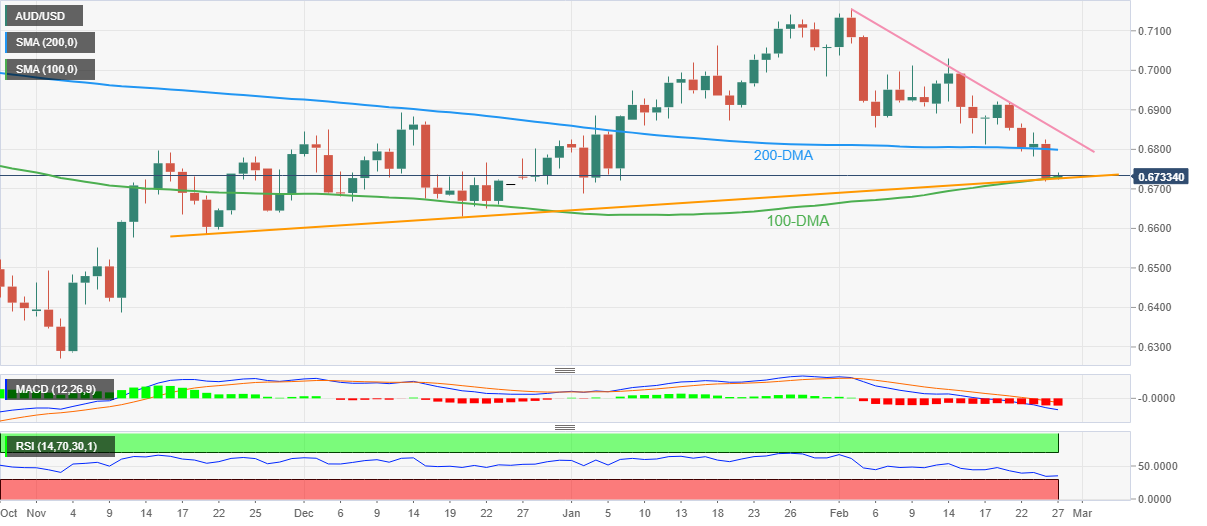
Trend: Limited recovery expected
- WTI prints mild losses to probe the previous rebound from three-week low.
- Russia’s halt of Oil supplies to Poland joins more Western sanctions on Moscow to highlight geopolitical woes.
- US SPR woes challenge energy buyers amid hawkish central bank concerns.
WTI crude oil fades the previous weekly rebound as it retreats to $76.50 while printing mild losses during early Monday. In doing so, the black gold struggles to justify geopolitical fears emanating from Russia, as well as fail to cheer a pullback in the US Dollar, amid hawkish central bank concerns.
That said, Politico reports fresh sanctions on Russia from the US and the UK, as well as the European Union (EU states) after a clash between Poland and Italy held up the process for days. On the other hand, Reuters came out with the news suggesting Russia’s halting of oil flow to Poland via the Druzhba pipeline.
It should be noted that the recently firmer statistics from the developed economies allowed their respective central banks to defend the hawkish bias and suggest more rate hikes, even as recession fears loom. The same challenges the energy prices amid fears of low demand in the future.
Also weighing on the energy prices could the US President Joe Biden’s readiness to ease control of the Strategic Petroleum Reserves (SPR) to tame the oil shortage.
Additionally, the US Dollar’s strength exerts downside pressure on the energy benchmark, despite the latest pullback from the seven-week high.
Moving on, the weekly Oil inventory numbers from the American Petroleum Institute (API) and the Energy Information Administration (EIA) could entertain Oil traders but major attention will be given to the risk catalysts for clear directions. That said, the chatter surrounding the hidden alliance between Russia and China could keep Oil buyers hopeful.
Technical analysis
A daily closing beyond a two-week-old descending resistance line, around $27.30 by the press time, becomes necessary for the WTI crude oil buyers to keep the reins.
Reuters has reported that ''more than 60% of British businesses are optimistic about the country's economic growth in the medium term and their own revenues in the next few years, a survey showed on Monday, challenging some of the gloomy forecasts for the UK economy.''
The poll state that about 61% of over 1,500 business leaders expect economic growth to be "somewhat or significantly better" in 2025, according to the Boston Consulting Group Centre for Growth's inaugural business survey.
''Some 63% also think their revenues will grow over the next three years.''
Reutees note that ''the Bank of England said this month that Britain's weak productivity growth means the economy can probably only grow by about 0.7% a year in 2024 and 2025 without generating inflationary heat. It also forecast a recession starting in early 2023 and lasting into early 2024.''
"It is easy to get downbeat about the UK's prospects both in the short and medium term but those running our businesses tend to be more optimistic," Raoul Ruparel, director for the BCG Centre for Growth, said. "UK businesses are undoubtedly feeling squeezed, but they're still standing."
GBP/USD update
GBP/USD held steady on Friday with an improvement in UK consumer sentiment, but the currency was still headed for its first monthly drop since September as the US Dollar firms. GBP/USD is up 0.2% at the start of the week to 1.1960.
''British consumers have become more optimistic about their personal finances and the outlook for the economy, but their mood is a long way below where it was prior to the COVID-19 pandemic, market research firm GfK said on Friday,'' Reuters reported.
- USD/CAD stays pressured around intraday low after reversing from multi-day high.
- RSI pullback favors latest retreat in Loonie prices toward two-week-old ascending support line.
- Bullish MACD signals, hawkish fundamentals challenge downside bias.
- Buyers have a bumpy road to witness on their return.
USD/CAD holds lower grounds near the intraday bottom surrounding 1.3590 during the mid-Asian session on Monday, extending the previous day’s U-turn from a seven-week high.
The Loonie pair’s latest weakness could be linked to the overbought conditions of the RSI (14), as well as a failure to provide a daily closing beyond the January 06 swing high. The pullback moves also took clues from the downside break of the two-week-old previous resistance line.
However, bullish MACD signals and an upward-sloping support line from February 14, close to 1.3570 by the press time, challenges the USD/CAD bears.
If the Loonie pair bears manage to conquer the stated support, the odds of witnessing a quick slump towards the 61.8% Fibonacci retracement level of the pair’s moves from the mid-December 2022 to early February, around 1.3535, can’t be ruled out.
Though, the late January swing high near 1.3520 and multiple tops marked during late January and early February, near 1.3480-70, could probe the USD/CAD sellers afterward.
Meanwhile, the upward-sloping resistance line from February 09, close to 1.3620 at the latest, guards the USD/CAD pair’s immediate upside.
Following that, horizontal lines comprising tops marked since early January and late December 2022, respectively near 1.3665 and 1.3685, becomes crucial for the bulls to watch for clear directions.
USD/CAD: Four-hour chart
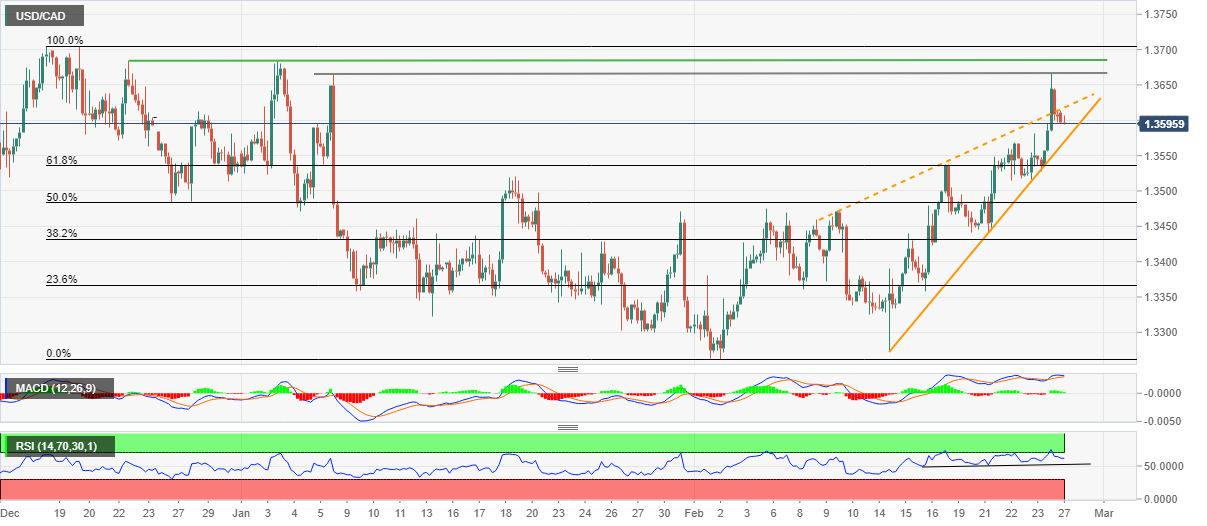
Trend: Limited downside expected
- EUR/JPY bulls are attempting to crack the upper quarter of 143s.
- The Euro is benefiting due to the central bank divergence.
EUR/JPY is lower at the start of the week, down some 0.12% and has been pressured to a low of 143.69 so far having slipped from a high of 144.07. Hotter-than-expected data has helped the US Dollar to strengthen against many of its major peers this week, leaving the crosses somewhat in consolidation.
EUR/JPY remains between familiar range boundaries although the upside has been in play for the most part as traders aim to break into the 144s. The divergence between the central banks has been supporting the Euro over of the Yen with European Central Bank last hiking hawkishly, as it all but confirms a third 50bp hike in March. ''Although the ECB may slow down after next month, Lagarde signalled that March will not mark the final hike. We have raised our forecast accordingly,'' analysts at Rabobank explained. ''We expect a 50bp hike in March, followed by two 25bp hikes in Q2 to a terminal rate of 3.50%.''
As for the Bank of Japan, the incoming Governor has not been ruffling too many market feathers. He thinks the right path forwards is to continue monetary easing while devising ways to respond to the current situation, Jit Juckes at Societe Generale said.
''In other words, we should expect more tinkering with yield curve control, but not tighter monetary policy. Yen bulls got no help from Mr Ueda, nor did they get any from the latest weekly securities flow data. The only thing preventing USD/JPY from continuing to retrace towards 140 is the dip in Treasury yields yesterday.''
- EUR/GBP is awaiting the outcome of UK-EU discussions over the Brexit deal for fresh impetus.
- ECB Lagarde confirmed a continuation of the policy tightening spell of 50 bps amid an absence of supportive fiscal policy.
- The German economy has shrunk by 0.4% in the fourth quarter of 2022 as stick inflation has weighed on households’ spending.
The EUR/GBP pair is displaying volatile moves around 0.8830 in the Tokyo session ahead of the potential Brexit deal. The cross is expected to hit the critical resistance of 0.8830 as the European Central Bank (ECB) President Christine Lagarde is reiterating the need of hiking rates further by 50 basis points (bps) to tame persistent inflation.
ECB Lagarde confirmed a continuation of the policy tightening spell of 50 bps for March monetary policy amid an absence of supportive fiscal policy. She added, ''We will do more hikes if necessary to return inflation to our target of 2% in a timely manner,” as reported in the Economic Times.
Little strength in the Euro against the Pound Sterling could be faded as the German economy has contracted in the fourth quarter of CY2022. It seems that inflationary pressures and the energy crises have weighed on German economic prospects. The German economy has shrunk by 0.4% and investors are worried that one more contraction would signal a recession.
Carsten Brzeski, ING's global head of macro, cited “The second consecutive drop in the Ifo's current assessment component, a falling manufacturing PMI, weak consumer confidence and a willingness to spend close to historical lows, all point to a contraction of the German economy once again in the first quarter.”
On the United Kingdom front, investors are keenly awaiting the Brexit deal. The discussions between United Kingdom Prime Minister (PM) Rishi Sunak and European Commission (EC) President Ursula von der Leyen are expected to materialize positively.
British Deputy Prime minister Dominic Raab told BBC “The UK ‘is on the cusp’ of securing a new Brexit deal on Northern Ireland.”
In recent trade today, the People’s Bank of China (PBOC) set the yuan at 6.9572 vs. the last close of 6.9630.
About the fix
China maintains strict control of the yuan’s rate on the mainland.
The onshore yuan (CNY) differs from the offshore one (CNH) in trading restrictions, this last one is not as tightly controlled.
Each morning, the People’s Bank of China (PBOC) sets a so-called daily midpoint fix, based on the yuan’s previous day's closing level and quotations taken from the inter-bank dealer.
- GBP/USD prints mild intraday gains after two-week downtrend.
- Optimism surrounding EU-UK Brexit deal on NI protocol lures buyers ahead of today’s official announcements.
- Fears of Conservatives’ walkout, workers’ strikes keep Cable bears hopeful.
- US data bolsters Fed bets and underpin US Dollar strength, geopolitical woes also strengthen the greenback.
GBP/USD picks up bids to refresh intraday high near 1.1955, printing mild intraday gains during Monday’s mid-Asian session after declining in the last two consecutive weeks. In doing so, the Cable pair cheers the upbeat headlines surrounding Brexit, as well as the US Dollar’s retreat amid an inactive session. However, the cautious mood ahead of today’s key announcements keeps the quote on the dicey floor.
During the weekend, Deputy Prime minister Dominic Raab told BBC’s Laura Kuenssberg that the UK ‘is on the cusp’ of securing a new Brexit deal on Northern Ireland. The policymaker also mentioned that the government had made ‘great progress’ negotiating with the European Union.
On the same line, The Times reports that UK Prime Minister Rishi Sunak may have obtained significant concessions in a looming Brexit deal.
It should be noted that an upbeat survey release from Boston Consulting Group Centre for Growth also allows the GBP/USD pair to remain firmer. “More than 60% of British businesses are optimistic about the country's economic growth in the medium term and their revenues in the next few years,” the survey showed on Monday per Reuters.
Alternatively, the ongoing workers’ strikes in the UK join the fears of the Conservatives’ walkout from the compromised Brexit deal to challenge the latest optimism.
However, strong US inflation cues and hawkish Fed concerns challenge the GBP/USD buyers. That said, the US Dollar Index (DXY) marked the biggest weekly jump since September 2022 in the last as strong prints of the Fed’s preferred inflation gauge, namely the Core Personal Consumption Expenditures (PCE) Price Index marked an impressive run-up. The same line allowed the Fed policymakers to reiterate their hawkish bias and underpin the market’s bets for higher Federal Reserve (Fed) rates.
Other than the hawkish Fed concerns, geopolitical fears surrounding Russia and China also propel the DXY and probe the GBP/USD pair’s recovery moves.
Against this backdrop, S&P 500 Futures remain indecisive even as Wall Street benchmarks posted the biggest weekly fall in 2023. That said, the US two-year Treasury bond yields rose to the highest levels since early November 2022, staying mostly unchanged at the latest.
Looking forward, UK PM Sunak and European Commission President Ursula von der Leyen’s announcement of a new Brexit deal for Northern Ireland will be crucial for the GBP/USD traders to watch.
Technical analysis
A daily closing below the seven-week-old ascending support line, around 1.1930 by the press time, becomes necessary for the GBP/USD bears to keep the reins.
- Gold price is expected to continue its four-day losing streak amid hawkish Fed bets.
- Investors should be prepared for a surprise rise in US Durable Goods Orders as the households' demand has accelerated lately.
- Gold price is trading in a Falling Channel chart pattern in which every pullback is considered a selling opportunity.
Gold price (XAU/USD) is demonstrating a topsy-turvy auction around $1,810.00 in the Asian session. The precious metal is expected to continue its four-day losing streak after surrendering the immediate support of $1,809.00 as Federal Reserve (Fed) policymakers see interest rates above 5% after January’s hot inflation data..
Cleveland Fed Bank President Loretta Mester cited “Will need to go above 5% funds rate, stay there for a while.” He further added, “Data shows inflation not yet on trend to get back sustainably to 2% target.”
An escalation in the United States Personal Consumption Expenditure (PCE) price index by 0.6% in January has cleared that it would be early announcing victory for the battle against inflation. A strong labor cost index has propelled consumer spending, which could result in a recovery in the Producer Price Index (PPI) ahead.
The US Dollar Index (DXY) is struggling to continue the upside move toward the 105.00 resistance. S&P500 futures are showing nominal gains after a bearish Friday, portraying a sheer drop in the risk appetite of the market participants. The return delivered on 10-year US Treasury bonds has dropped marginally below 3.94%.
Going forward, the Gold price will display action post the release of the US Durable Goods Orders (Jan) data. The street is expecting a contraction of 4% lower than the expansion of 5.6% released earlier. Investors should be prepared for a surprise rise as the households' demand has accelerated lately.
Gold technical analysis
Gold price is trading in a Falling Channel chart pattern in which every pullback is considered as a selling opportunity before a reversal move. The yellow metal is expected to find resistance around $1,820.00 after a minor pullback move.
The 50-period Exponential Moving Average (EMA) at $1,833.80 is acting as a major barricade for the Gold bulls.
The Relative Strength Index (RSI) (14) is oscillating in the bearish range of 20.00-40.00, which advocates further downside.
Gold hourly chart

- NZD/USD's 0.6200 guards a move higher with 0.6270 and 0.6300 eyed thereafter.
- Bears are lurking near 0.6200 as a key resistance area.
NZD/USD has tried to stabilise at the start of the week from a low of 0.6154 and has come up as high as 0.6168 so far in what could be the makings of a bullish correction for the opening balance.
On Friday, the US Dollar surged following the US inflation gauge that was stronger than expected. The core PCE deflator data as being the Federal Reserve's preferred measure of inflation resulted in investors to price in a 5.4% peak in the fed funds rate. This has seen the greenback move into corrective territories as follows:

Should the greenback tail off, then the Kiwi would be expected to move higher. The following shows the prospects of a retracement into the prior support that could act as a resistance on a re-test:

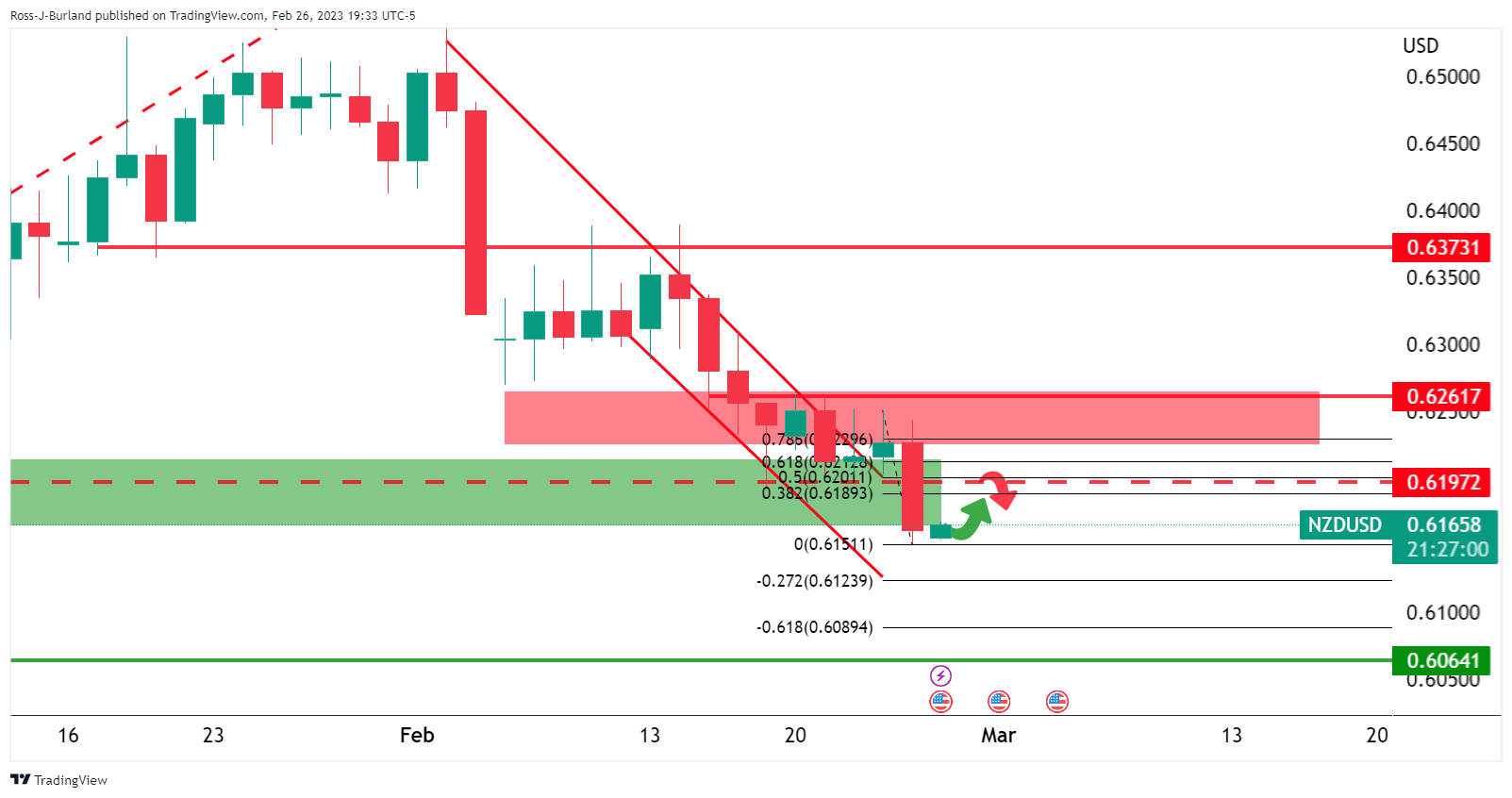
0.6200 guards a move higher and should the bears commit here, then a downside extension is feasible for the week ahead. However, a move beyond 0.6200 opens risk of a test into 0.6270 and 0.6300 thereafter.
- EUR/USD struggles for clear directions as it seesaws near the lowest levels in seven weeks.
- ECB’s Lagarde suggests more rate hikes; EU sanctions on Russia add to the bearish bias.
- US inflation cues propel hawkish Fed concerns, allowing DXY to post the biggest weekly gains since September 2022.
EUR/USD dribbles around mid-1.0500s as the European Central Bank (ECB) hawks jostle with the hopes of higher Federal Reserve (Fed) rates during early Monday. In doing so, the major currency pair seesaws around the lowest levels in seven weeks after posting the biggest weekly loss since September 2022.
During the weekend, ECB President Christine Lagarde said, “ECB must make sure inflation returns to 2%,” during an interview with Helsingin Sanomat. On the same line, ECB policymaker and Bundesbank Chief Joachim Nagel said on Friday, he “can't rule significant further rate hikes after March.”
It should be noted that the previous weekly releases of the Eurozone inflation numbers have also tried to recall the EUR/USD buyers. However, the comparatively stronger US data and hawkish Fed comments seemed to have gained more attention and hence drowned the quote. Also adding strength to the downside bias were the geopolitical concerns surrounding Russia and China.
Friday’s US Personal Consumption Expenditures (PCE) gained major attention as the headline PCE Price Index rose to 5.4% YoY versus 5.3% prior and 4.9% market forecasts. Further, the more relevant Core PCE Price Index, known as Fed’s favorite inflation gauge, rose to 4.7% YoY, compared 4.6% prior and analysts' forecast of 4.3%.
Talking about the Fed commentary, Cleveland Fed President Loretta Mester told CNBC on Friday that his funds' rate was above the median in December and still thinks they need to be somewhat above 5%. The policymaker also added that inflation risks still tilted to the upside. Following the suit was Federal Reserve Bank of Boston President Susan Collins who said, “More rate hikes needed to deal with 'too high' inflation.” Furthermore, Governor Philip Jefferson said, “Wage growth in the US is running too high to be consistent with a timely and sustainable return to the Federal Reserve's 2% inflation objective.”
With this, the latest read of the FEDWATCH tool, market players price a year-end effective fed funds rate at 5.3%, versus 5.1% signaled by the US central bank in its December meeting.
Elsewhere, Politico reports fresh sanctions on Russia from the US and the UK, as well as the European Union (EU states) after a clash between Poland and Italy held up the process for days.
On the other hand, Reuters came out with the news suggesting Russia’s halting of oil flow to Poland via the Druzhba pipeline.
Amid these plays, S&P 500 Futures remain indecisive even as Wall Street benchmarks posted the biggest weekly fall in 2023. That said, the US two-year Treasury bond yields rose to the highest levels since early November 2022, staying mostly unchanged at the latest.
To sum up, a battle between the hawks of the ECB and the Fed keeps the EUR/USD on the dicey floor. However, geopolitical concerns favor the bears.
Technical analysis
Given the nearly oversold RSI (14), the EUR/USD bears are likely to rest near the 11-week-old ascending support line, close to 1.0545 by the press time. Also adding to the downside filters is the 200-bar Exponential Moving Average (EMA) level surrounding 1.0530. The recovery moves, however, remain elusive below the two-week-old descending resistance line, close to 1.0615 at the latest.
| Index | Change, points | Closed | Change, % |
|---|---|---|---|
| NIKKEI 225 | 349.16 | 27453.48 | 1.29 |
| Hang Seng | -341.31 | 20010.04 | -1.68 |
| KOSPI | -15.48 | 2423.61 | -0.63 |
| ASX 200 | 21.6 | 7307 | 0.3 |
| FTSE 100 | -29 | 7878.7 | -0.37 |
| DAX | -265.95 | 15209.74 | -1.72 |
| CAC 40 | -130.16 | 7187.27 | -1.78 |
| Dow Jones | -336.99 | 32816.92 | -1.02 |
| S&P 500 | -42.28 | 3970.04 | -1.05 |
| NASDAQ Composite | -195.46 | 11394.94 | -1.69 |
| Pare | Closed | Change, % |
|---|---|---|
| AUDUSD | 0.67264 | -1.15 |
| EURJPY | 143.881 | 0.84 |
| EURUSD | 1.0549 | -0.42 |
| GBPJPY | 162.945 | 0.69 |
| GBPUSD | 1.19468 | -0.57 |
| NZDUSD | 0.6166 | -0.97 |
| USDCAD | 1.36076 | 0.48 |
| USDCHF | 0.94068 | 0.83 |
| USDJPY | 136.393 | 1.27 |
- Silver price remains pressured at the lowest levels in three months.
- RSI conditions limit immediate downside near three-week-old descending trend line.
- Descending megaphone formation suggests more volatility towards the south.
- Recovery remains elusive unless crossing 100-SMA.
Silver price (XAG/USD) takes offers to reverse the week-start corrective bounce off the three-month low during the mid-Asian session on Monday. In doing so, the bright metal pokes the key $20.75-70 zone, the lowest since late November 2022, as the oversold RSI (14) probes the quote’s further downside.
However, a downward-sloping megaphone trend-widening chart formation, stretching from early February, joins the bearish MACD signals to keep XAG/USD sellers hopeful.
That said, the bullion’s further downside could aim for the November 21, 2022 swing low of $20.58 before challenging the stated megaphone’s lower line, close to $20.55 at the latest.
Though, the RSI conditions and the aforementioned $20.55 trend line support may restrict the commodity’s further downside.
Alternatively, a three-day-old descending resistance line, near $21.00, restricts immediate recovery moves of the Silver price.
Following that, the stated megaphone’s top line, around $21.80 by the press time, could challenge the XAG/USD buyers.
It’s worth noting, however, that the metal’s upside remains doubtful unless crossing the 100-SMA level surrounding $21.90.
Also acting as an upside filter is the previous weekly top of near $22.00, a break of which could direct the buyers towards the November 2022 high of $22.25.
Overall, the Silver price remains bearish but the downside appears limited amid oversold RSI conditions.
Silver price: Four-hour chart
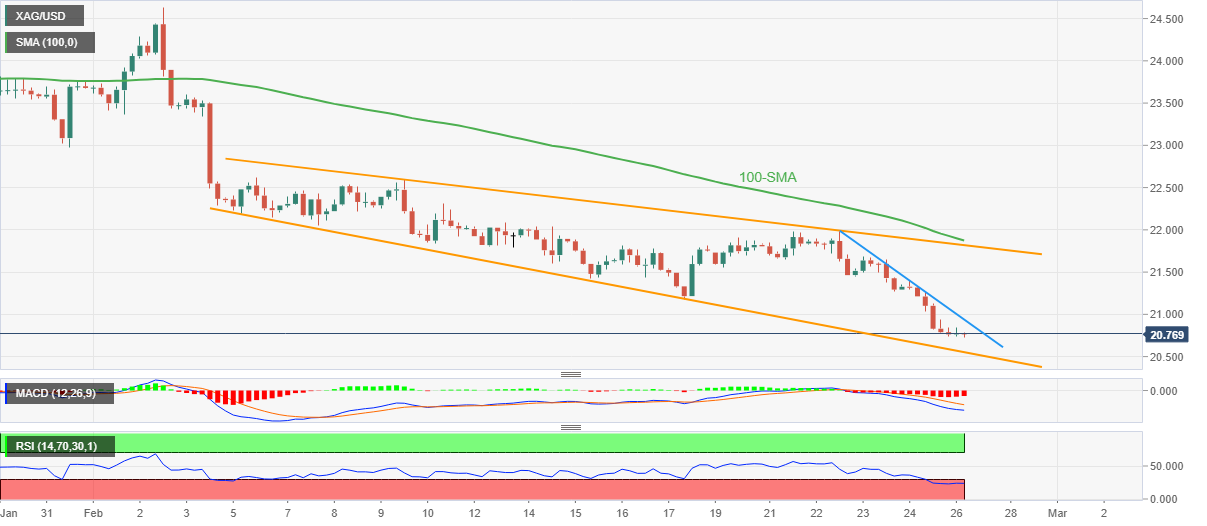
Trend: Further downside expected
- GBP/JPY is displaying a sideways auction ahead of the new expected Brexit deal announcement.
- The Japanese Yen is losing its stance as BoJ Ueda seems follower of BoJ Governor Kuroda.
- Japan’s CPI is non-stick despite inflation rising to multi-decade highs as price pressures are fueled by international forces.
The GBP/JPY pair is facing hurdles in stretching the upside above 163.00 in the Asian session. The cross is expected to resume upside as investors are refraining from supporting the Japanese Yen, considering the fact the Bank of Japan (BoJ) Governor Nominee Kazuo Ueda is following the footprints of the BoJ Governor Haruhiko Kuroda.
BoJ Ueda cited in his Friday speech that current monetary policy is appropriate to keep propelling inflationary pressures. Despite reaching a multi-decade high, Japan’s Consumer Price Index (CPI) is non-sticky as inflation is fueled by international forces. The reason behind the accelerating price index in Japan is the higher import prices for fuel and food, not the domestic demand and wages, which should be at the first place to support inflation.
The successor of BoJ Kuroda didn’t provide any meaningful cues about the further stretch in the Yield Curve Control (YCC), which has put investors in a dilemma. The intention of Japan’s administration was to build a game plan with a novel BoJ leader of an exit from the decade-long monetary policy. However, a dovish commentary from BoJ Ueda trimmed long-term supportive bets for the Japanese Yen.
Going forward, BoJ Ueda will also deliver a speech on Monday, which will provide more light on the vision to maintain the Japanese Yen as a strong competitor against rival currencies.
Meanwhile, the Pound Sterling has turned sideways ahead of an expected Brexit deal announcement by United Kingdom Prime Minister (PM) Rishi Sunak and European Commission (EC) President Ursula von der Leyen. "The Prime Minister wants to ensure any deal fixes the practical problems on the ground, ensures trade flows freely within the whole of the UK, safeguards Northern Ireland’s place in our Union and returns sovereignty to the people of Northern Ireland," a statement from Sunak's office said per Reuters.
- USD/JPY bears are lurking and eye the 135.50s.
- The 135.50s guard 133.00 to the downside and a break of the trendline support.
Following the hotter-than-expected US data, the US Dollar index rallied through the 105.20s to a seven-week high and putting it on track to post its largest weekly gain since late September. In turn, USD/JPY rallied hard but it is now in a corrective territory as the following illustrates:
USD/JPY and DXY analysis

The US Dollar could be on the verge of a significant correction and that could well play out as follows in USD/JPY:
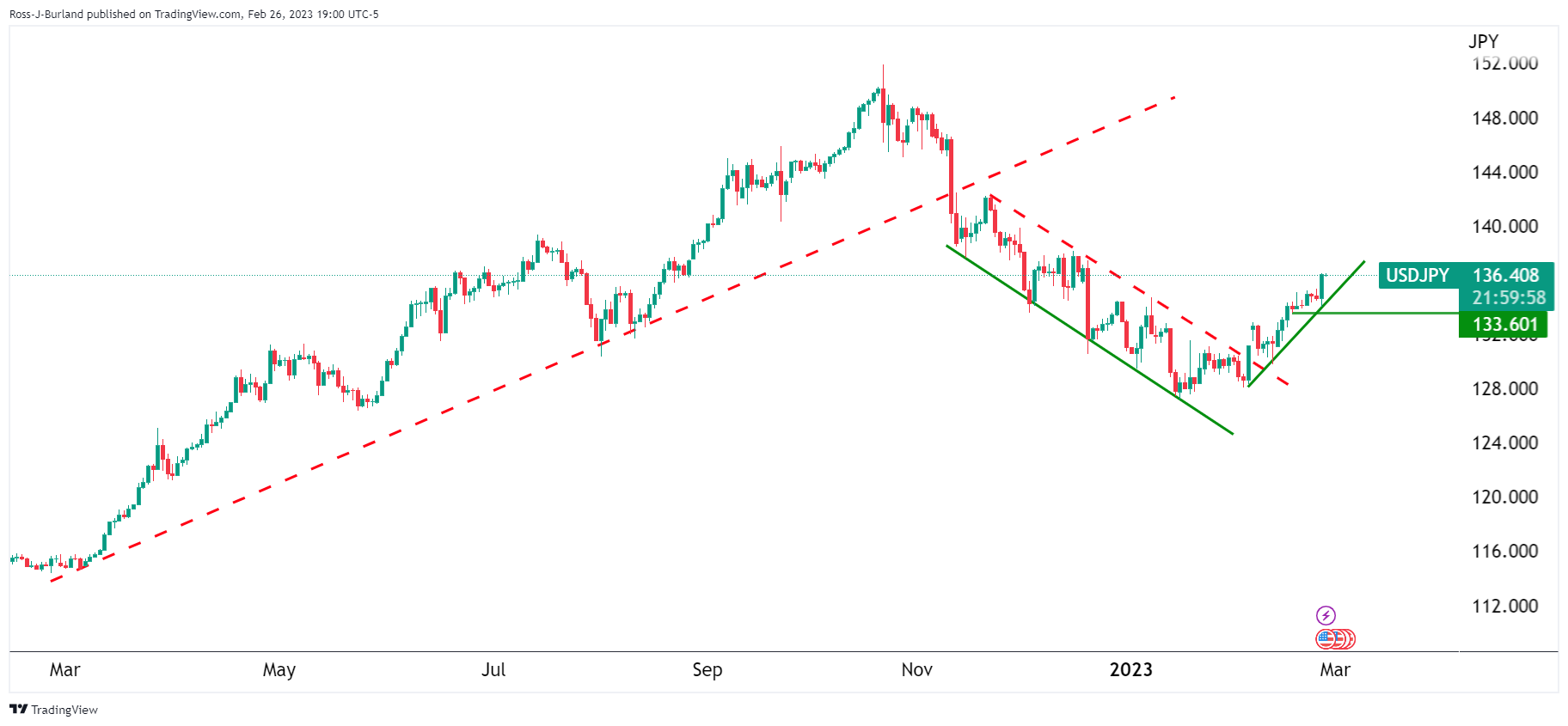
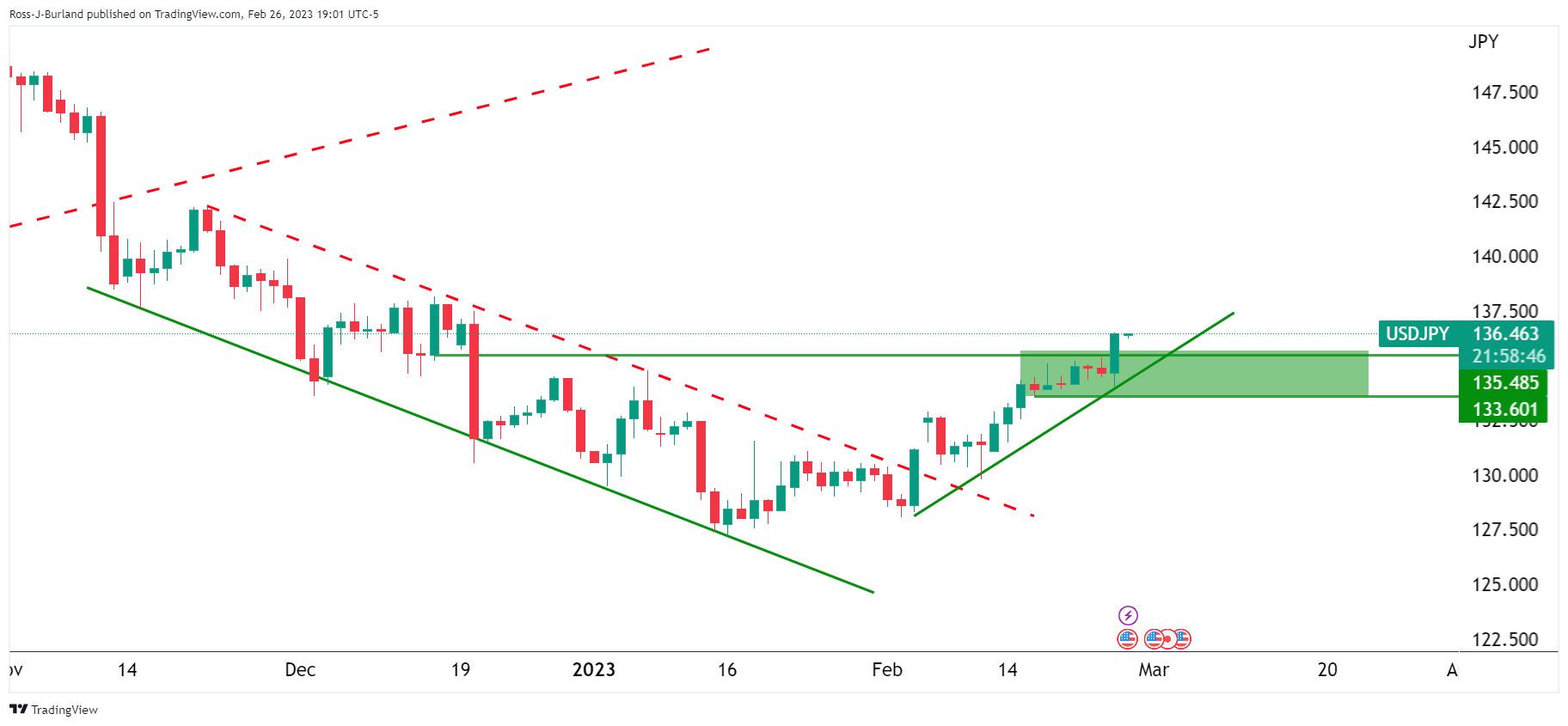
USD/JPY rallied on the final day of last week and has left the price vulnerable of a correction:
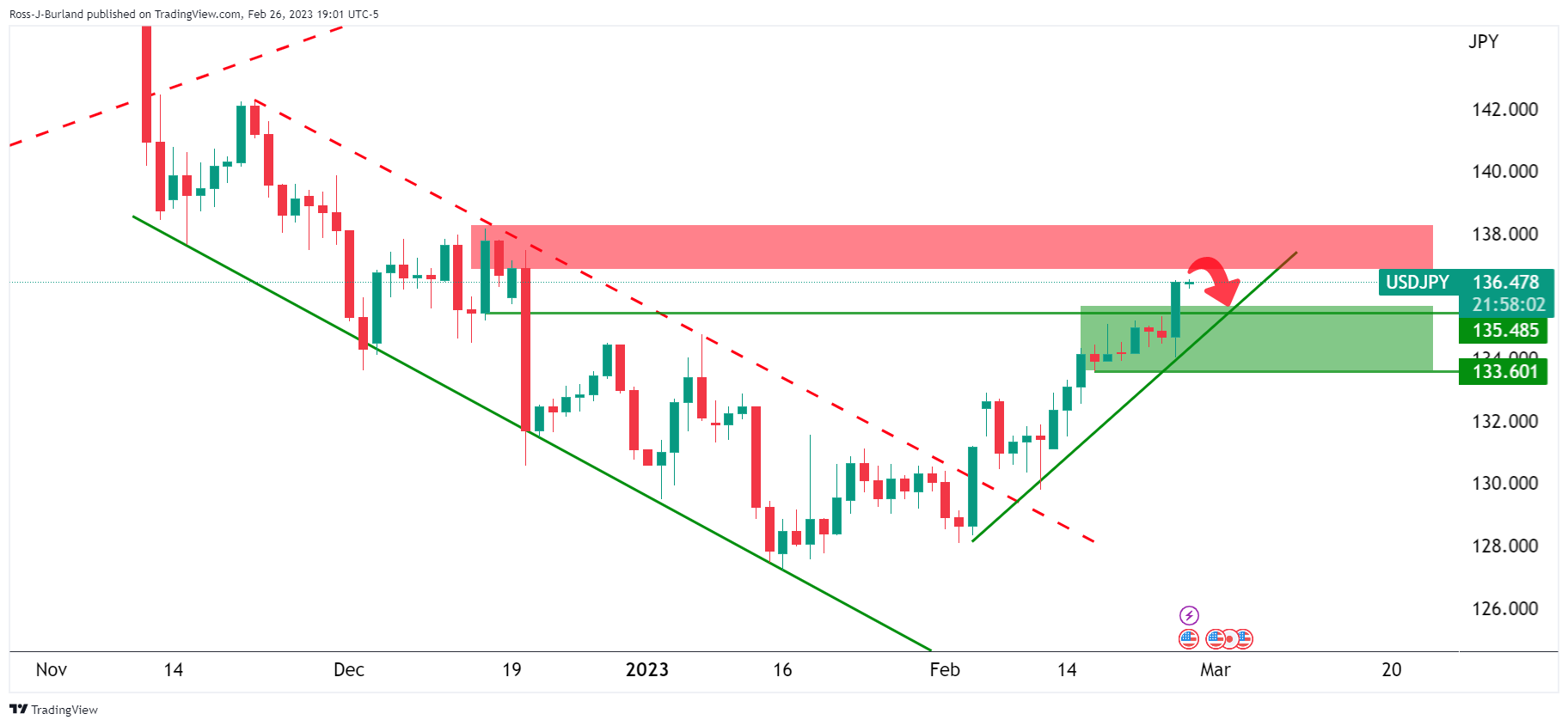
The 135.50s guard 133.00 to the downside and a break of the trendline support.
© 2000-2024. All rights reserved.
This site is managed by Teletrade D.J. LLC 2351 LLC 2022 (Euro House, Richmond Hill Road, Kingstown, VC0100, St. Vincent and the Grenadines).
The information on this website is for informational purposes only and does not constitute any investment advice.
The company does not serve or provide services to customers who are residents of the US, Canada, Iran, The Democratic People's Republic of Korea, Yemen and FATF blacklisted countries.
Making transactions on financial markets with marginal financial instruments opens up wide possibilities and allows investors who are willing to take risks to earn high profits, carrying a potentially high risk of losses at the same time. Therefore you should responsibly approach the issue of choosing the appropriate investment strategy, taking the available resources into account, before starting trading.
Use of the information: full or partial use of materials from this website must always be referenced to TeleTrade as the source of information. Use of the materials on the Internet must be accompanied by a hyperlink to teletrade.org. Automatic import of materials and information from this website is prohibited.
Please contact our PR department if you have any questions or need assistance at pr@teletrade.global.
















